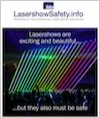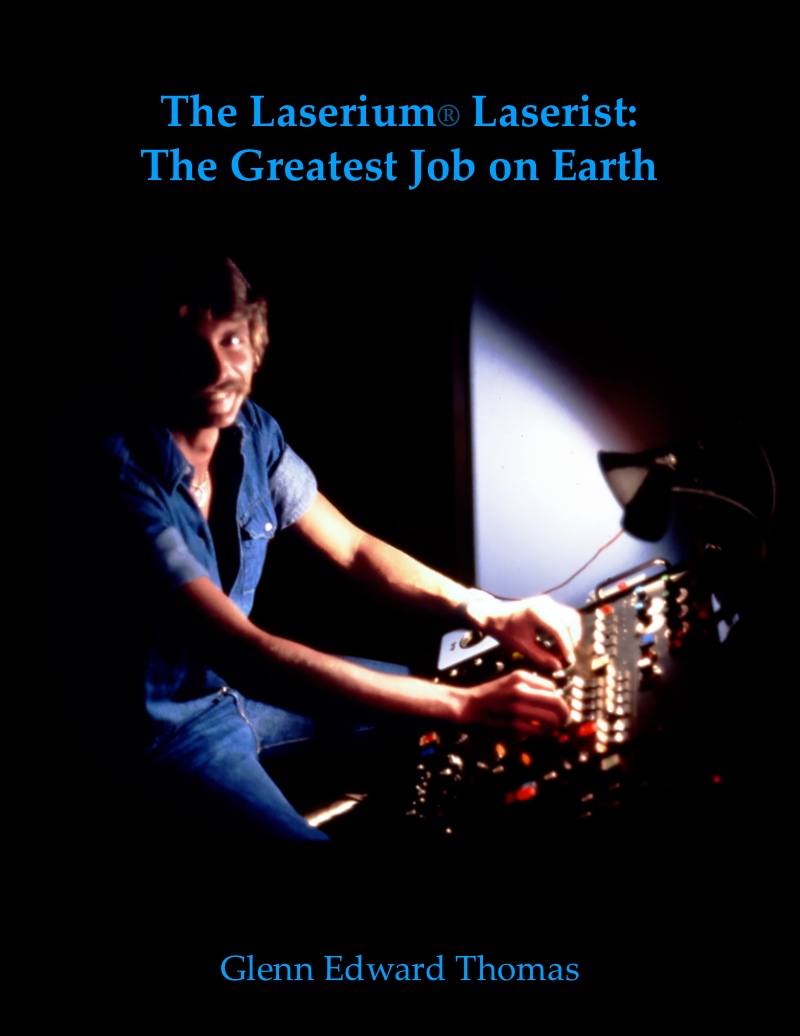
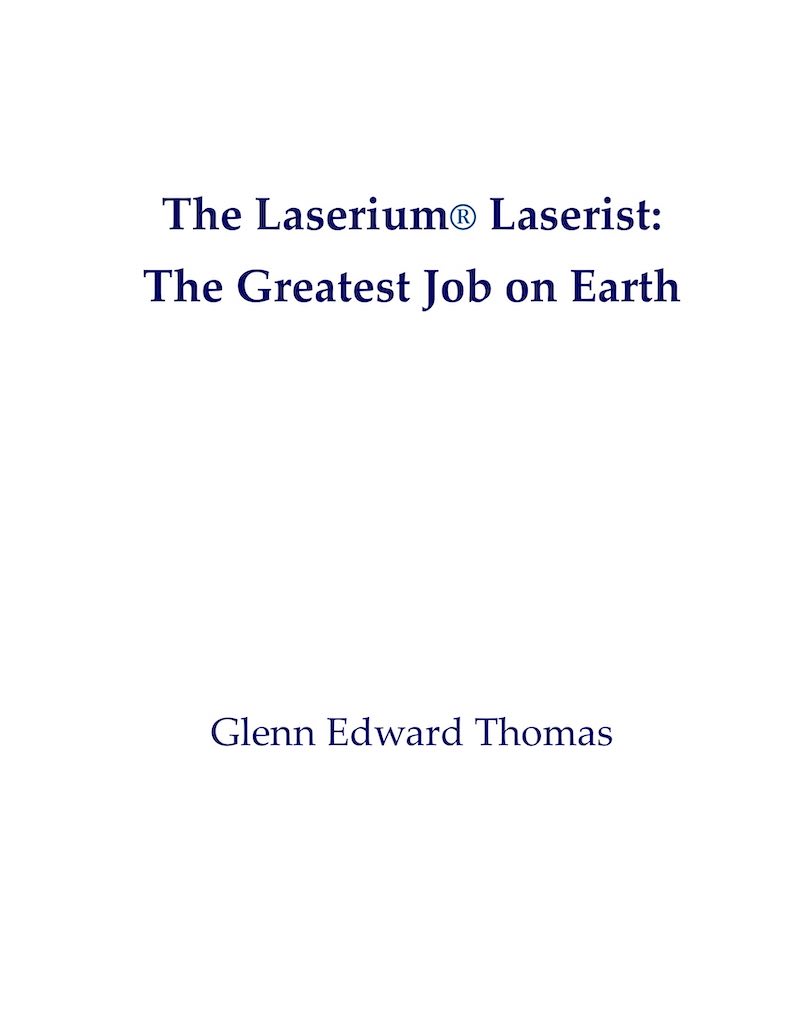
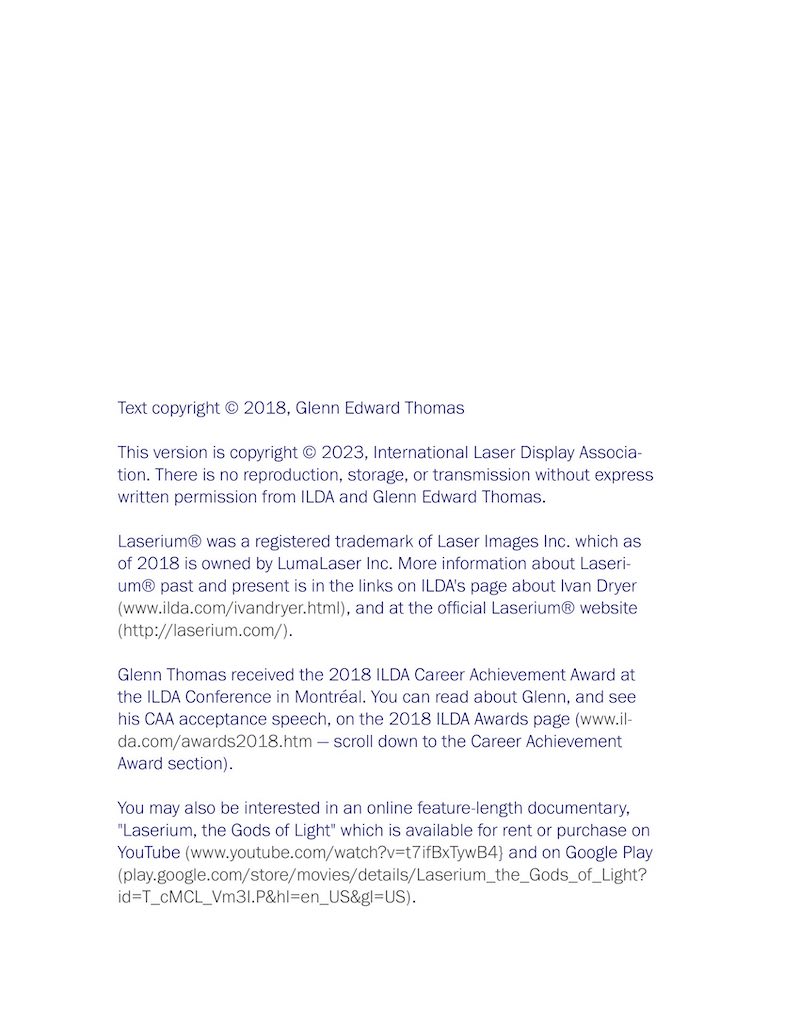
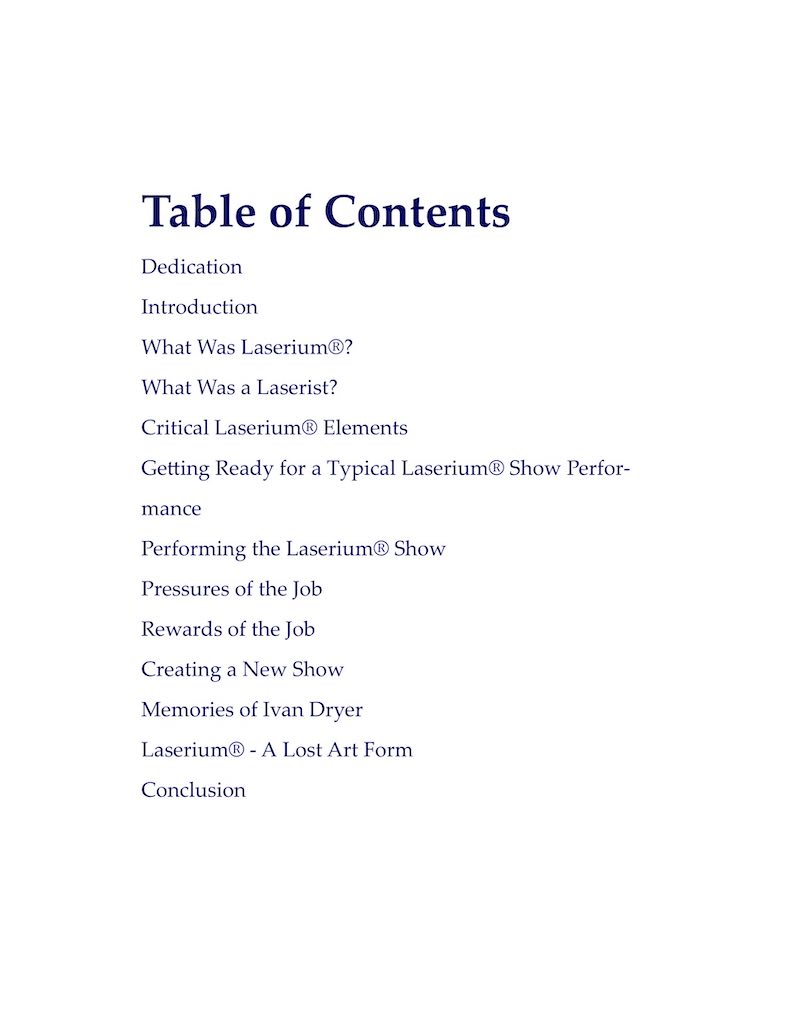
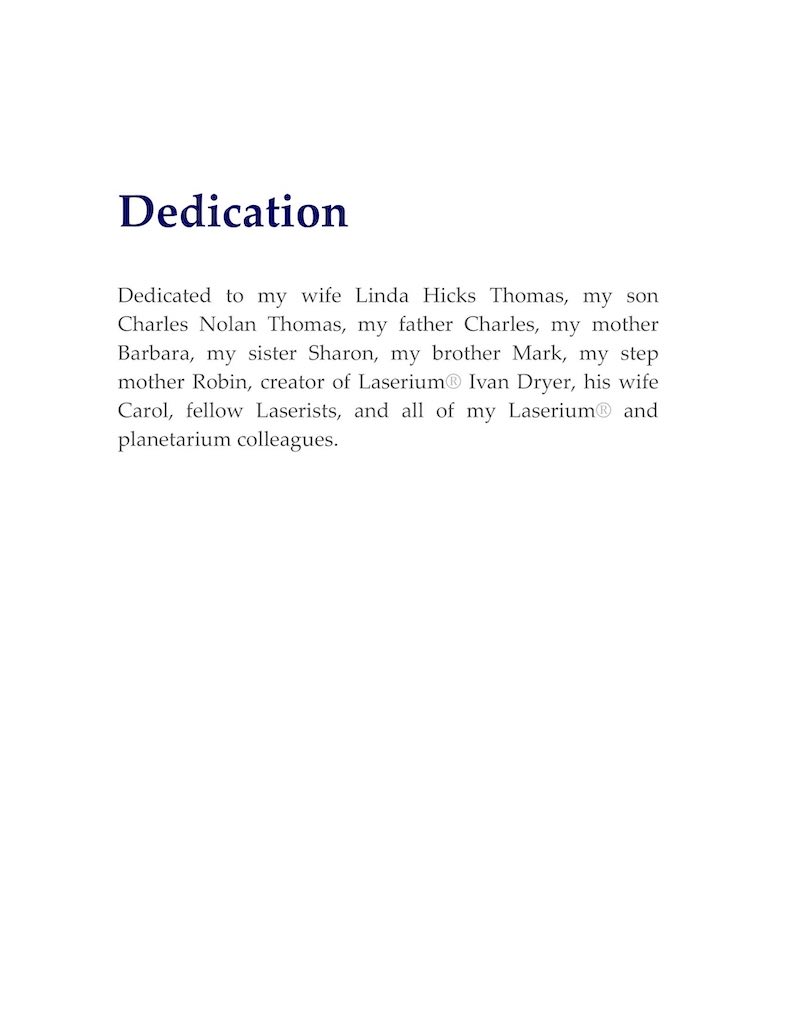
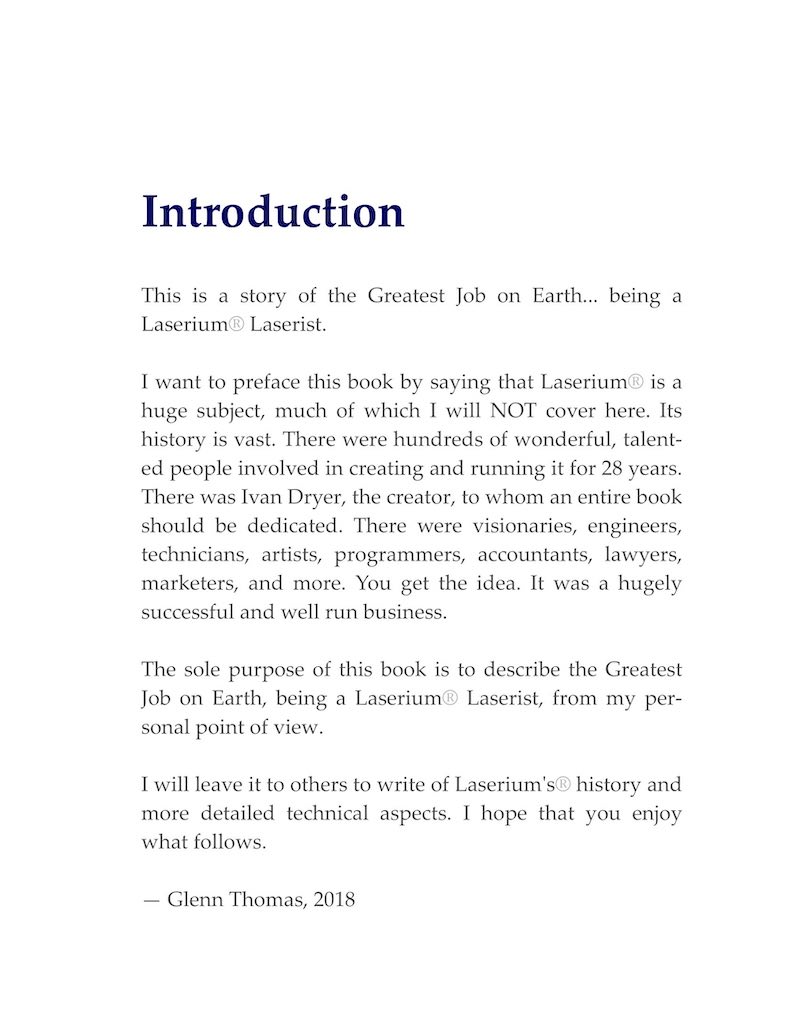
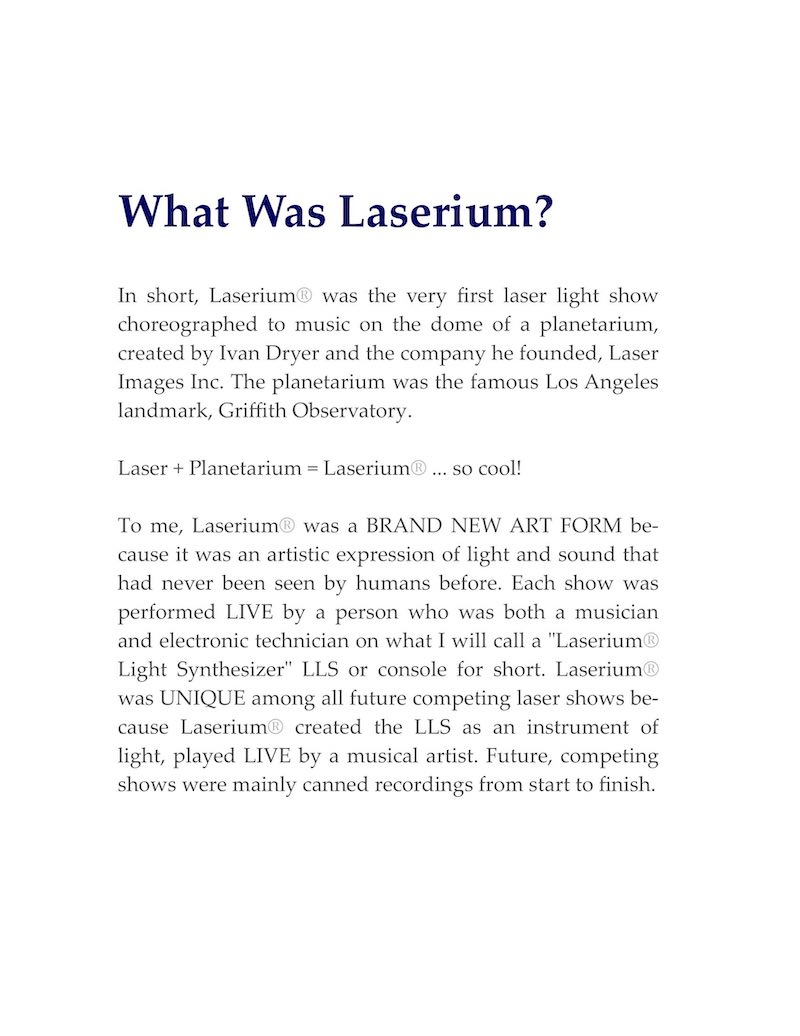
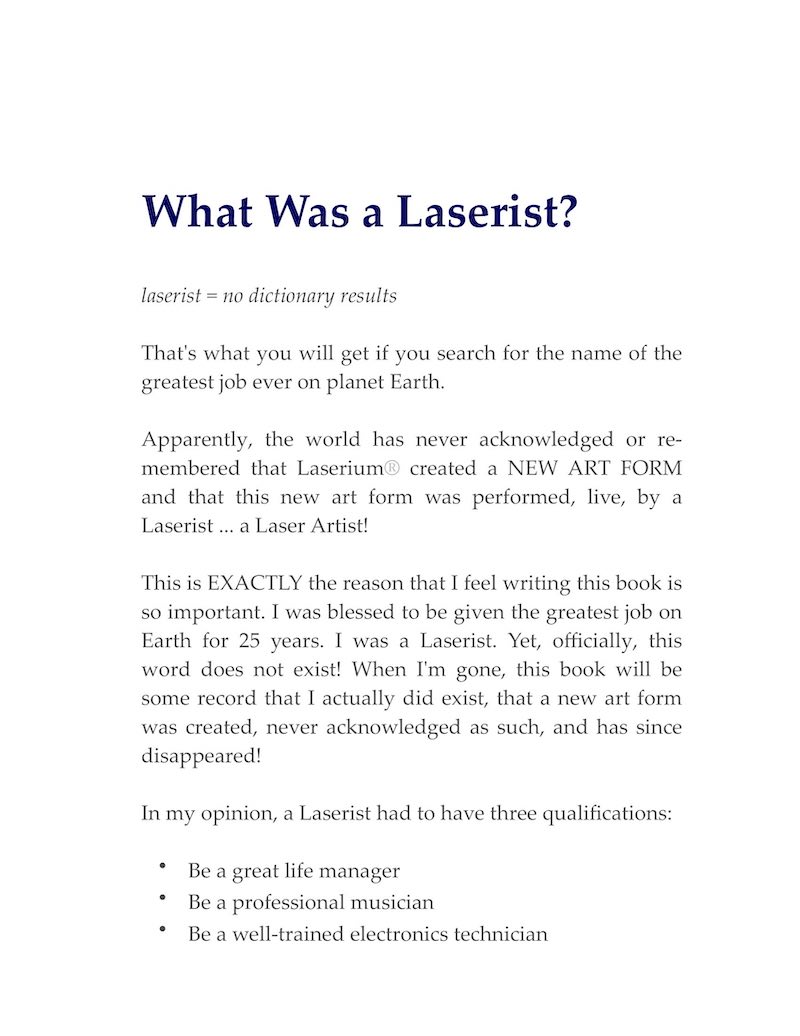
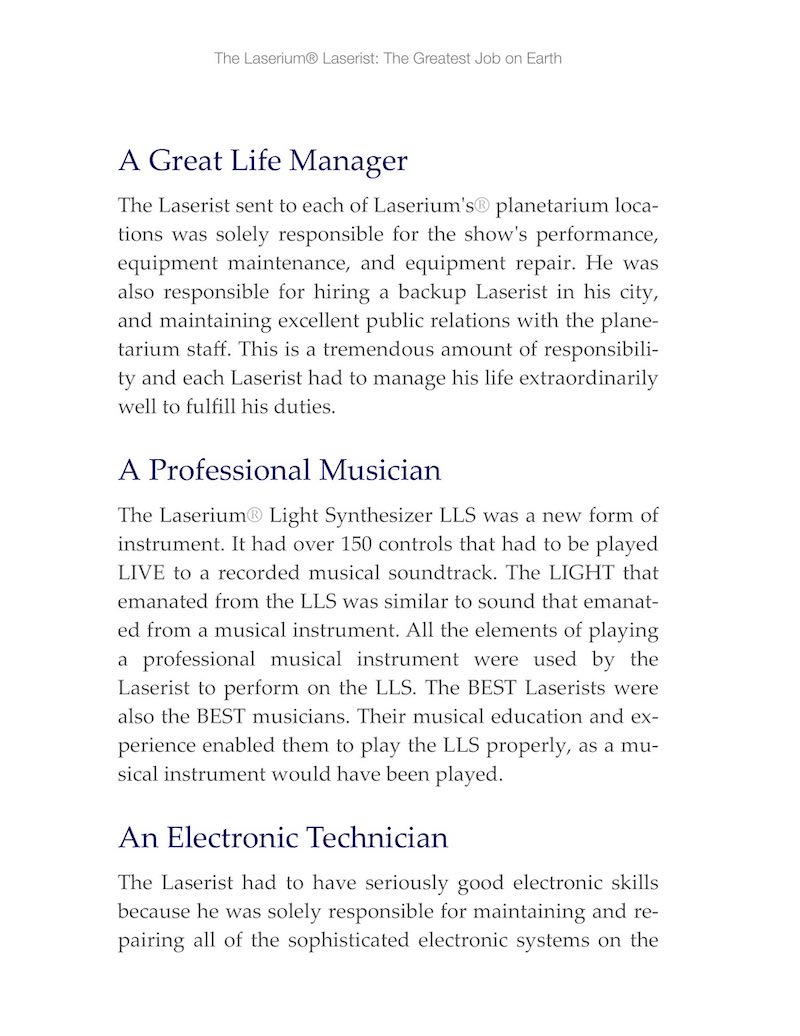
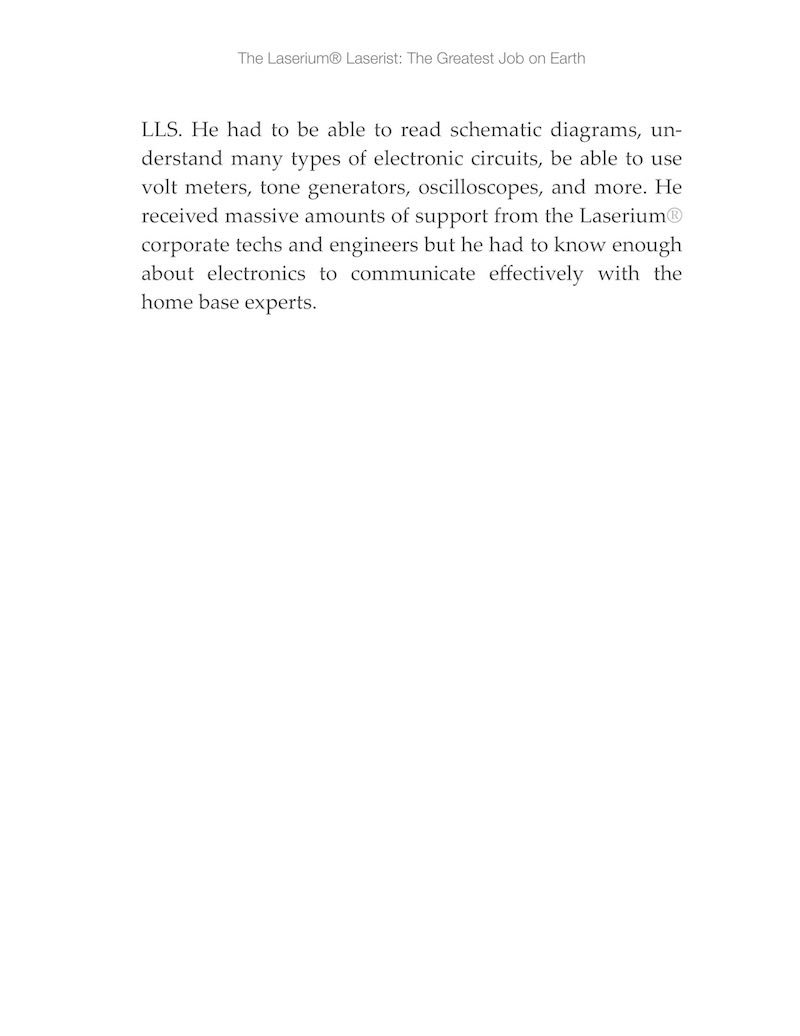
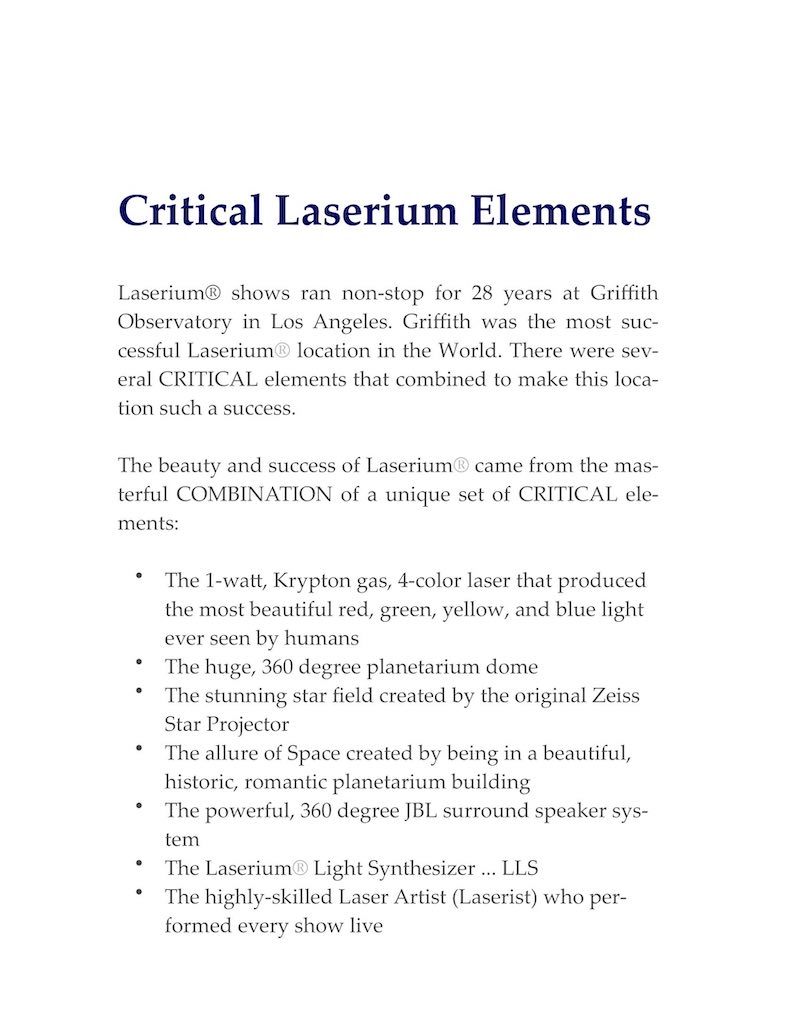
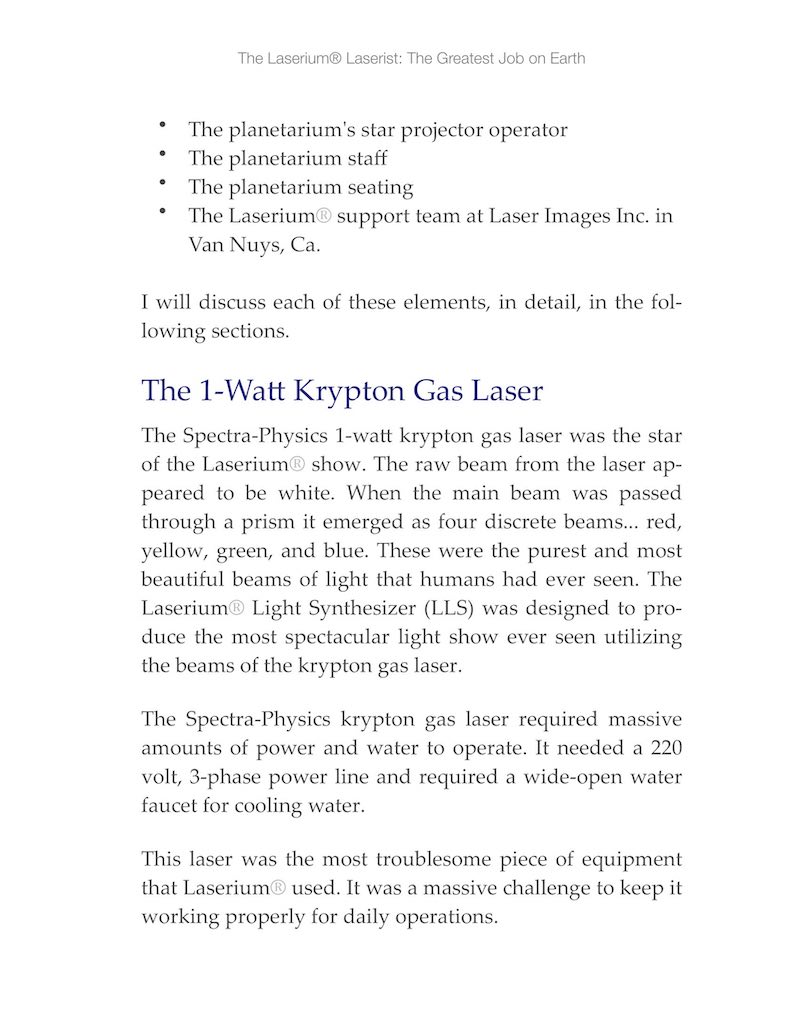
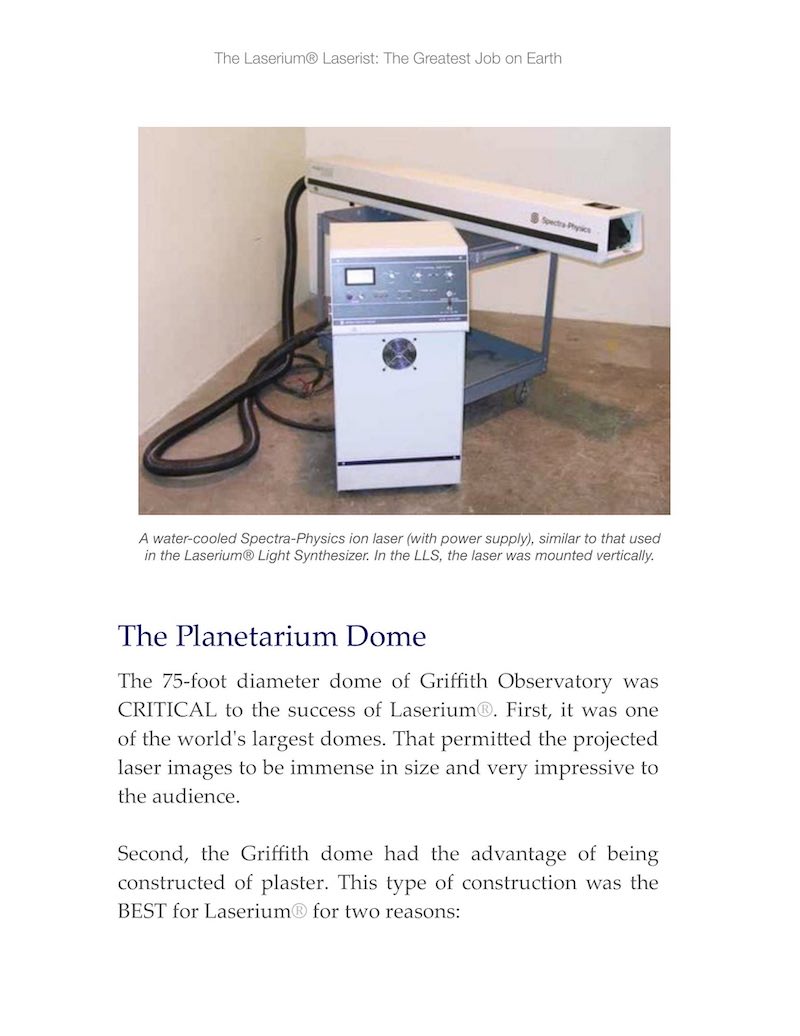
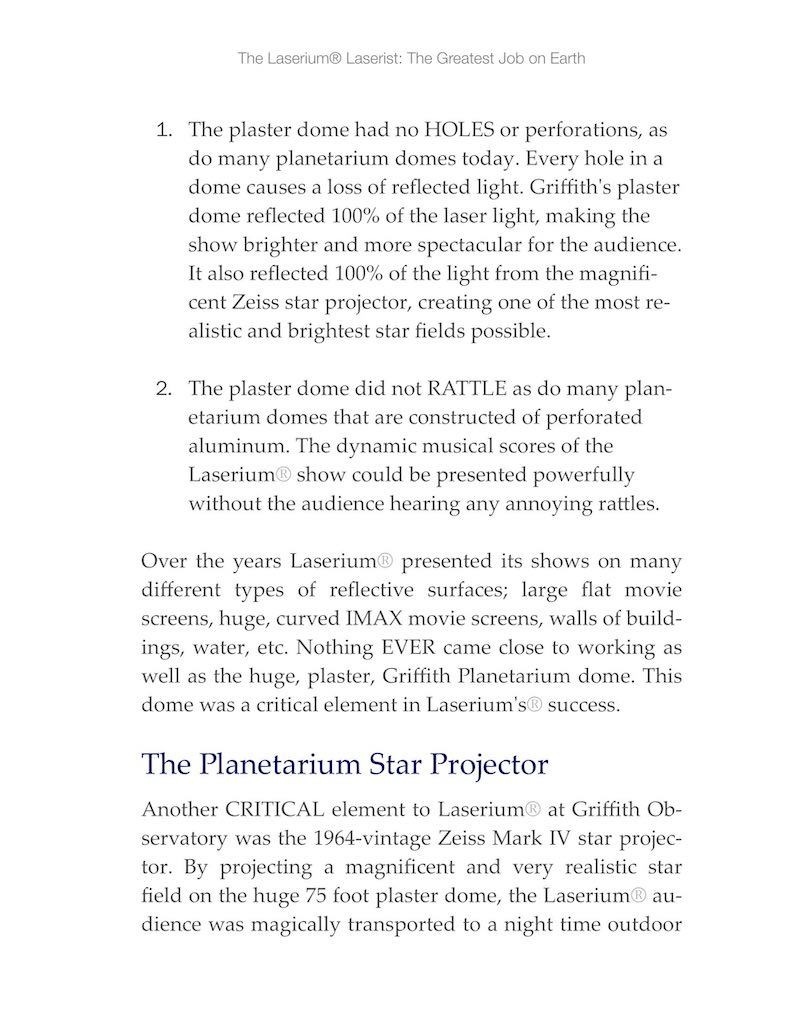
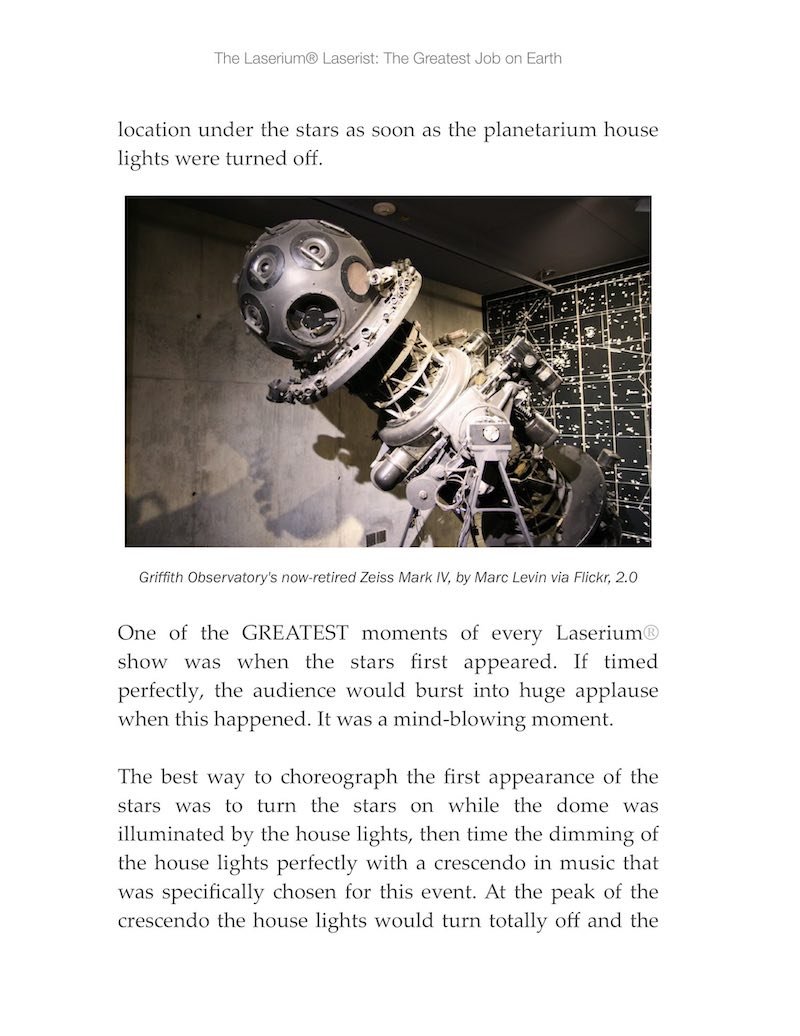
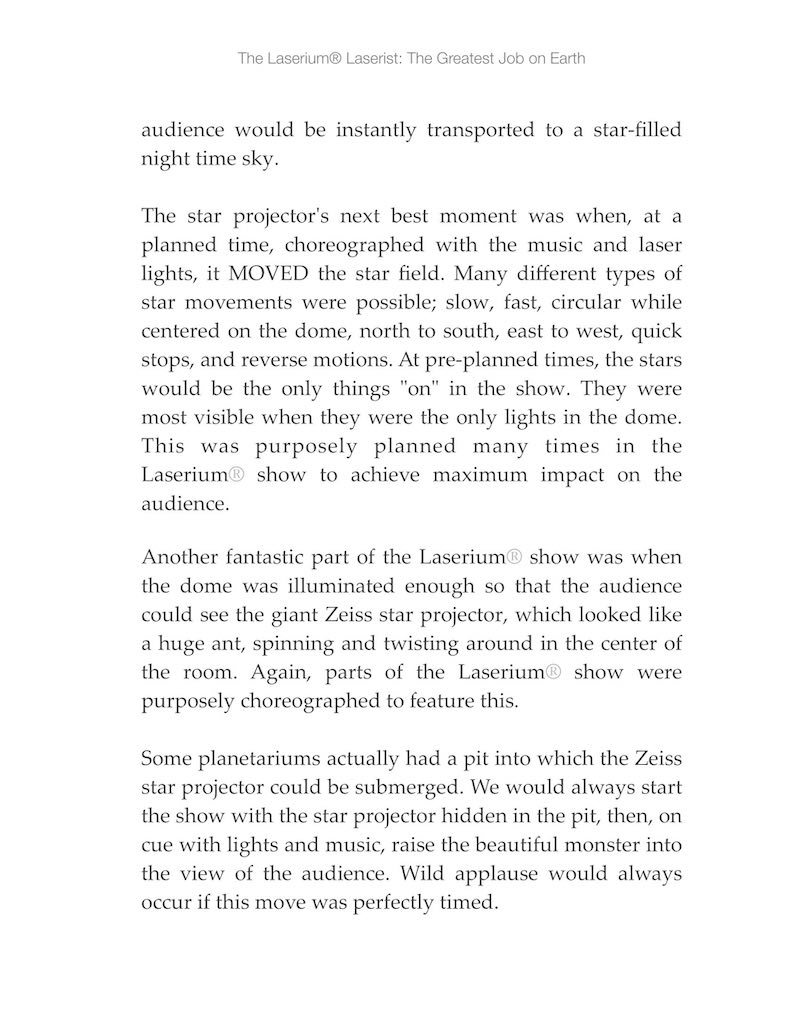
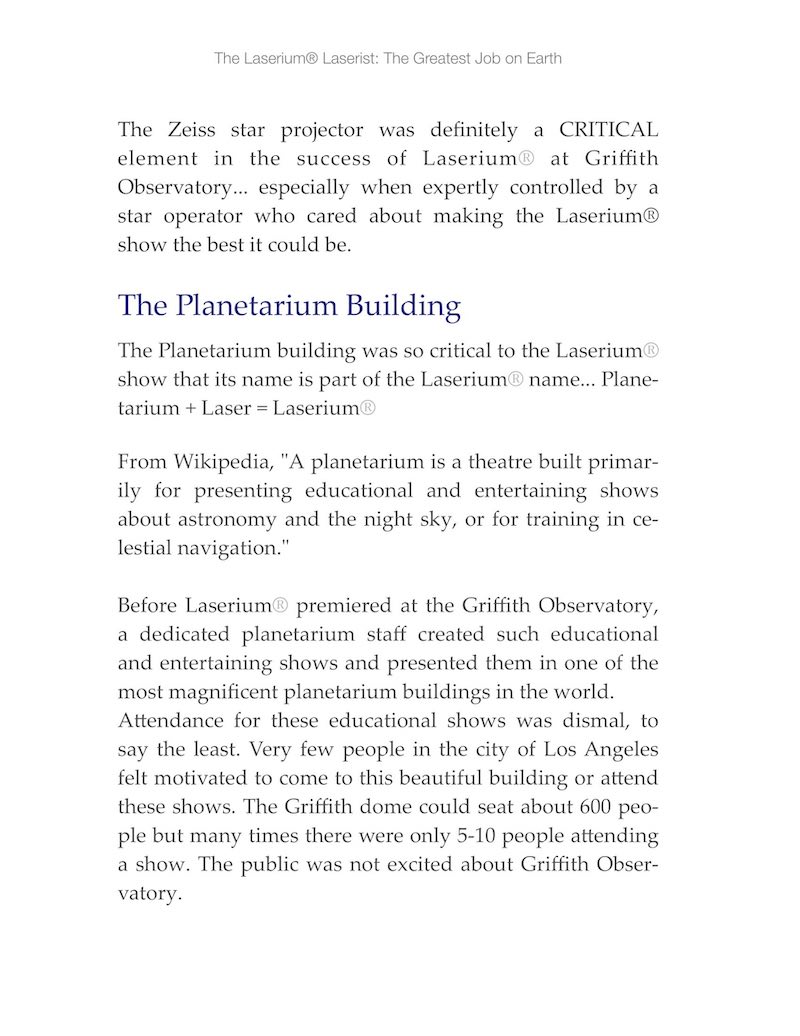
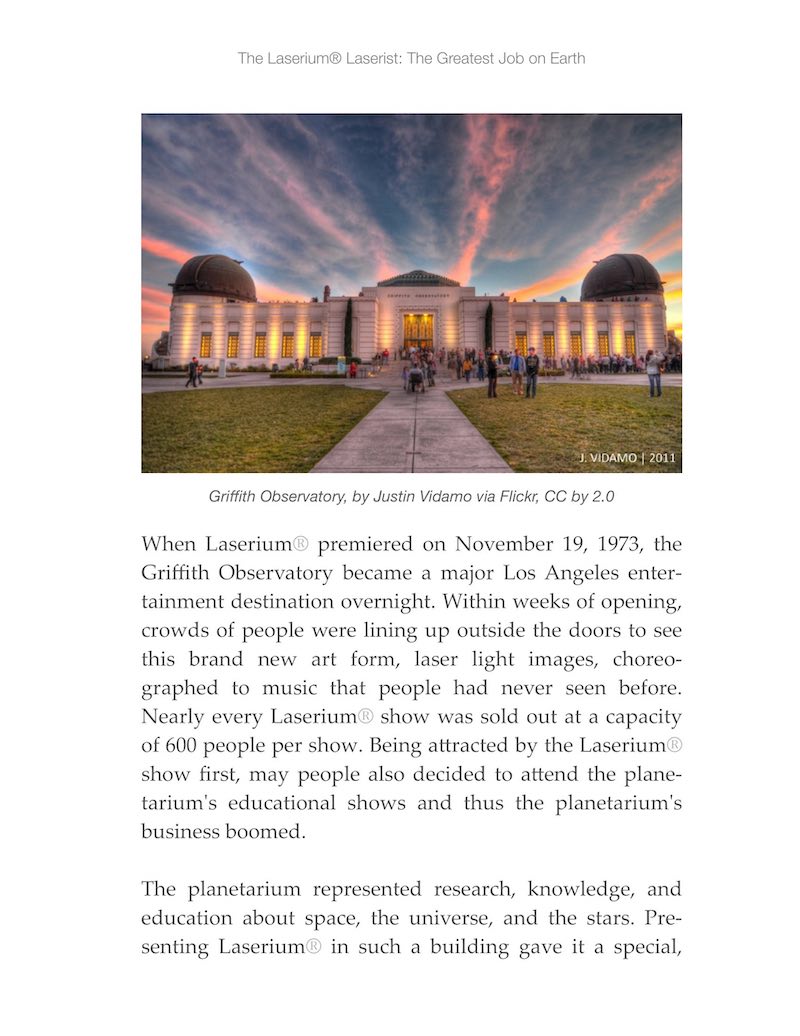
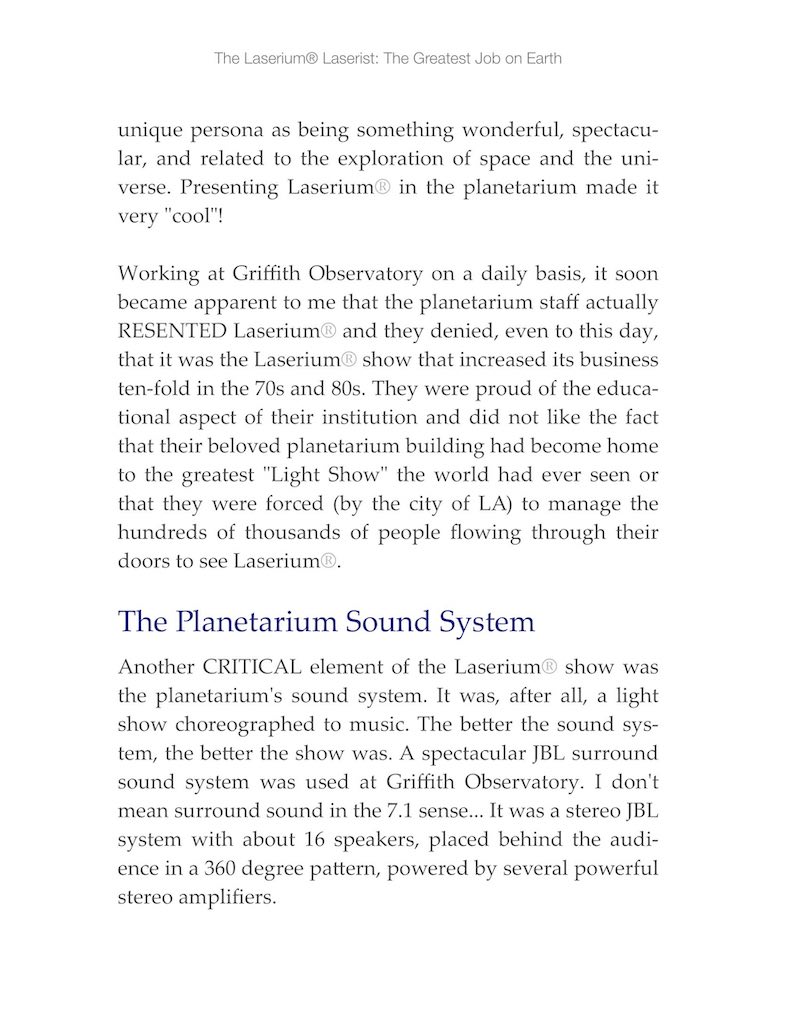
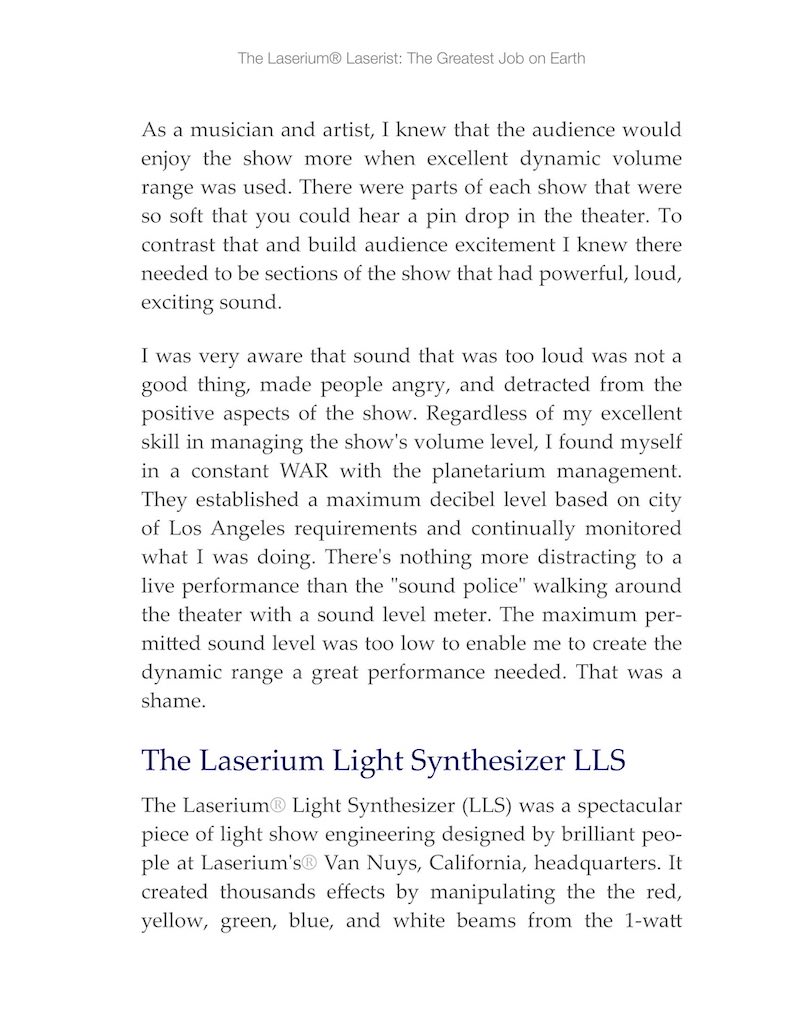
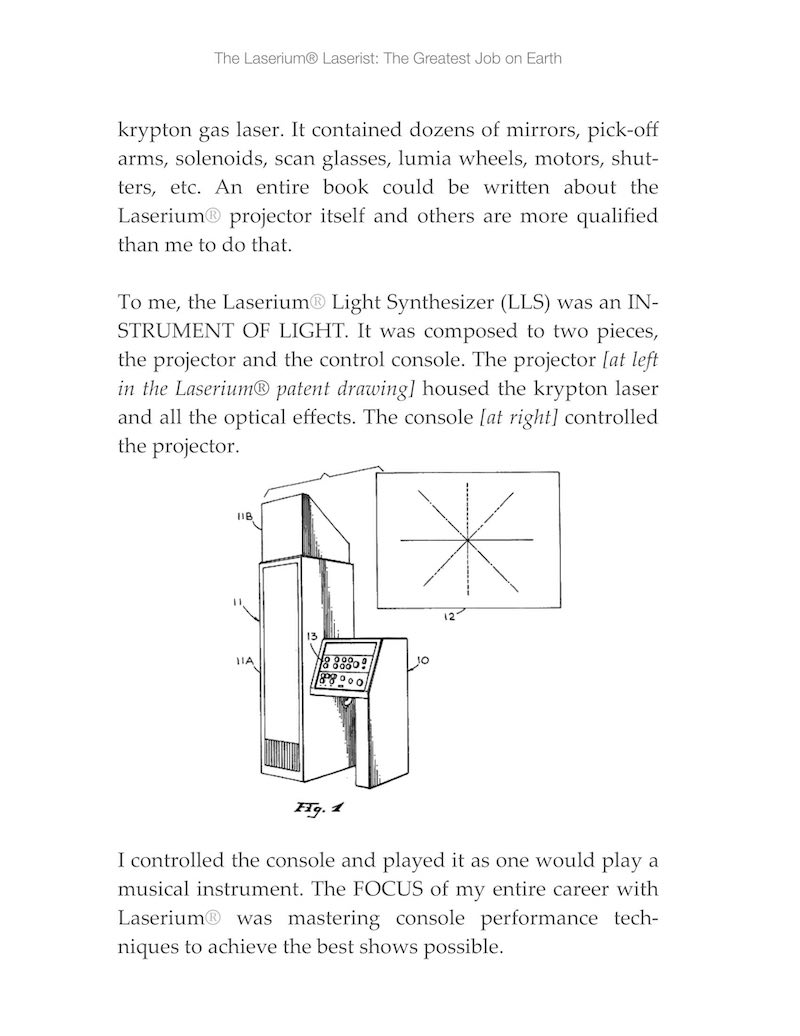
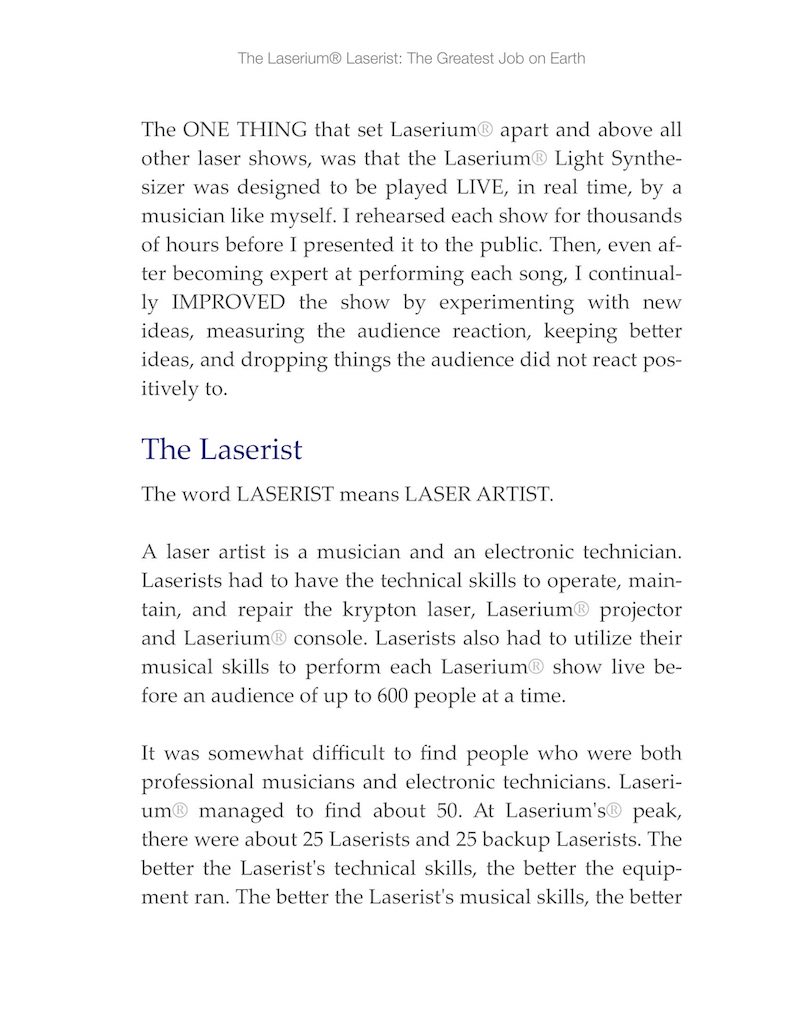
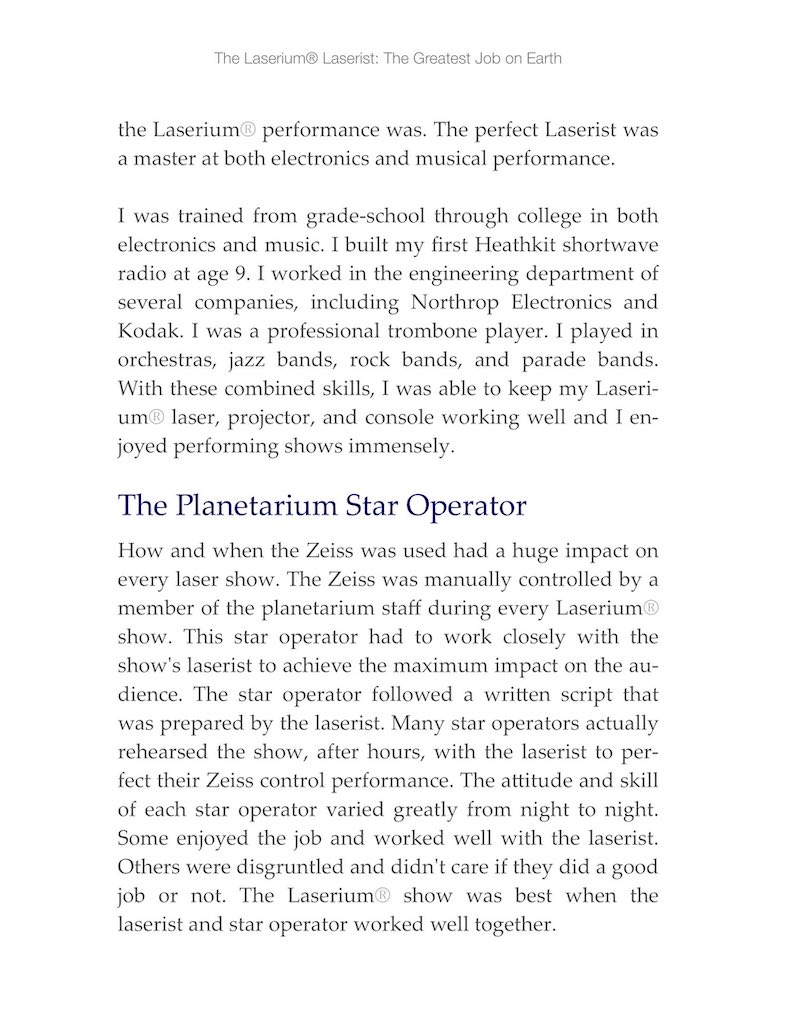
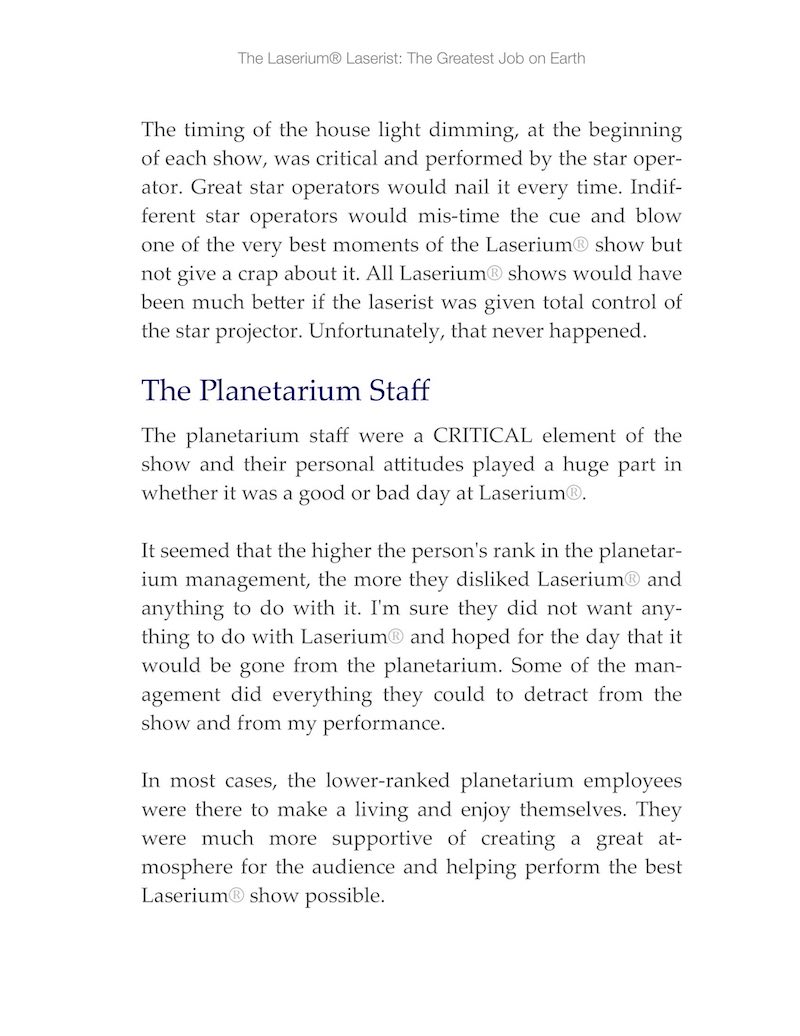
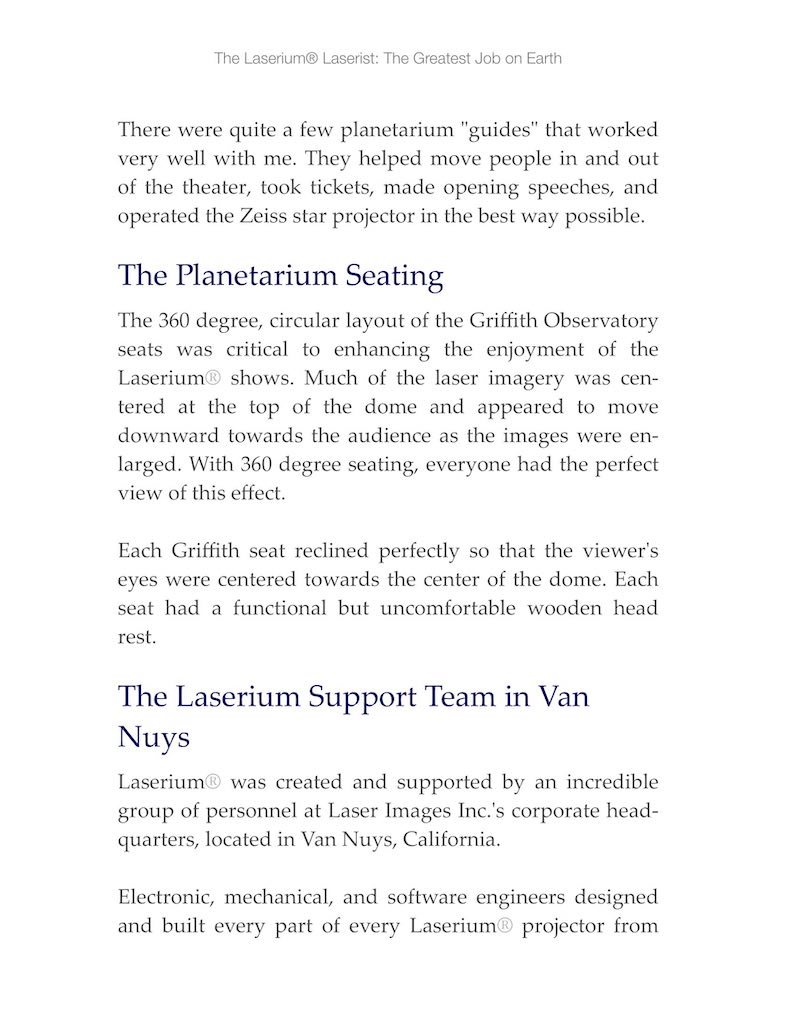
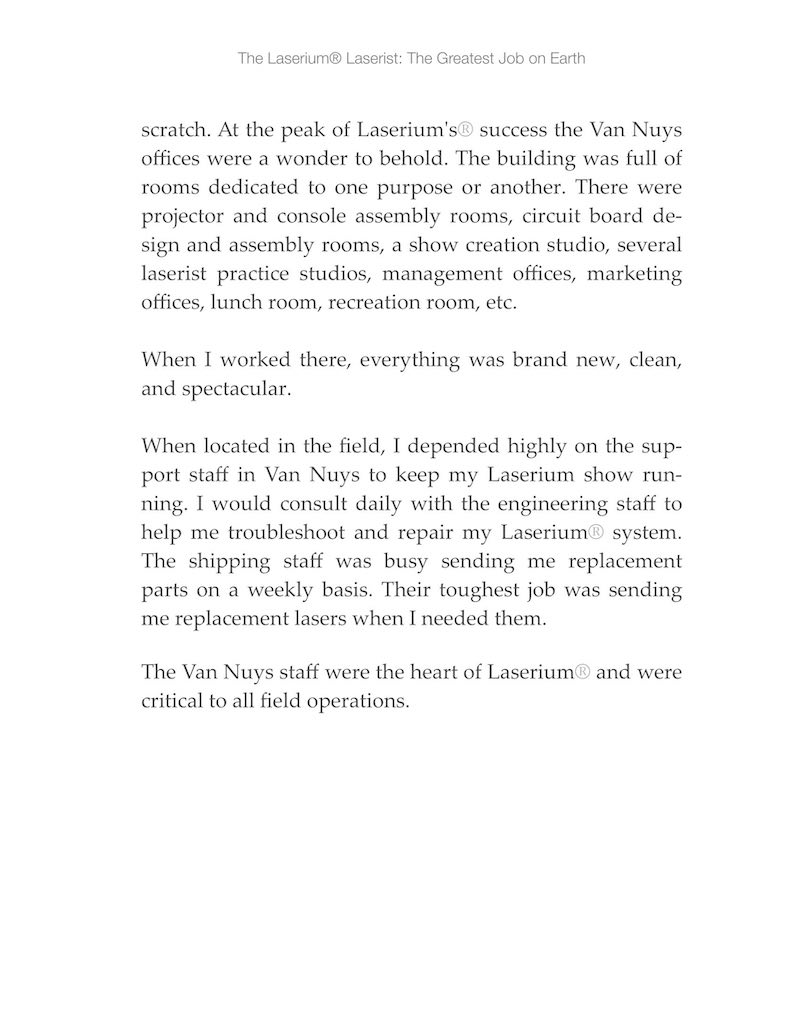
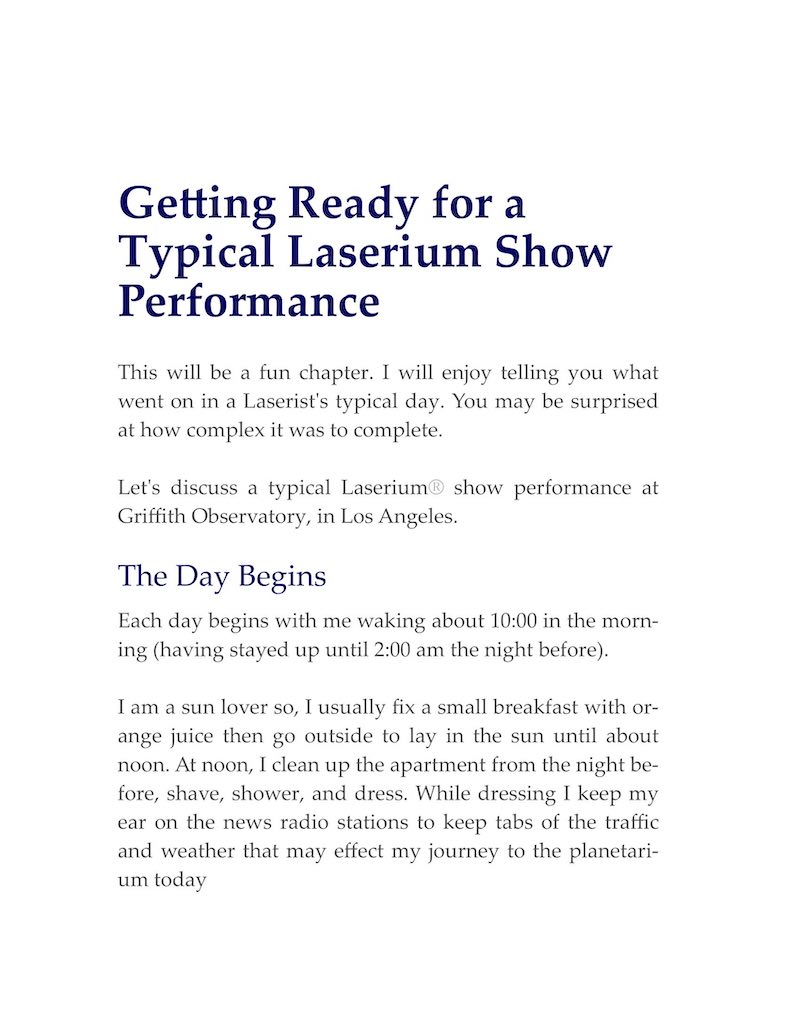
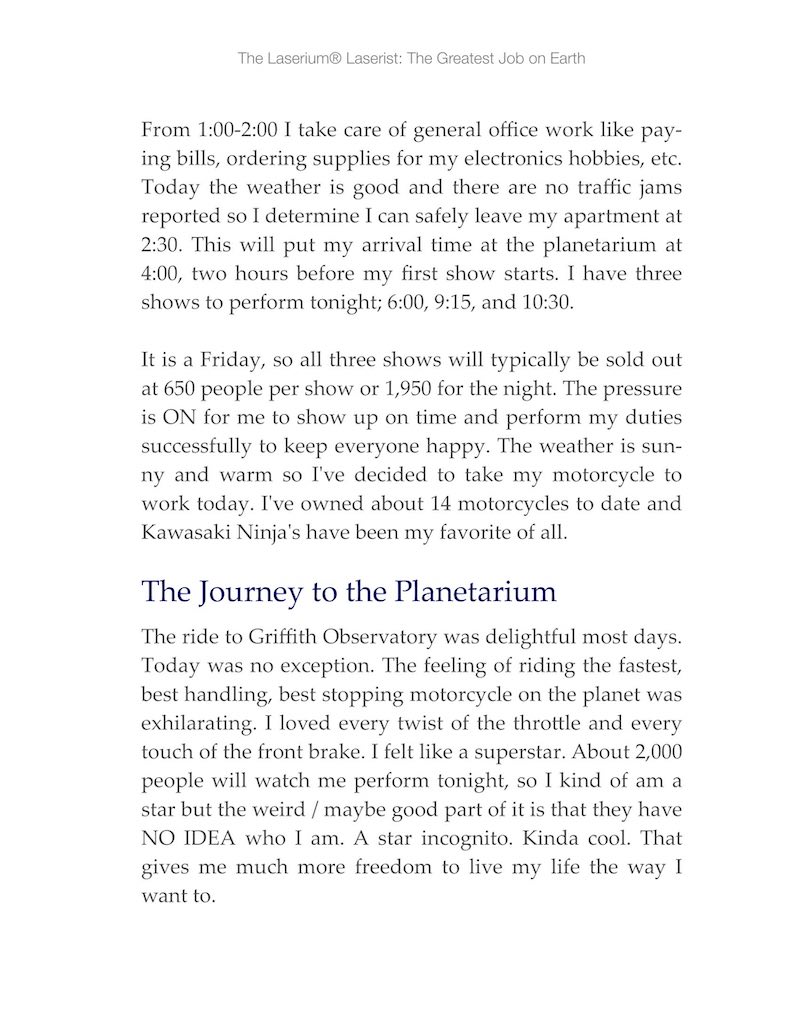
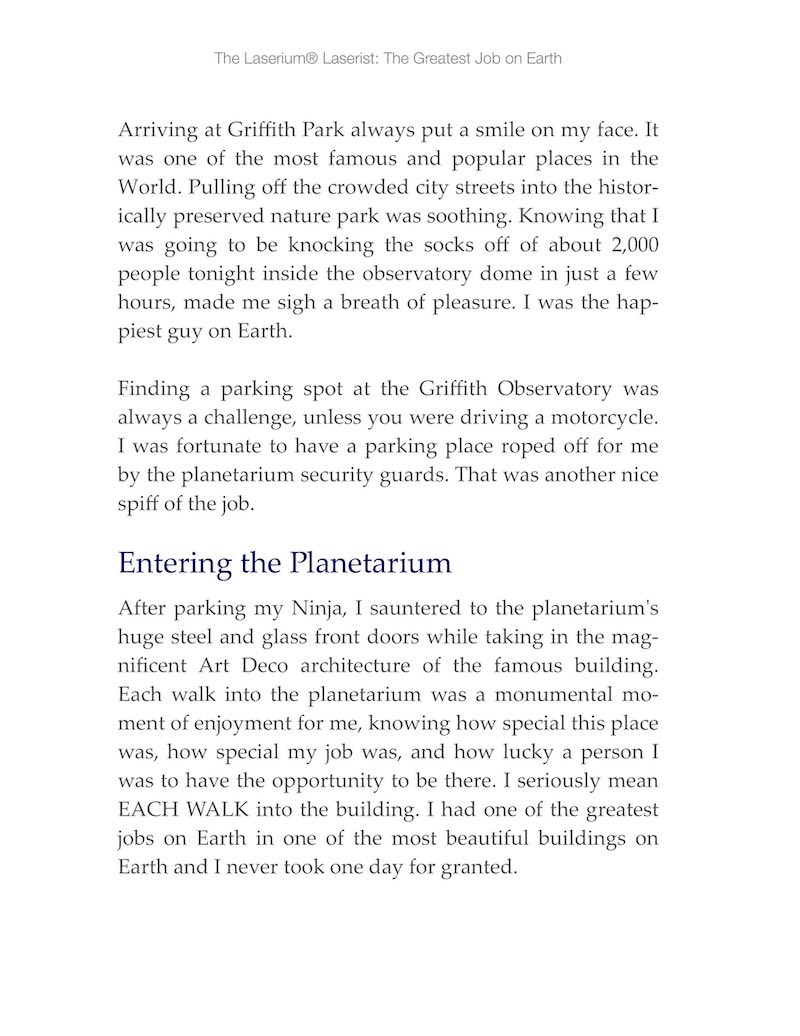
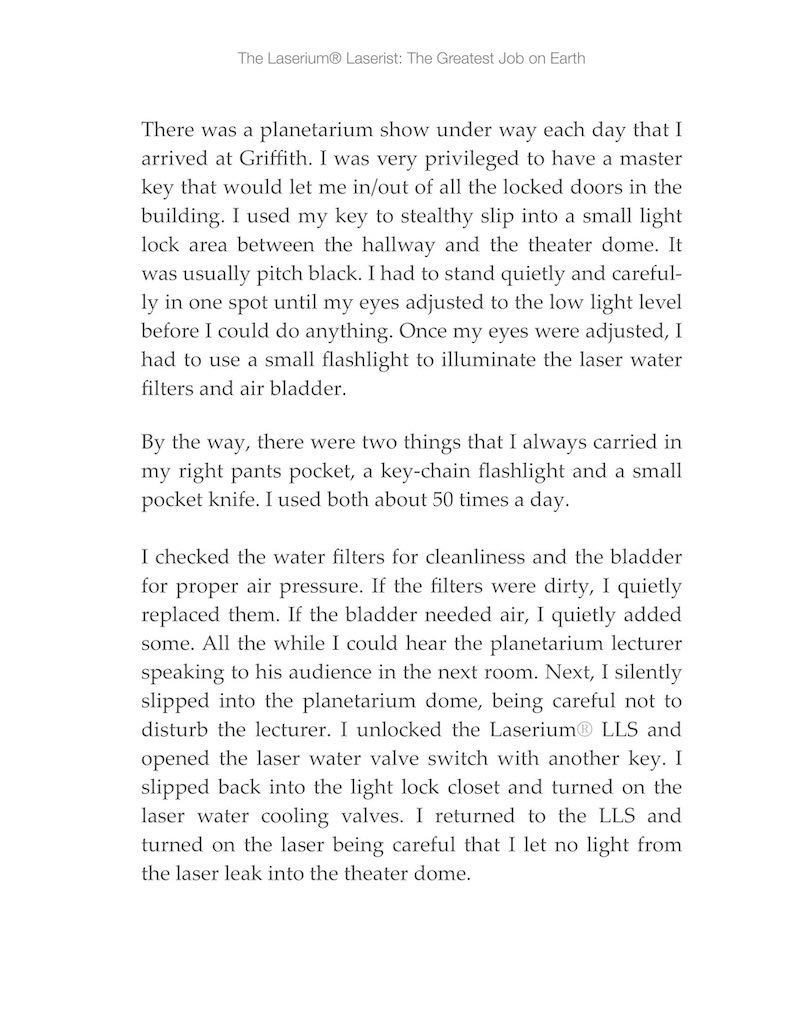
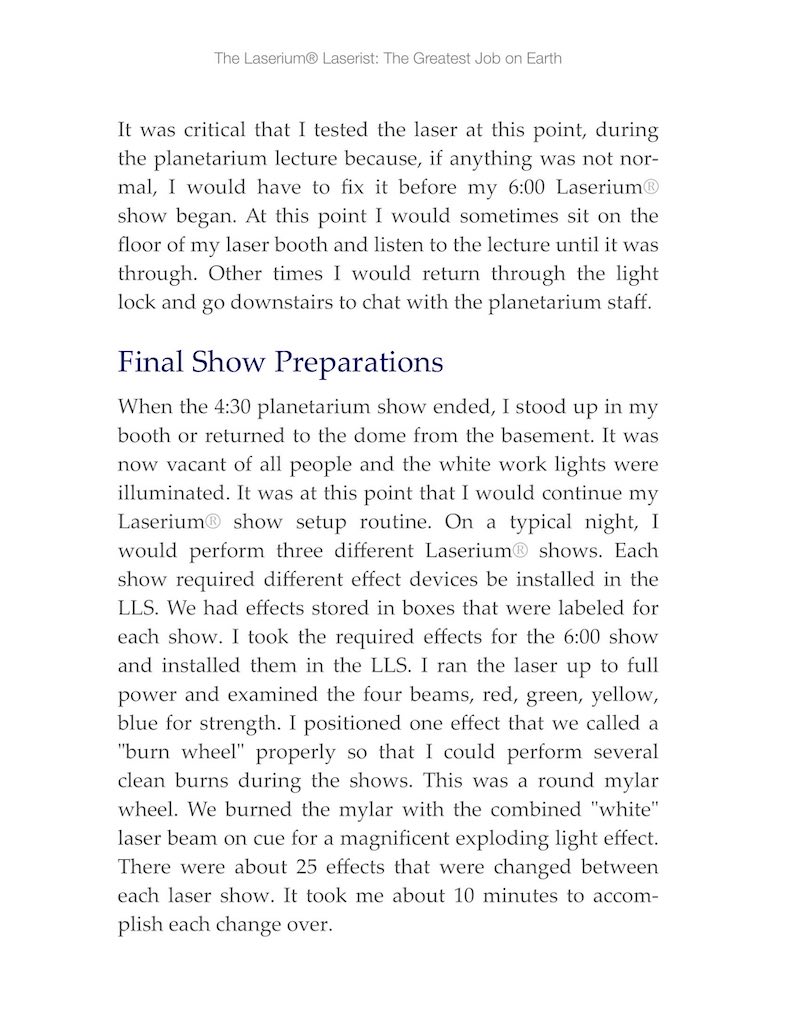
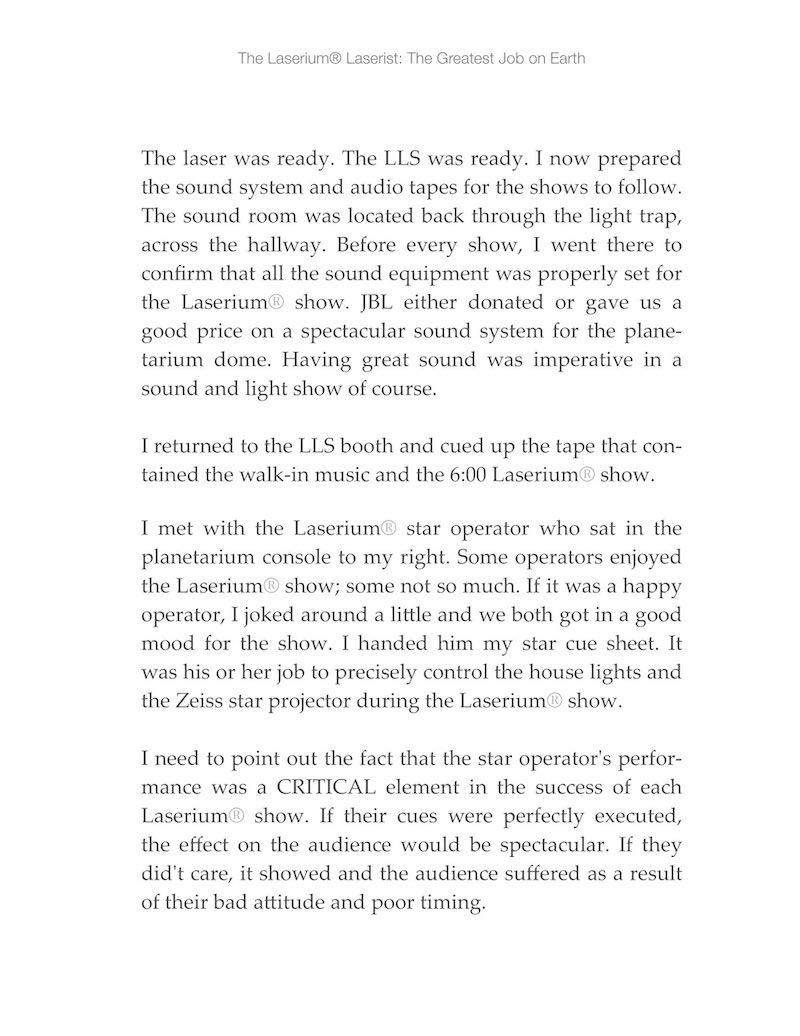
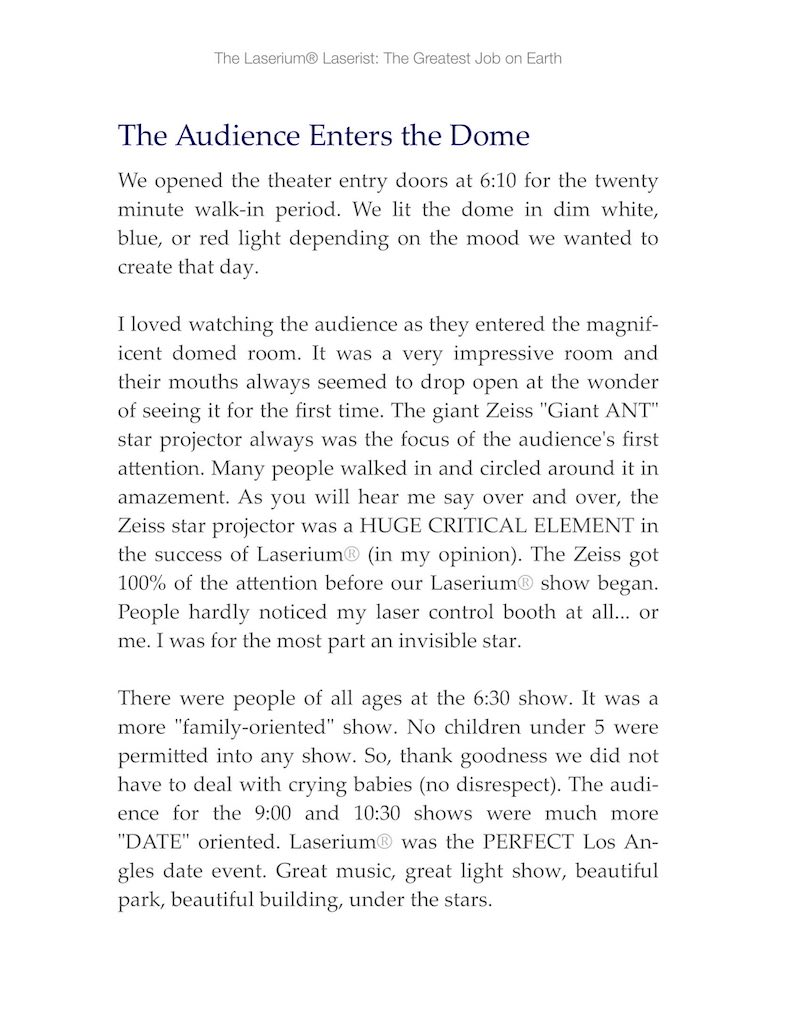
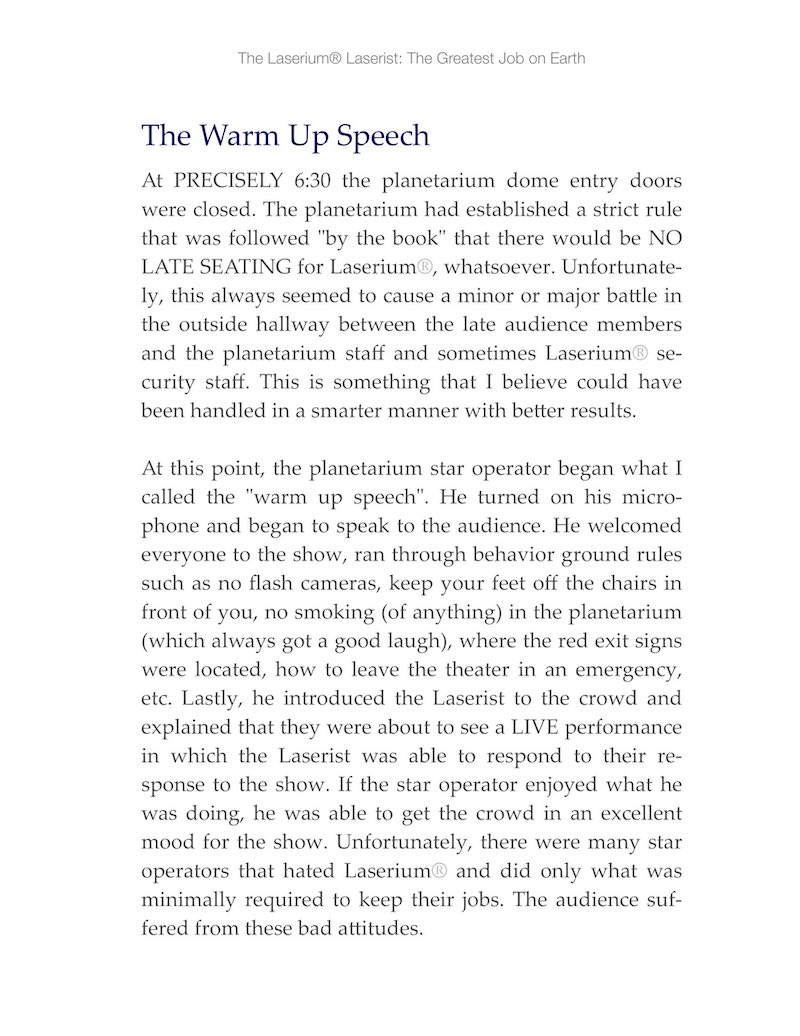
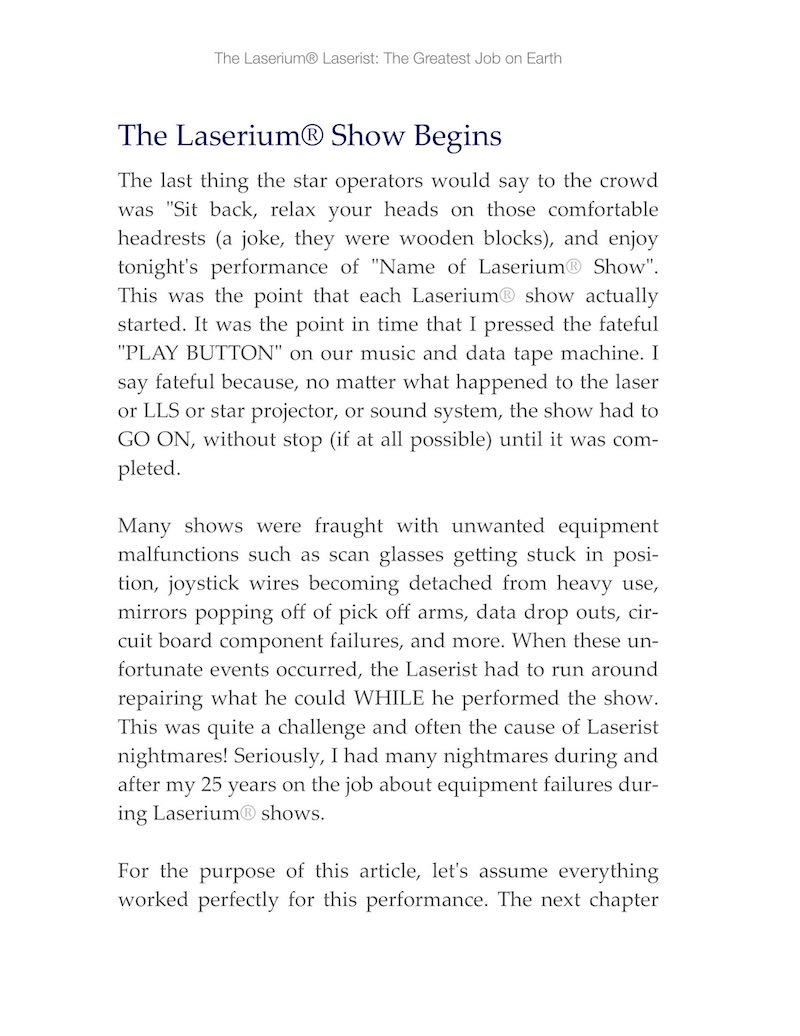

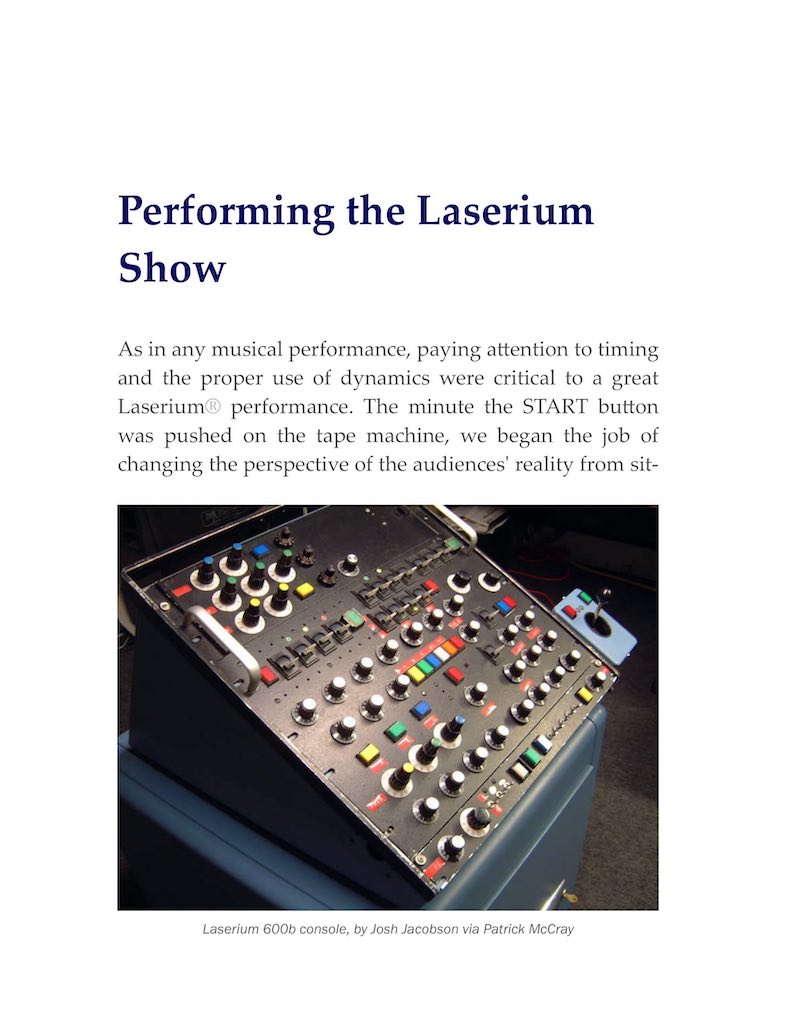
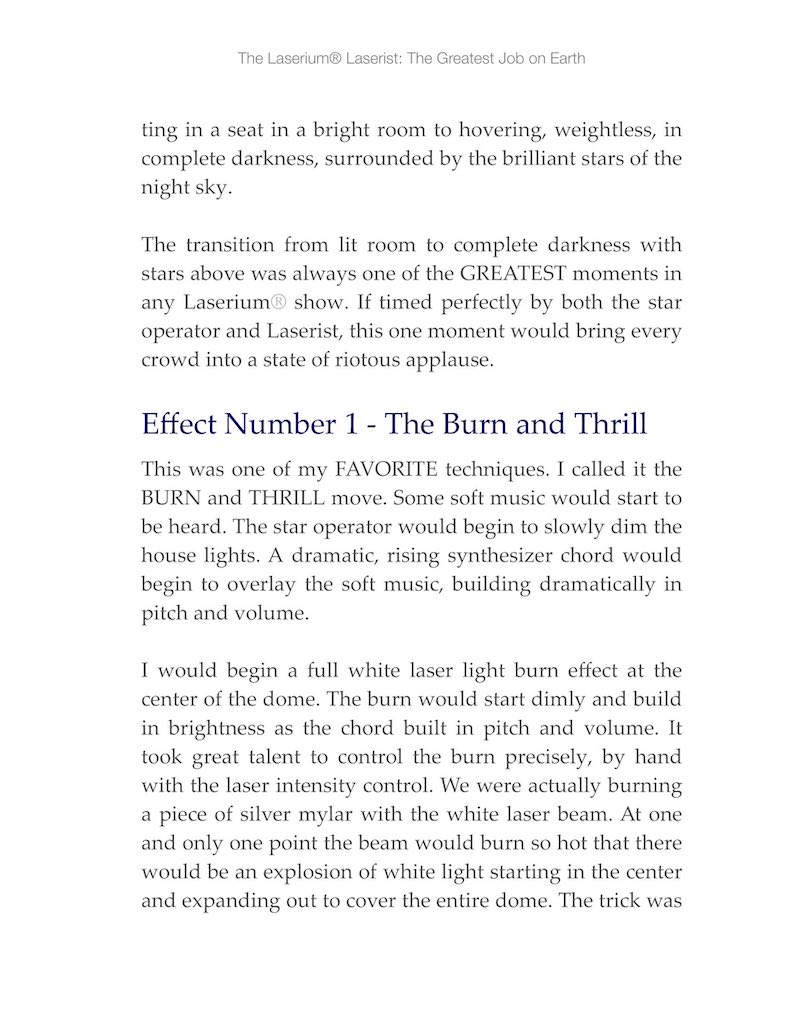
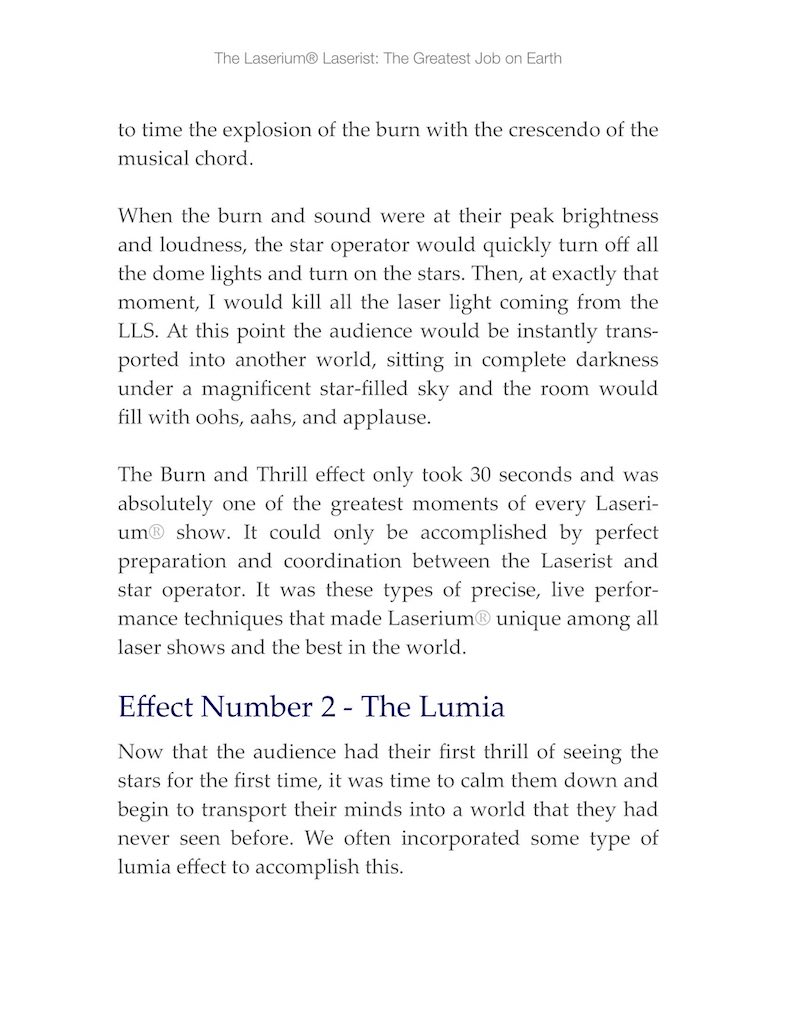
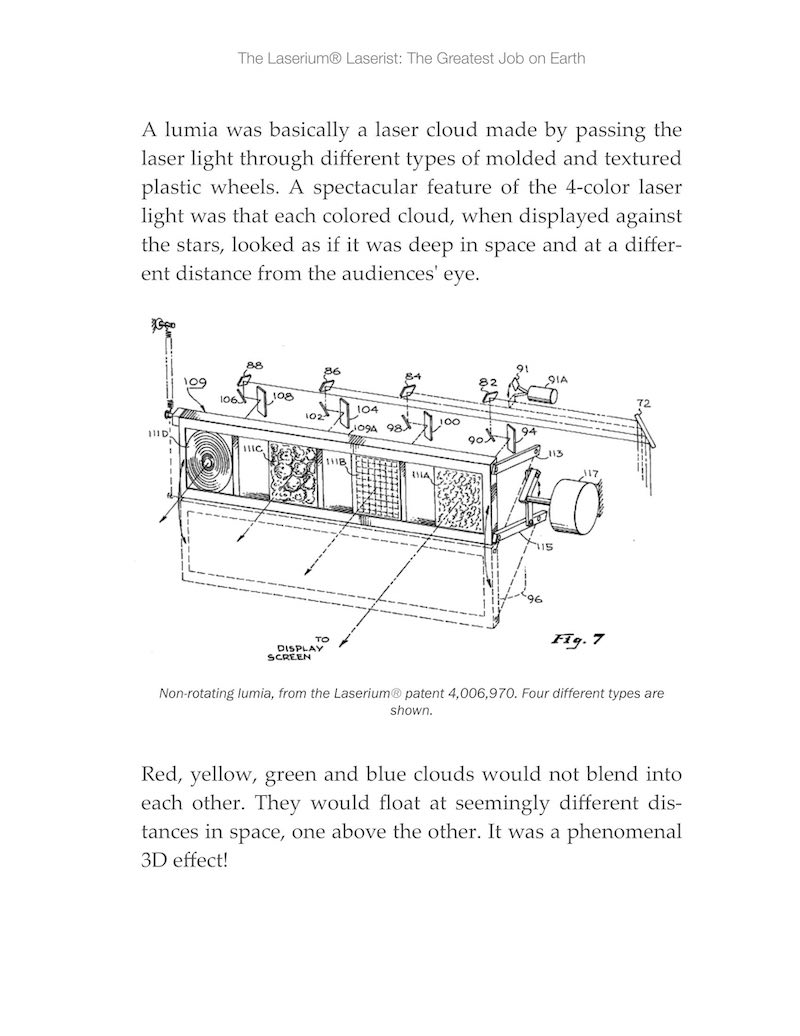
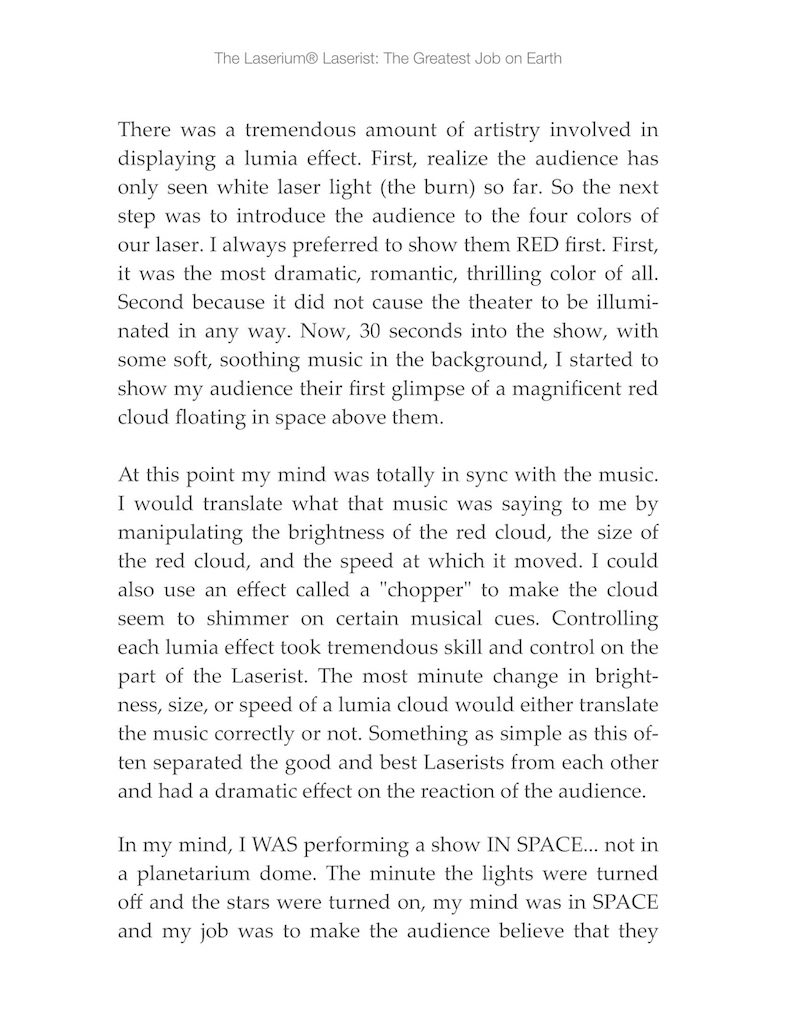
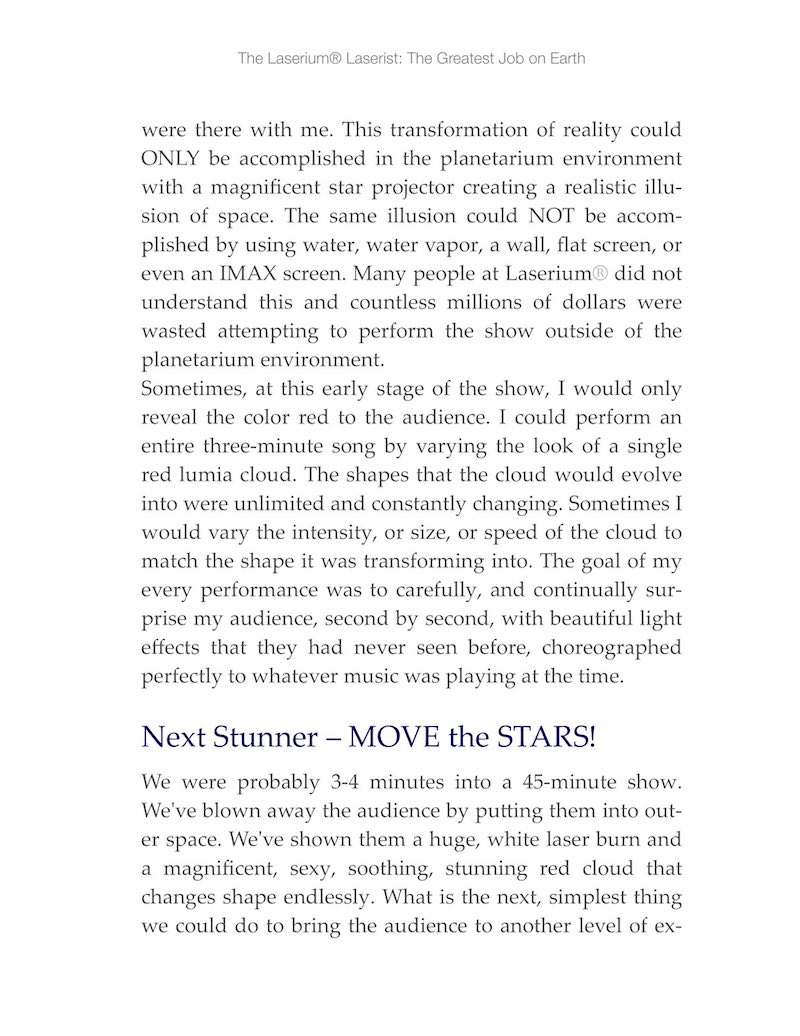
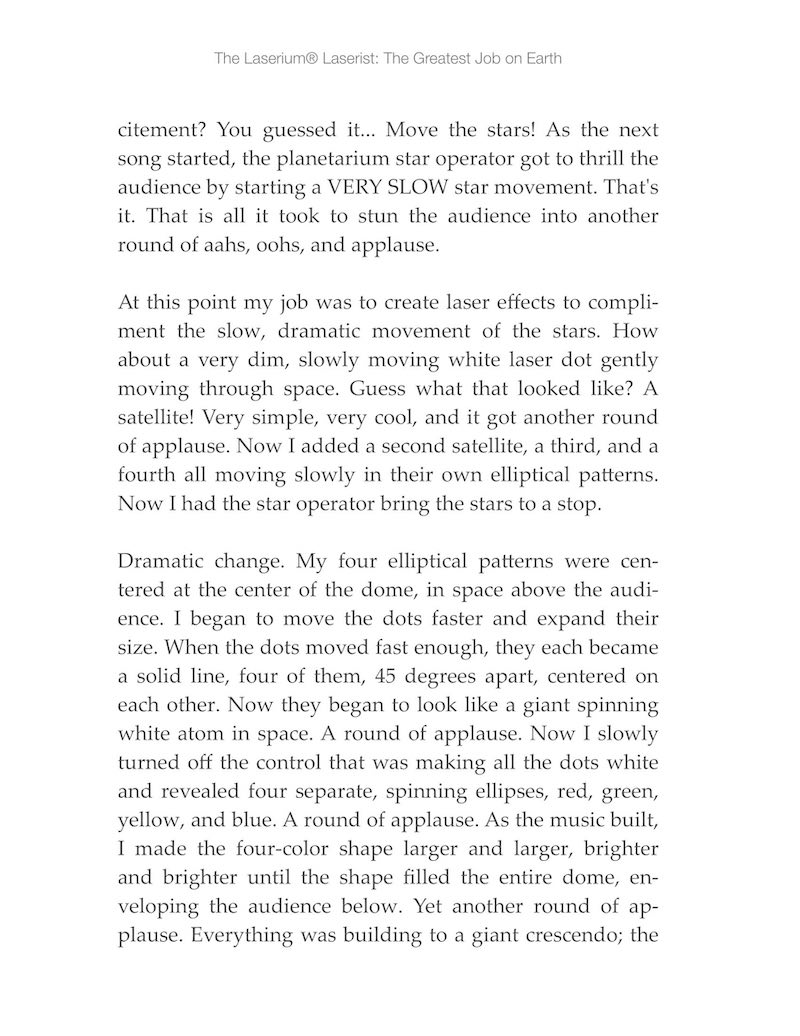
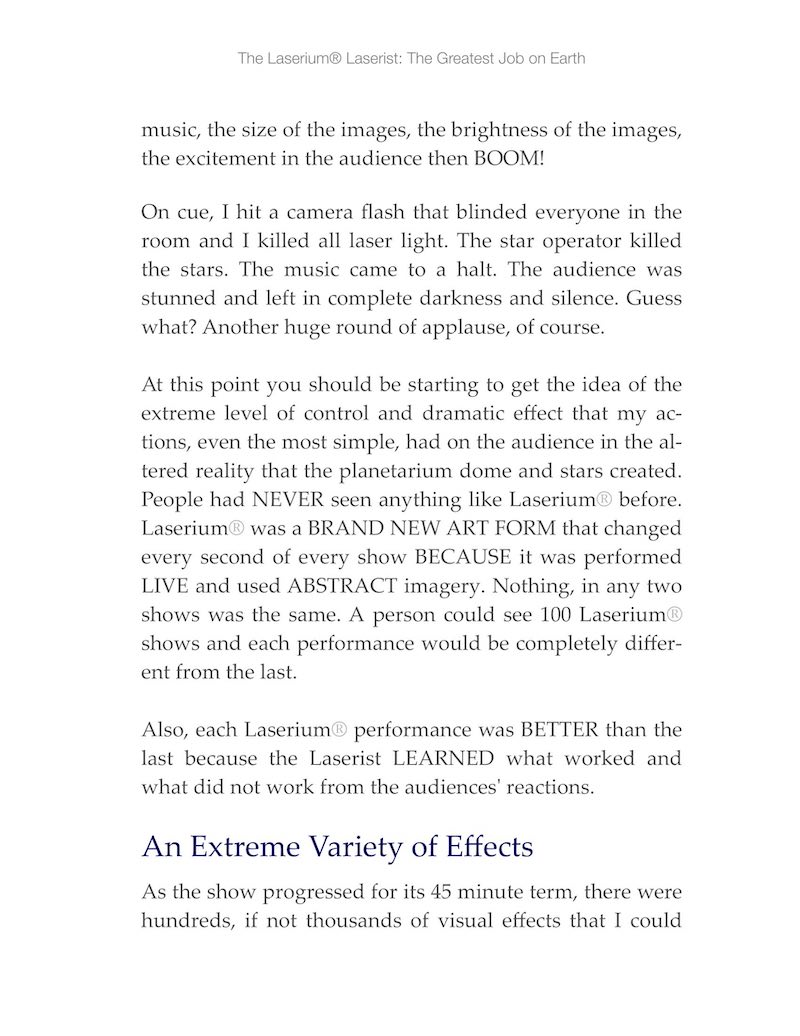
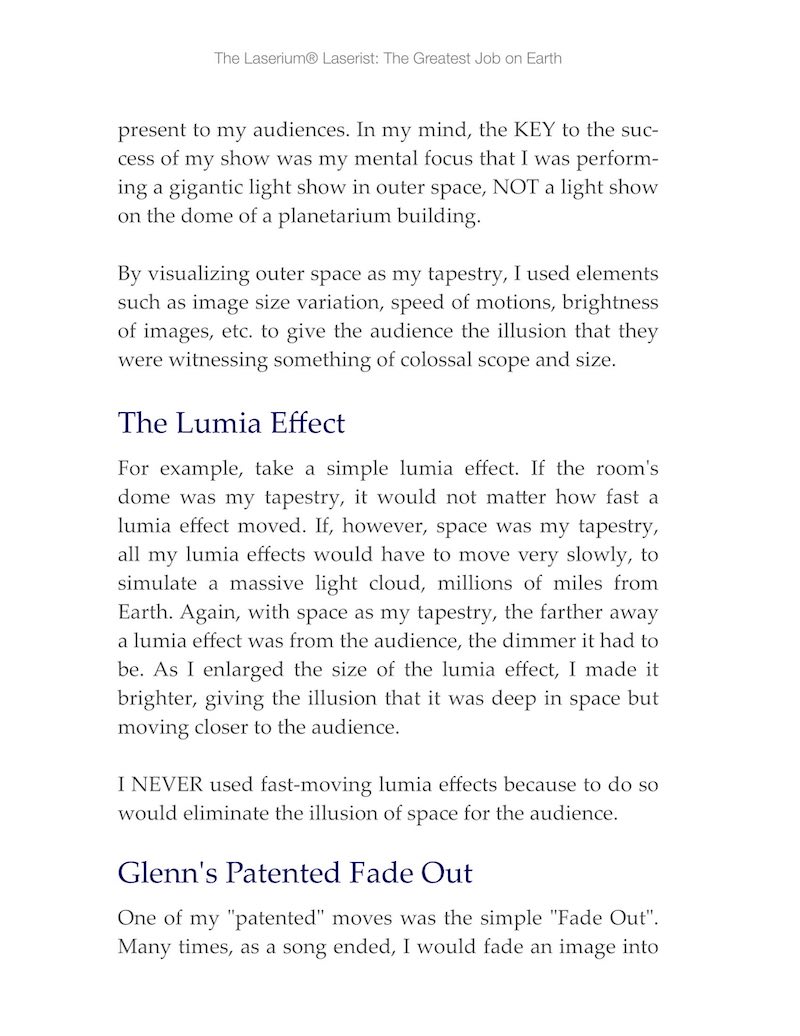
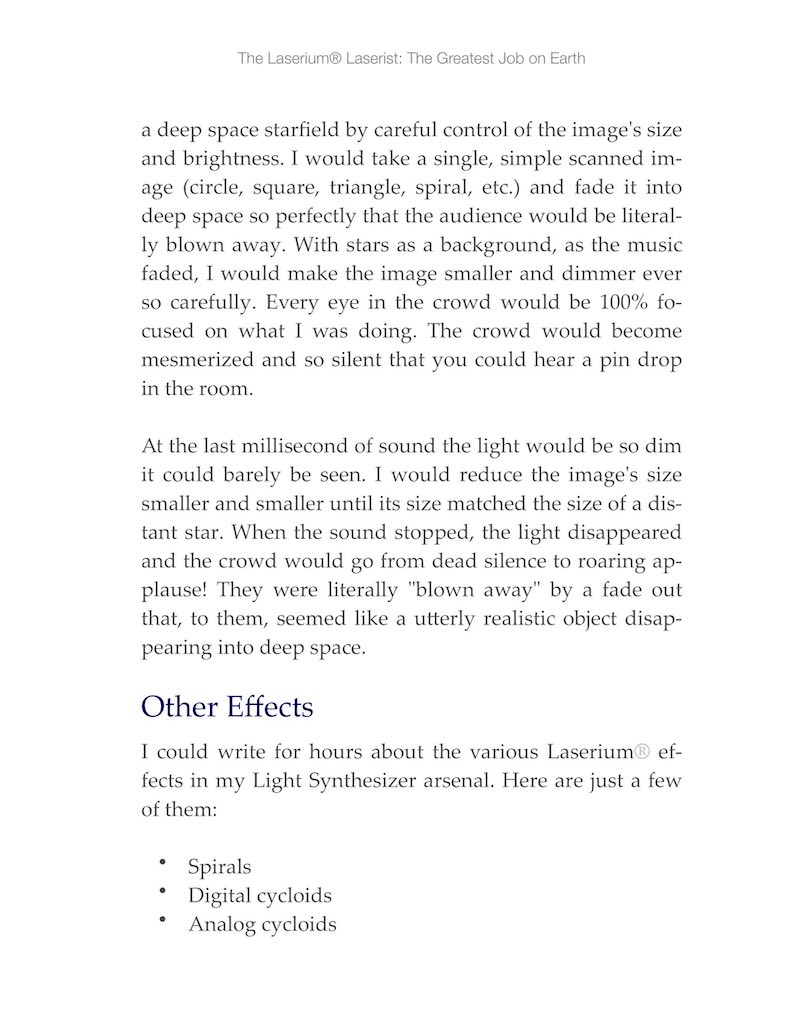
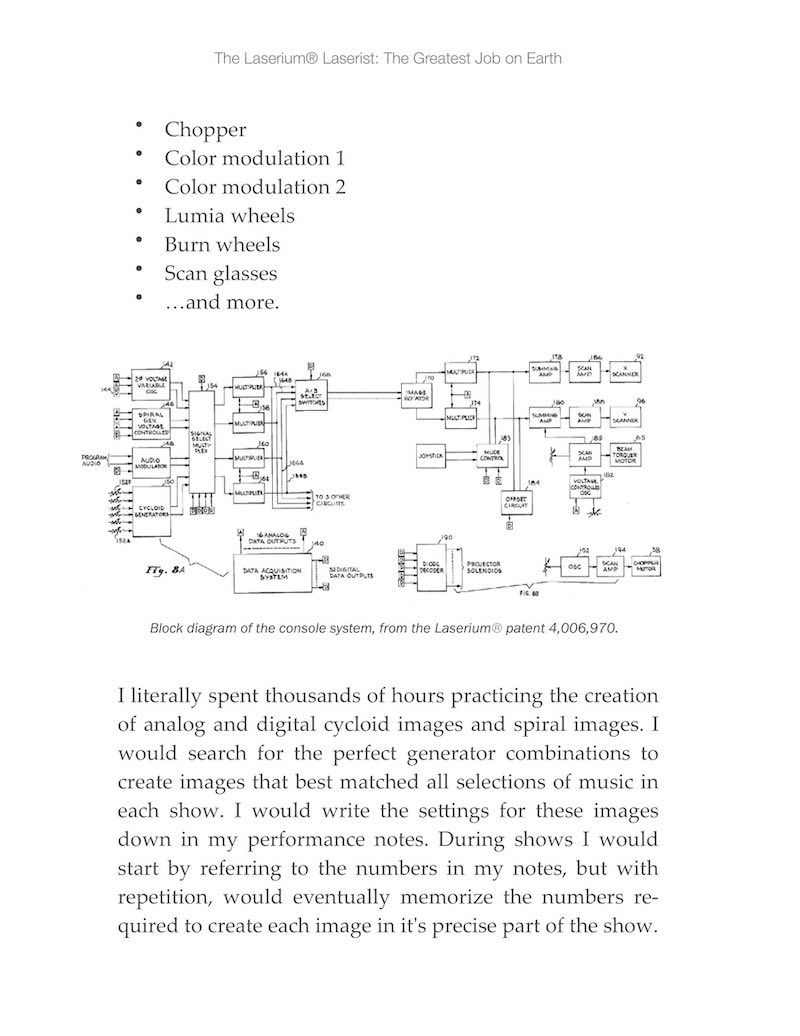
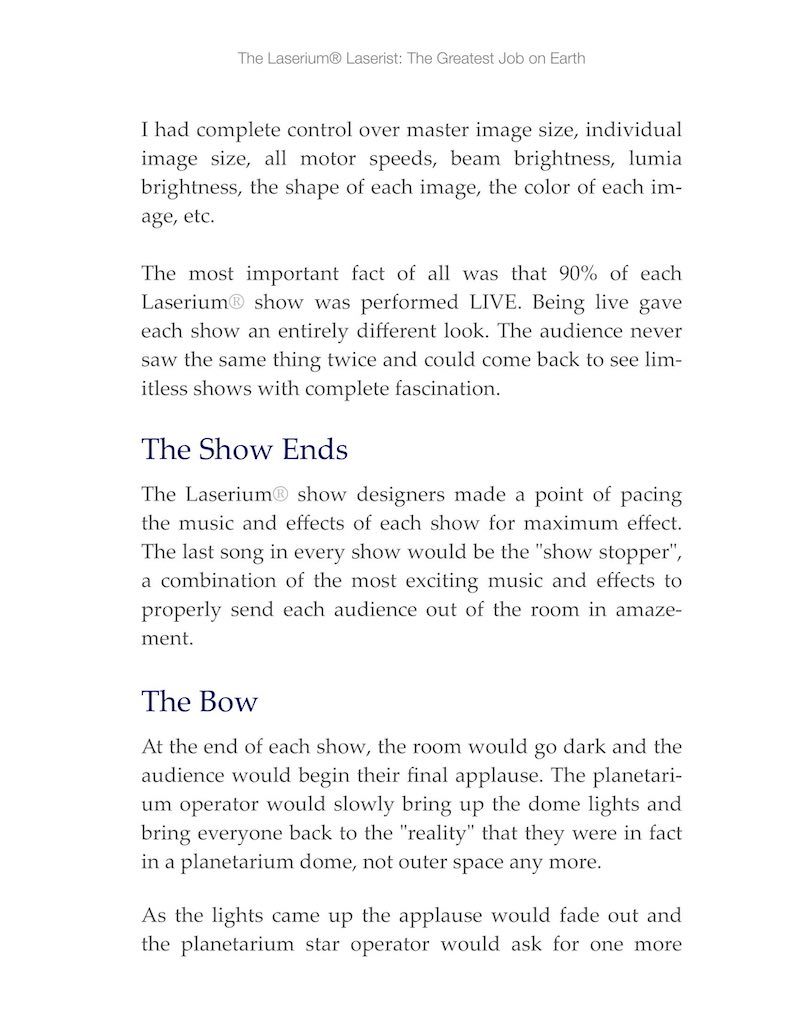
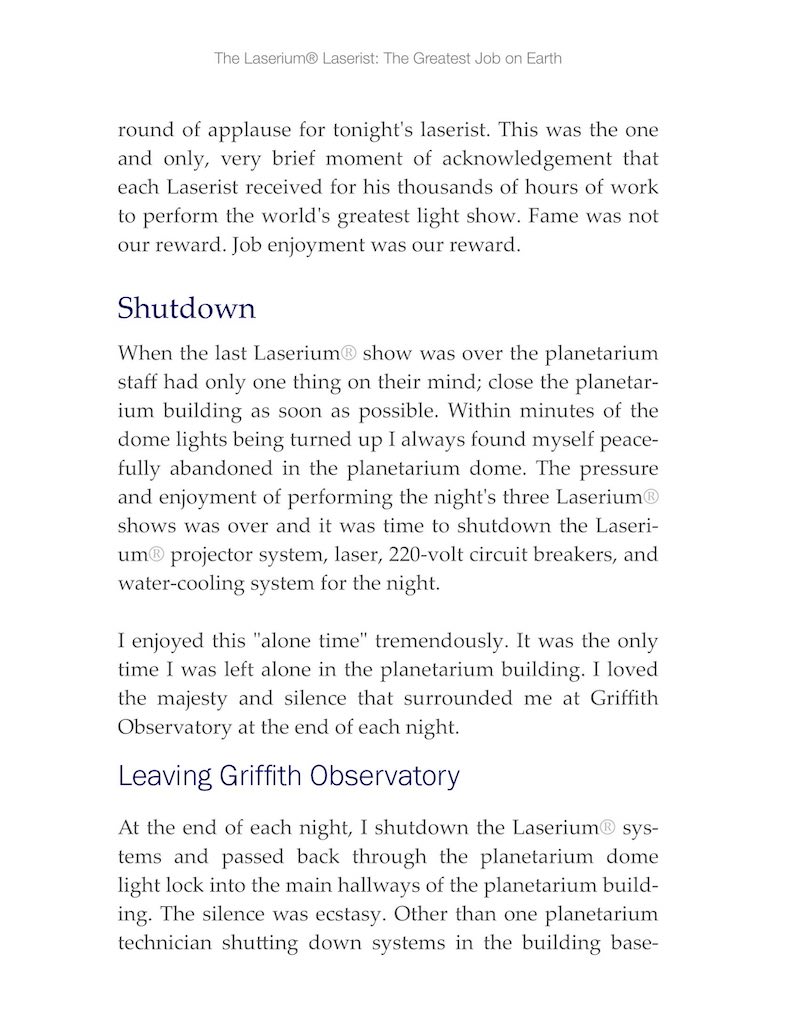
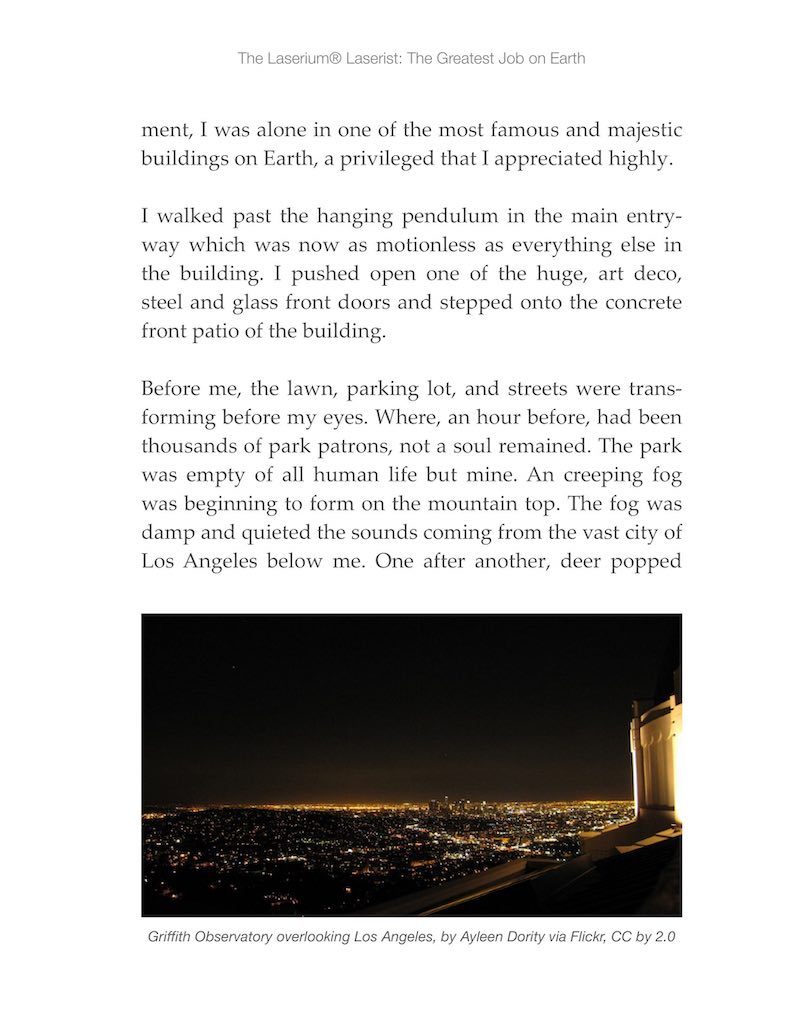
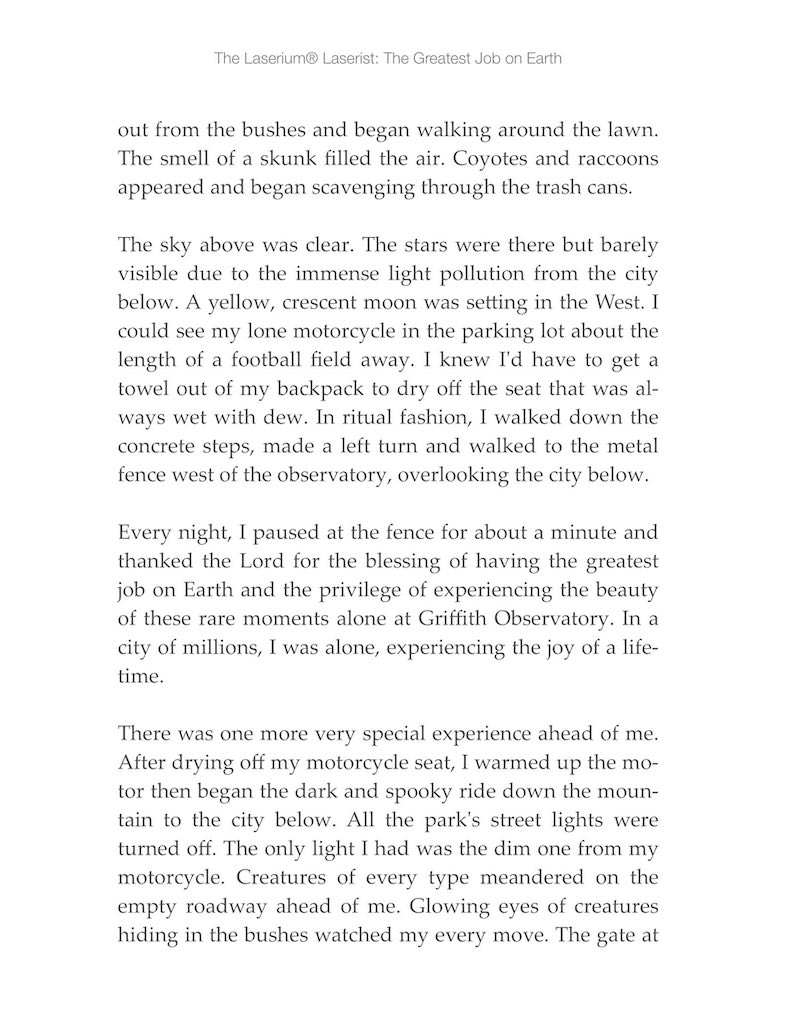
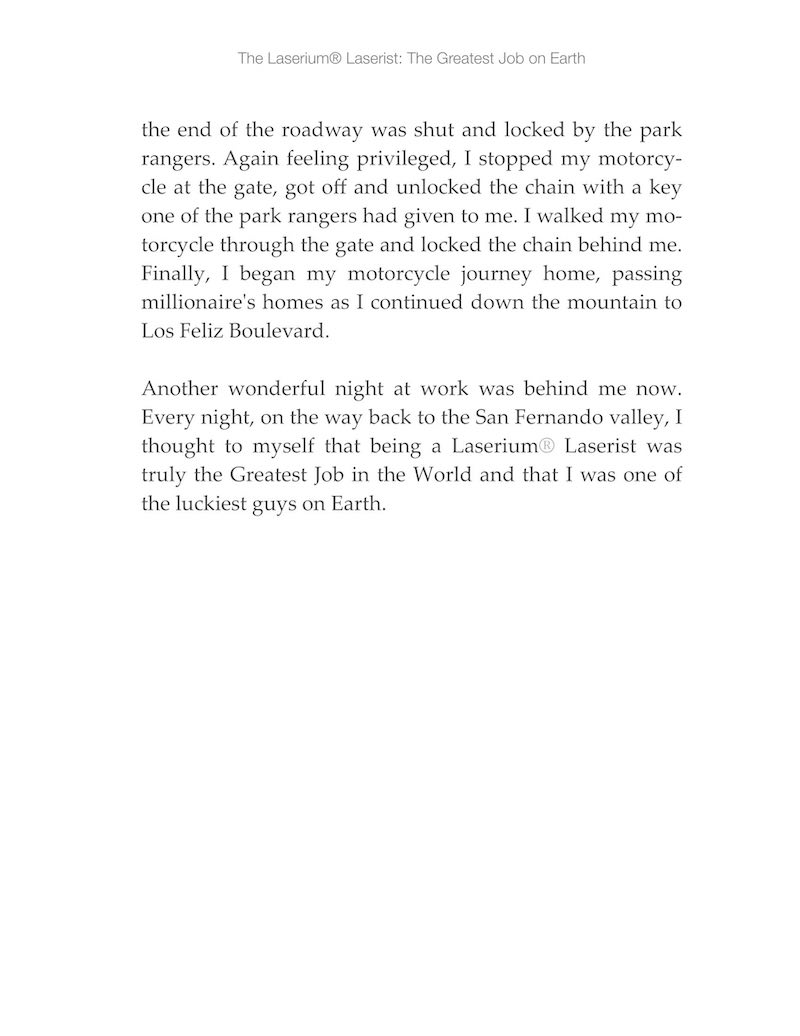
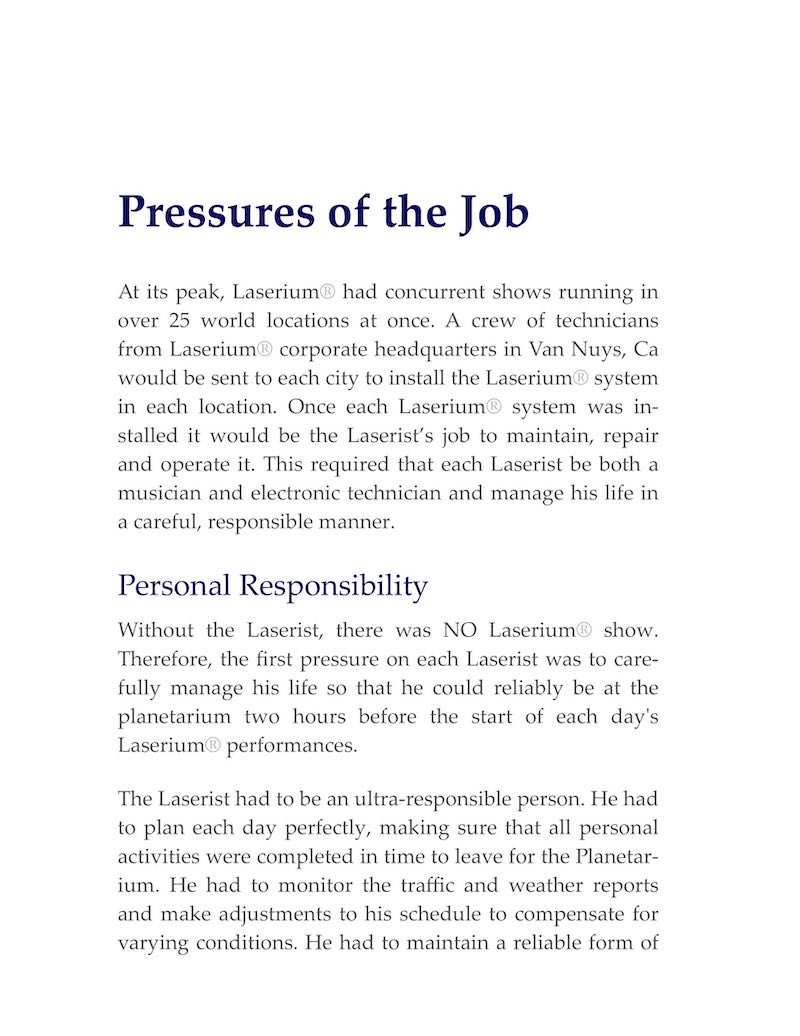
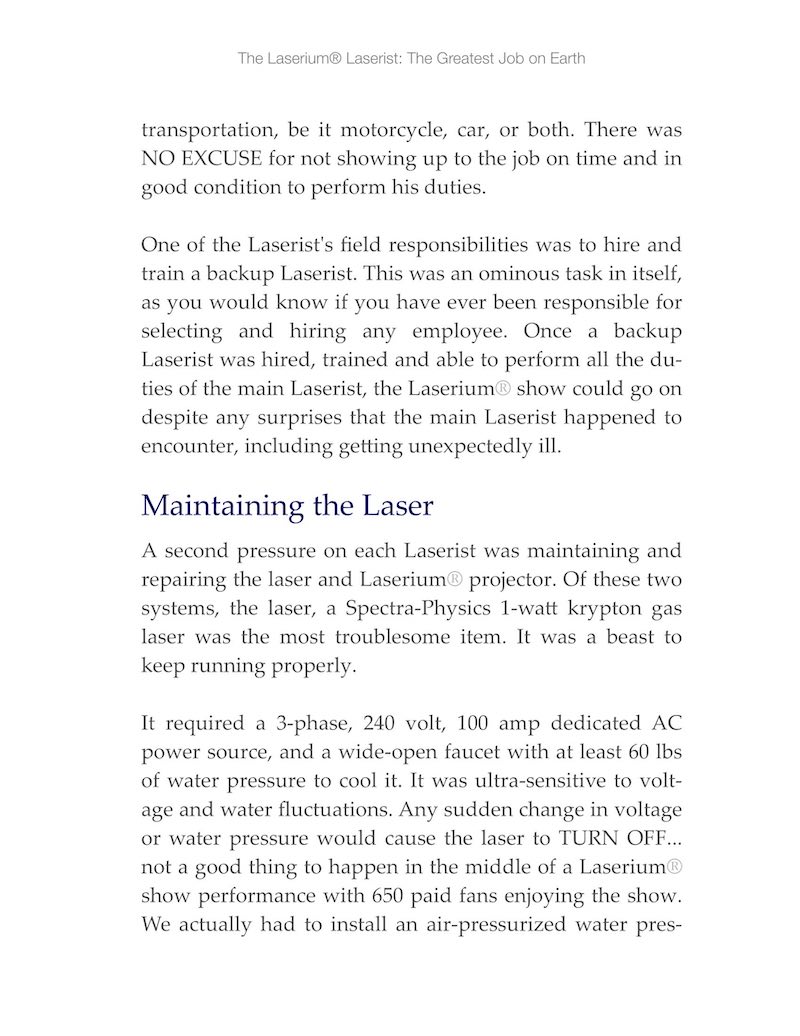
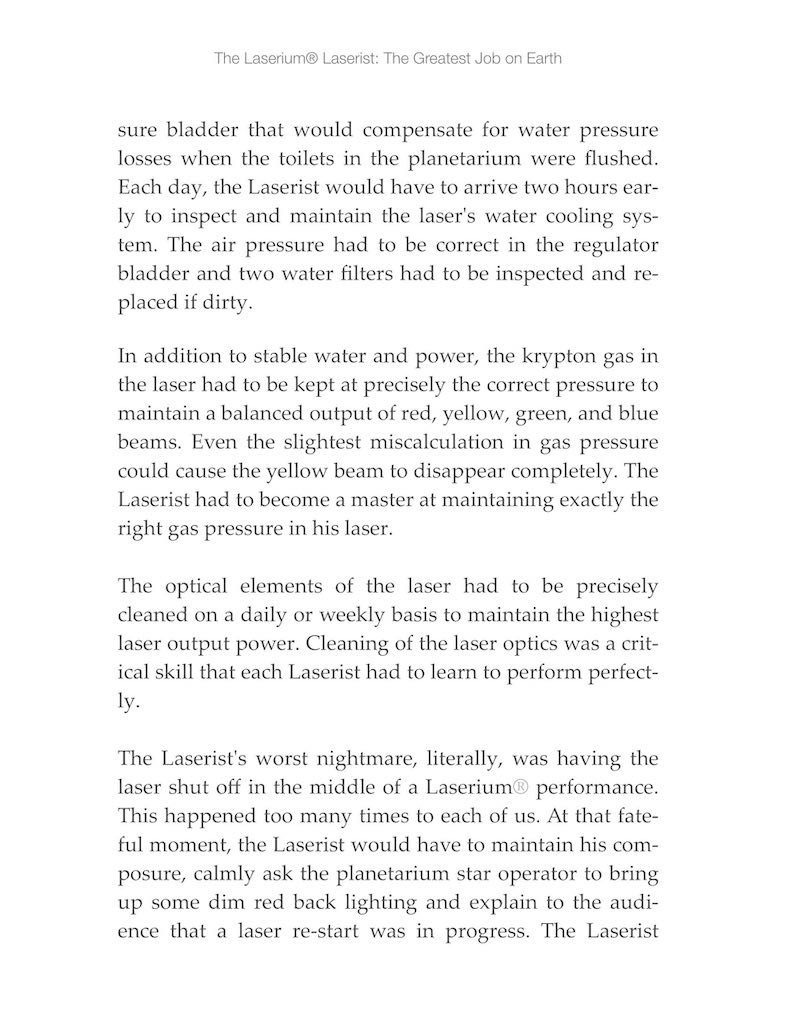
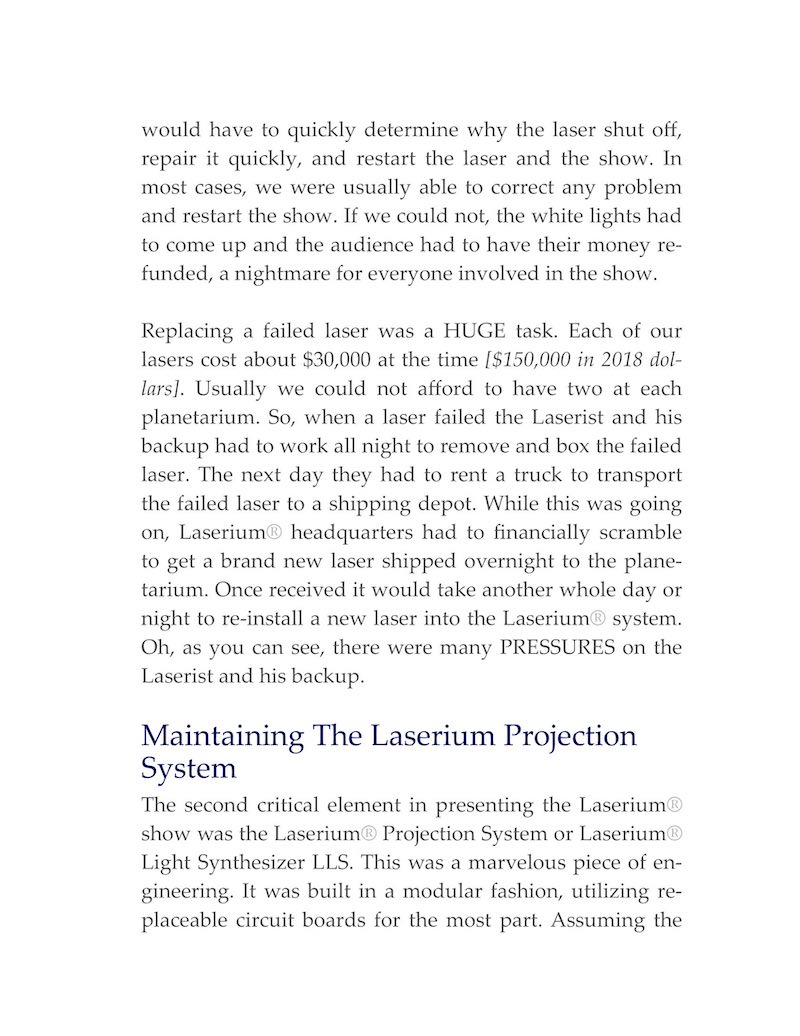
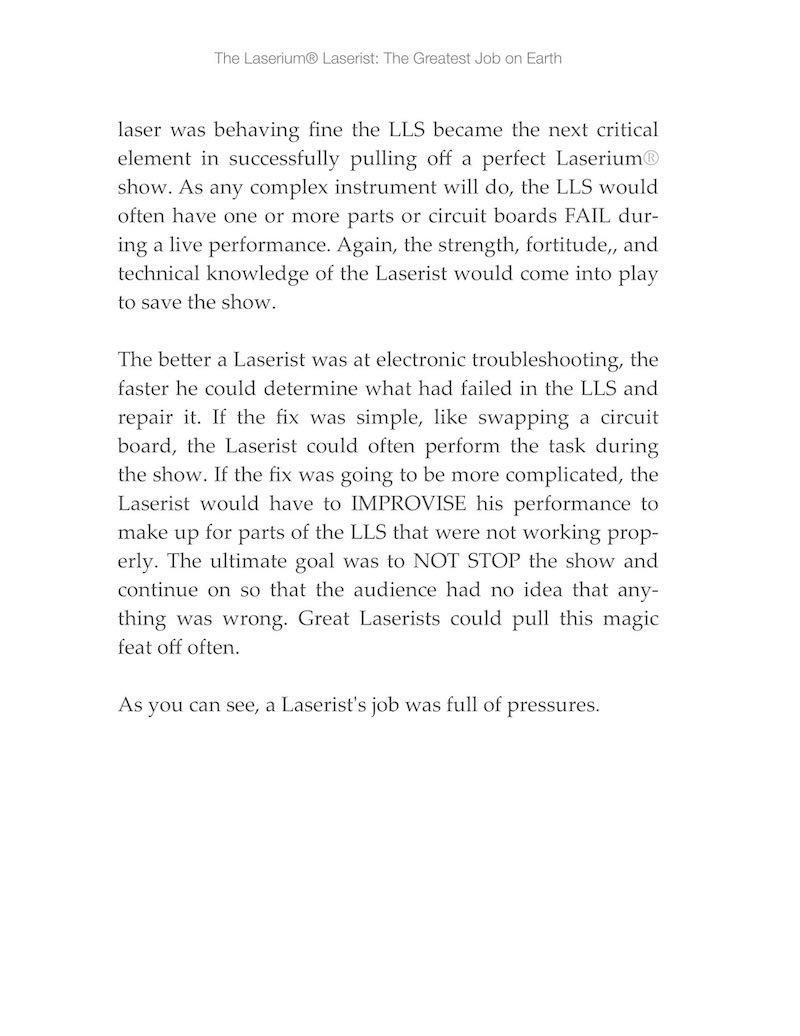
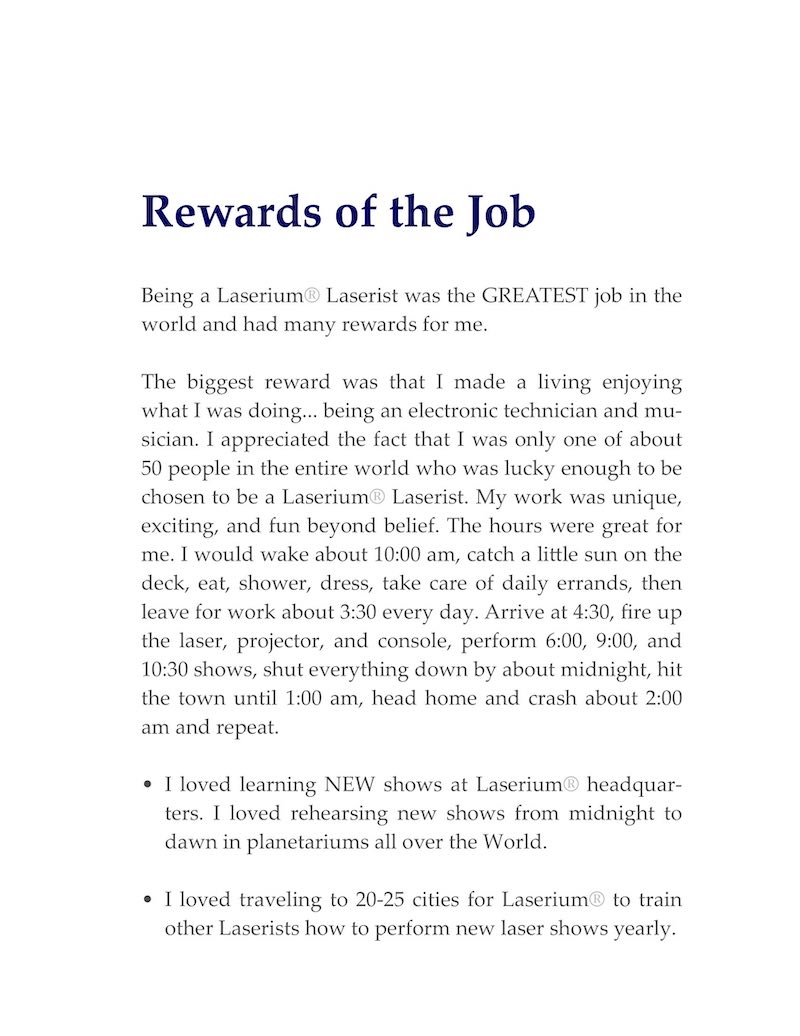
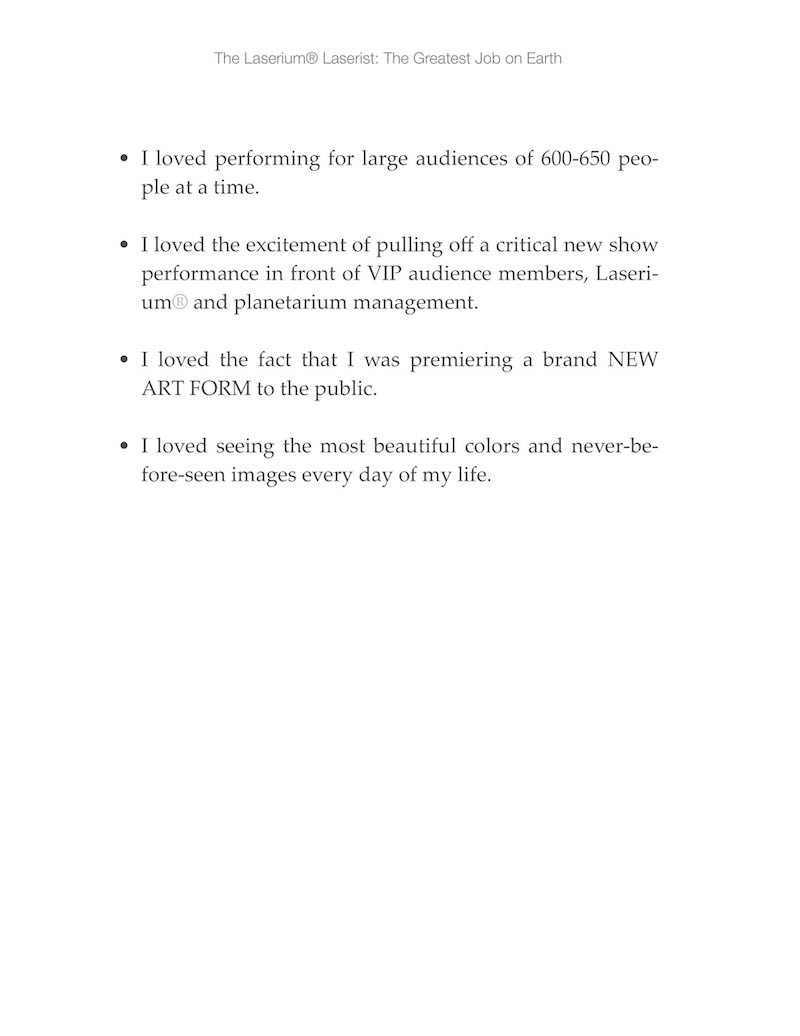
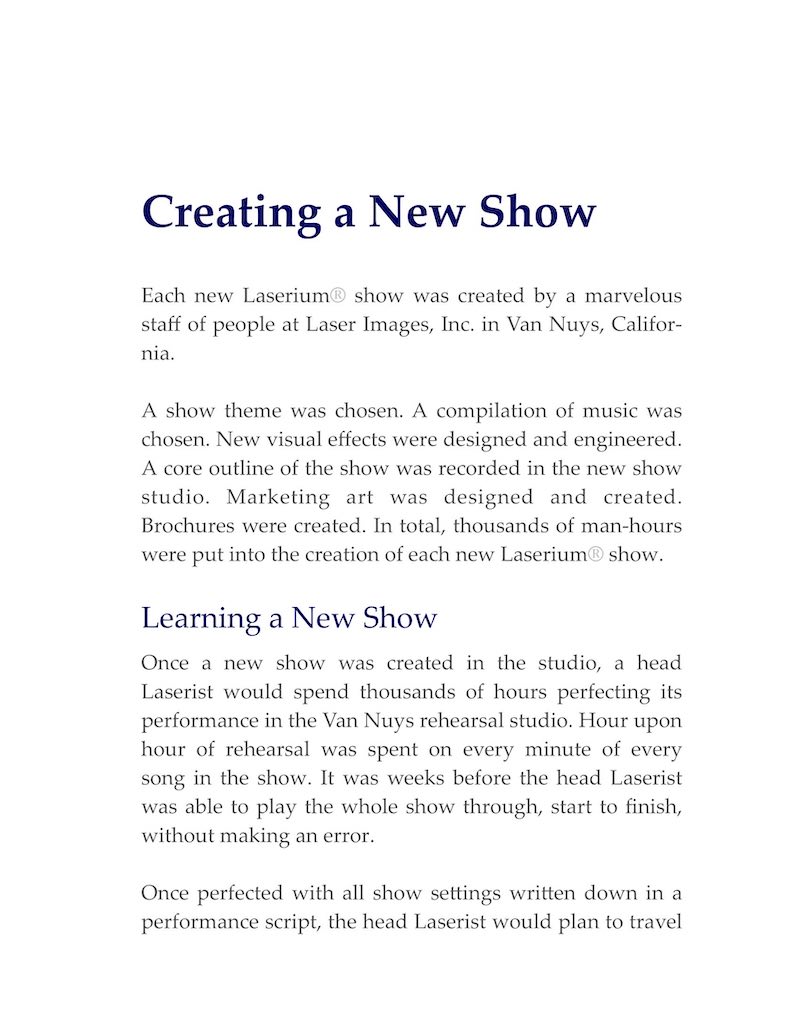
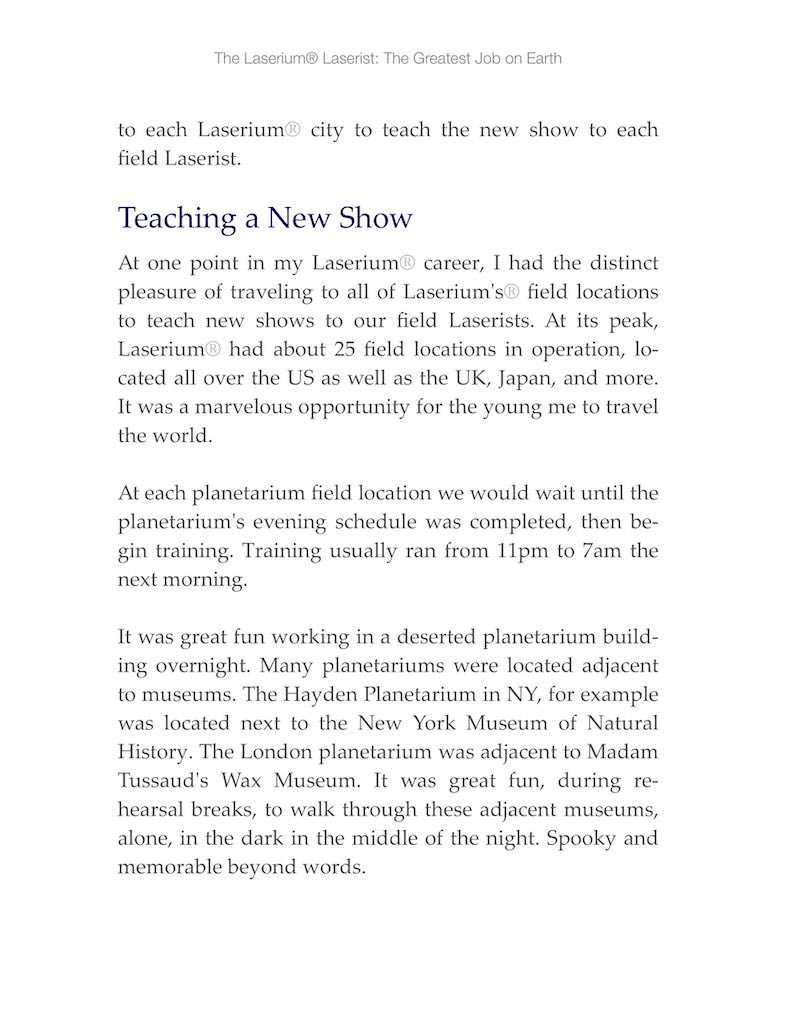
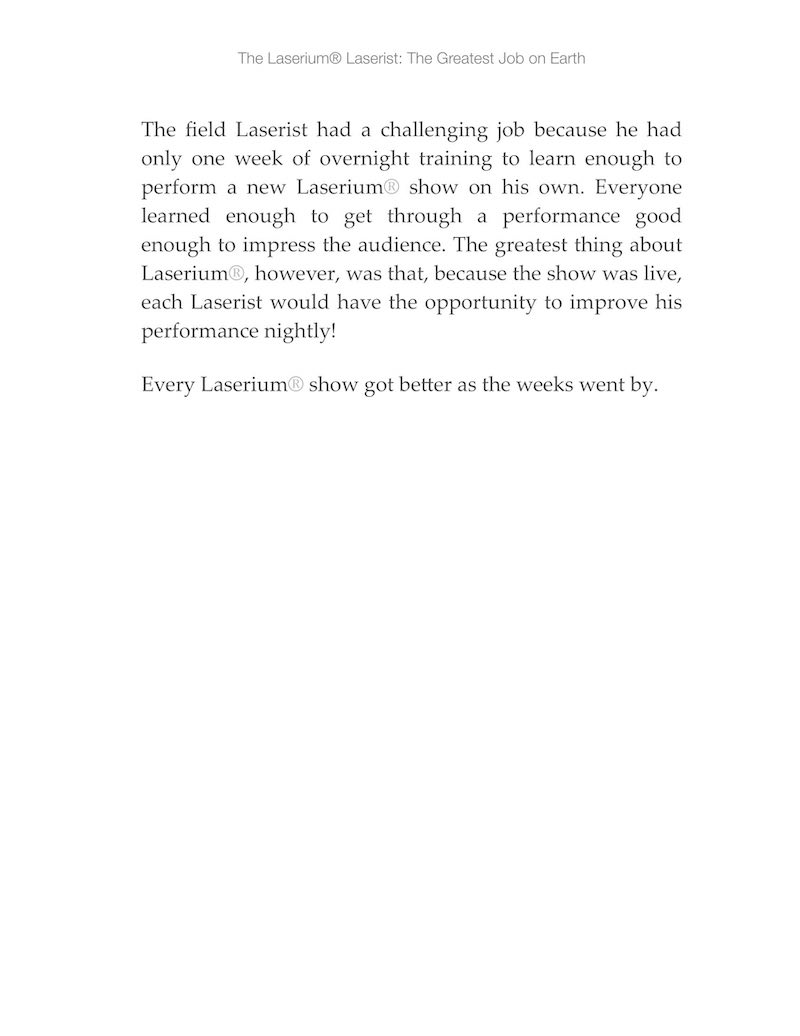
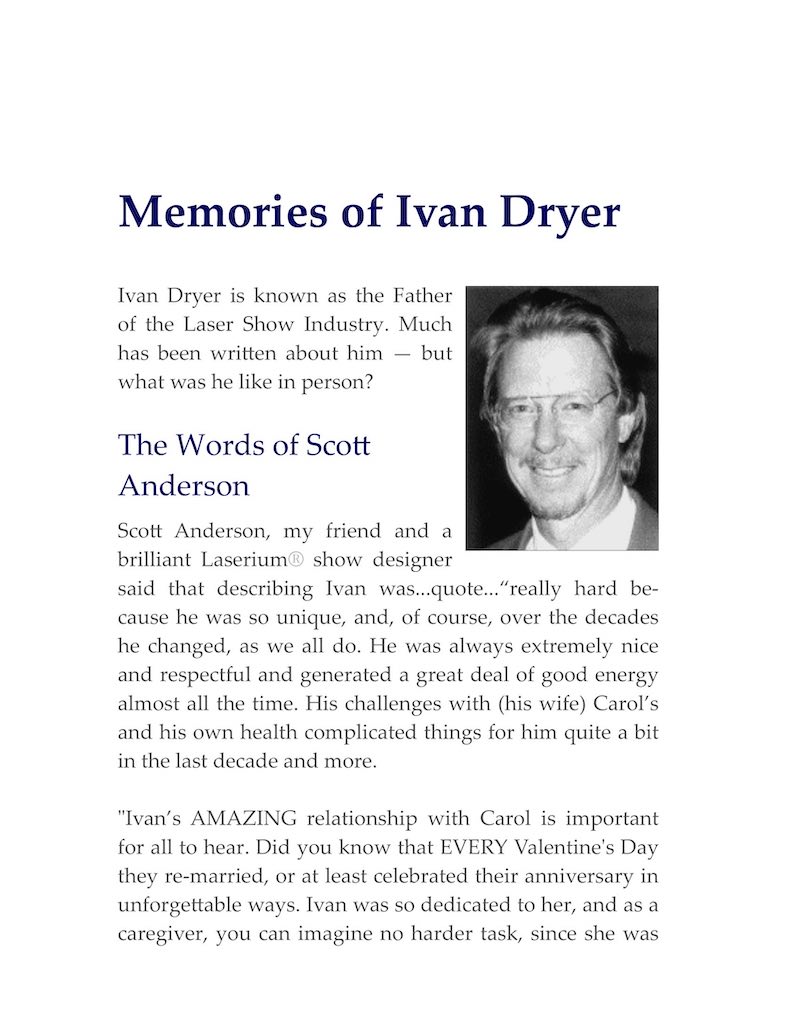
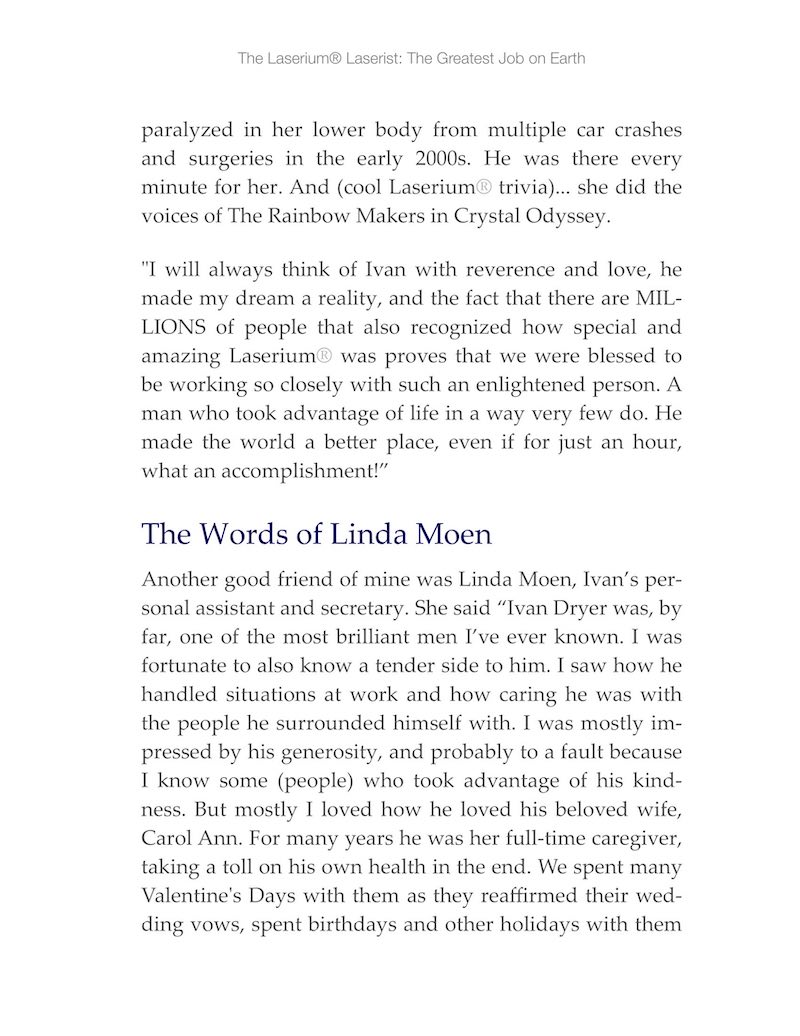
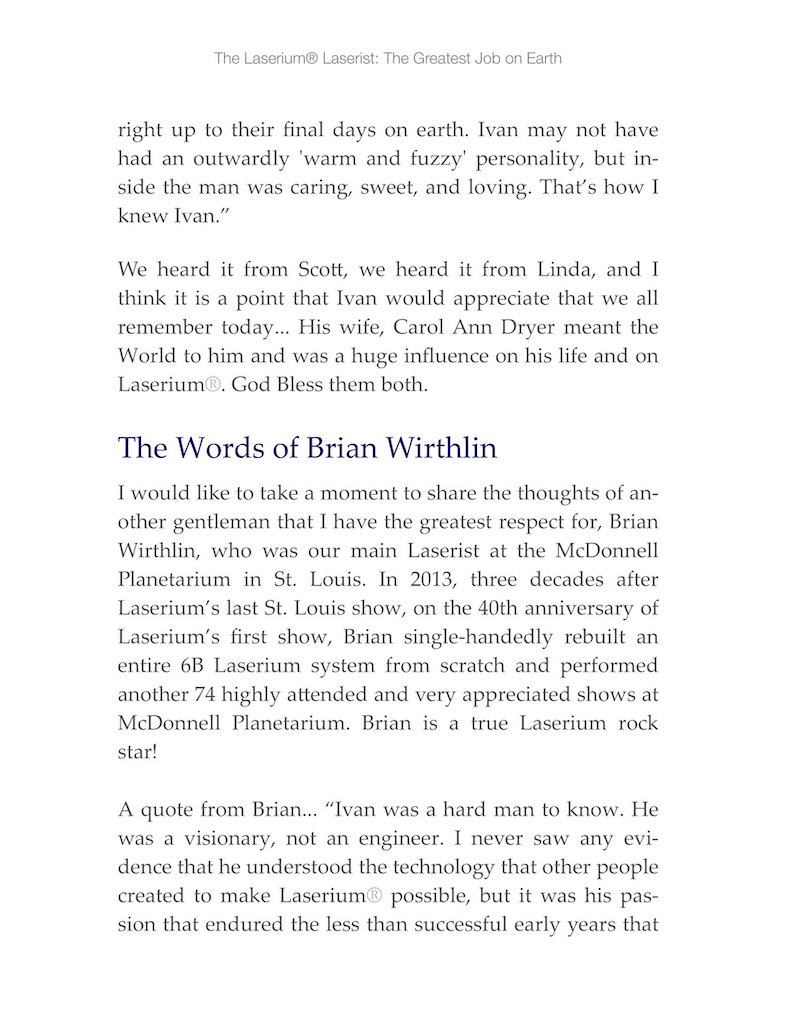
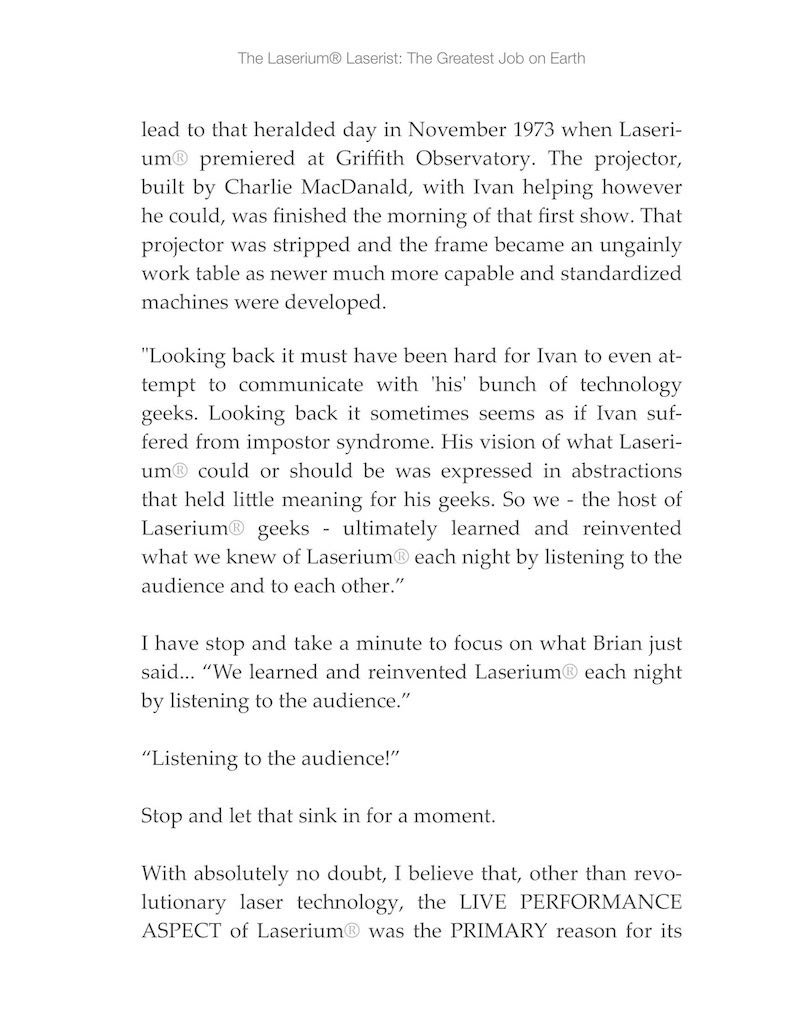
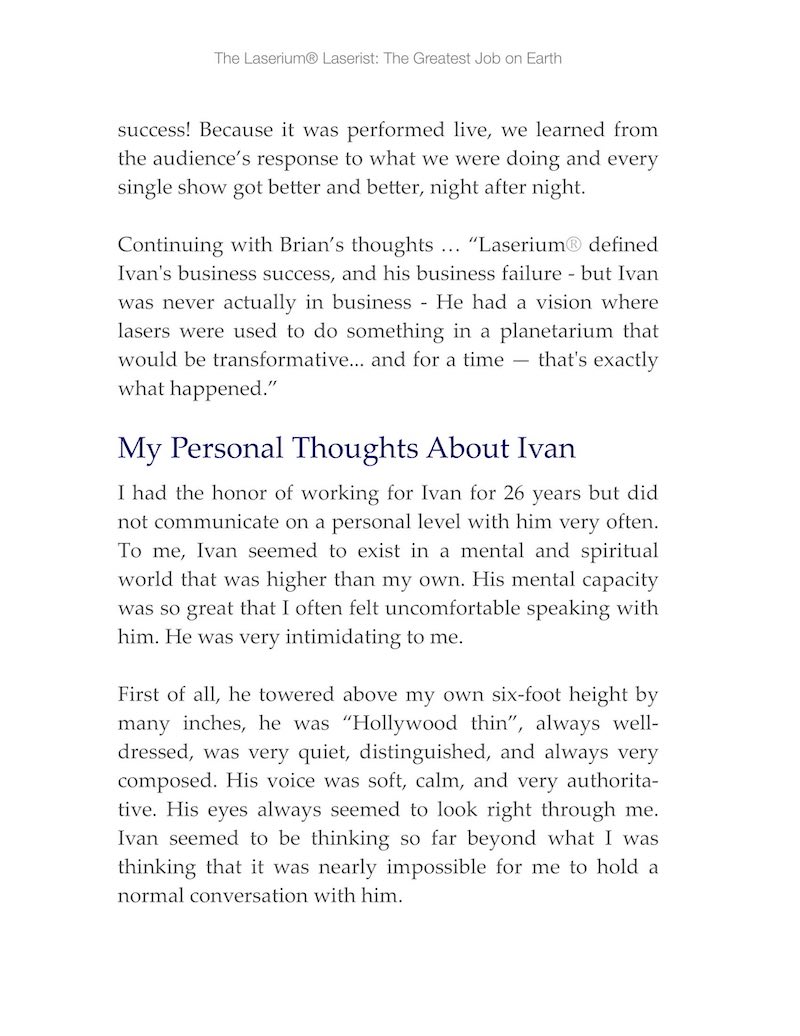
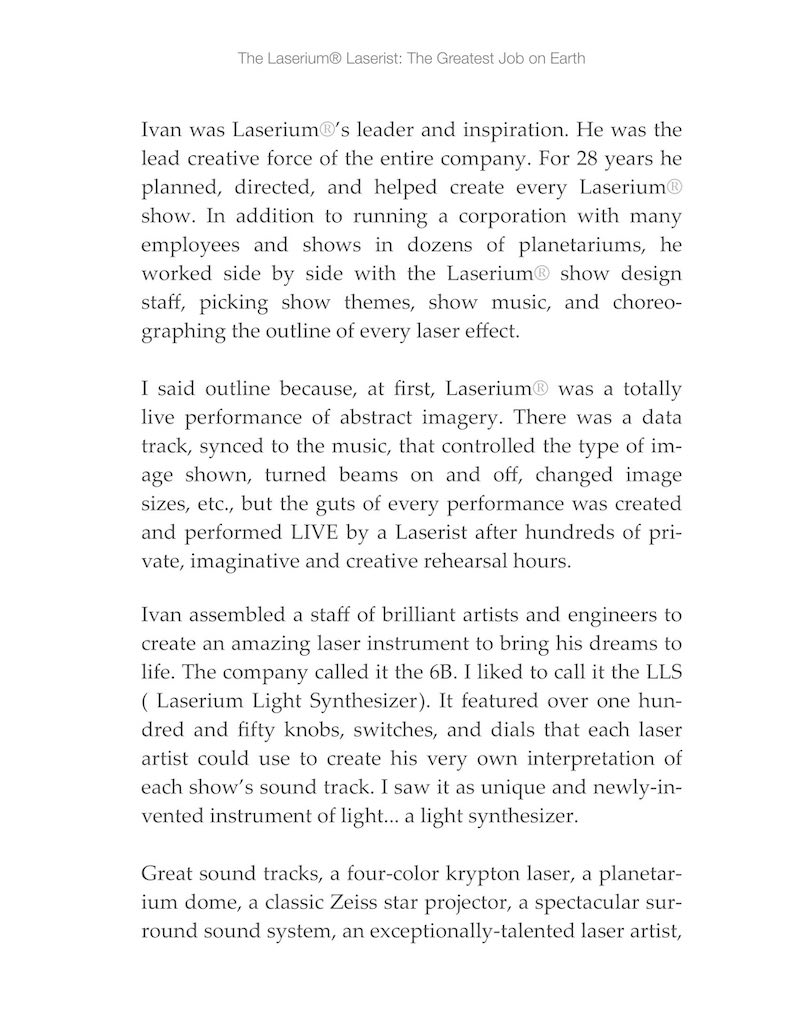
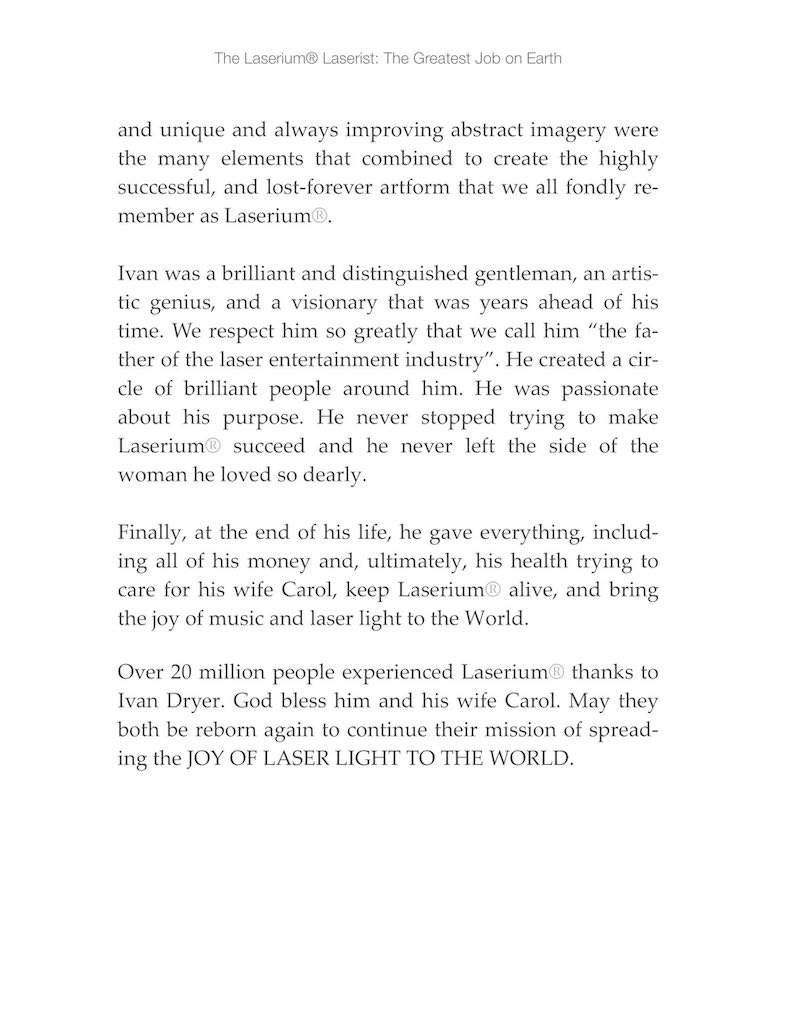
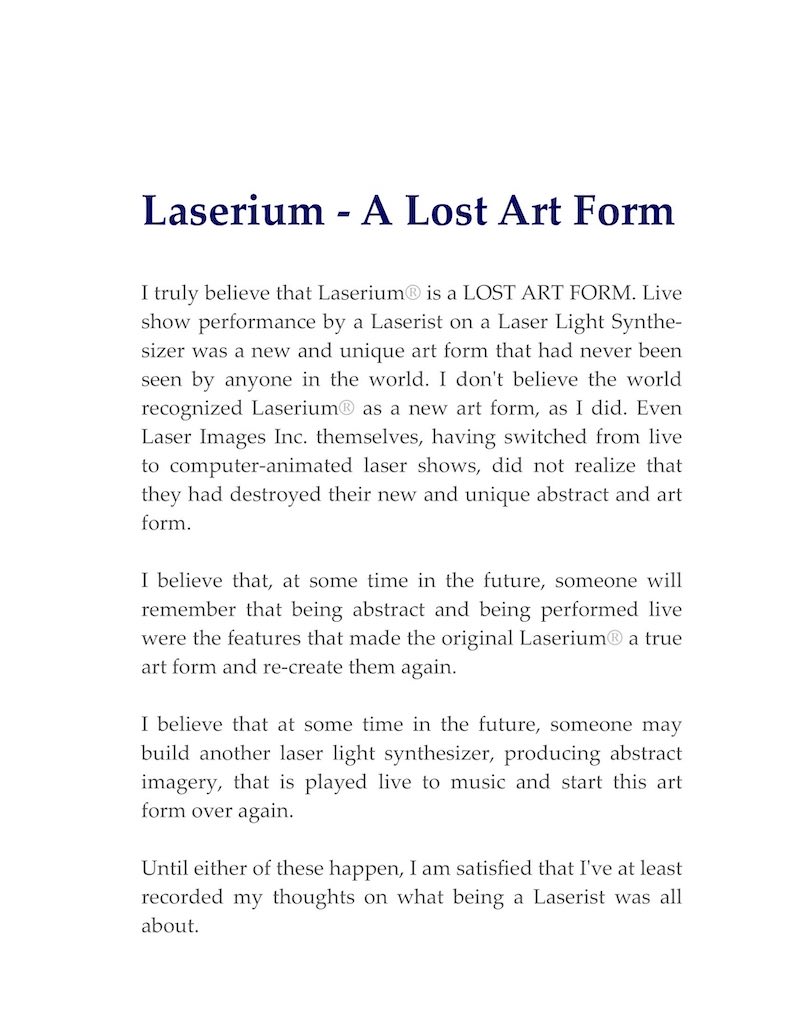
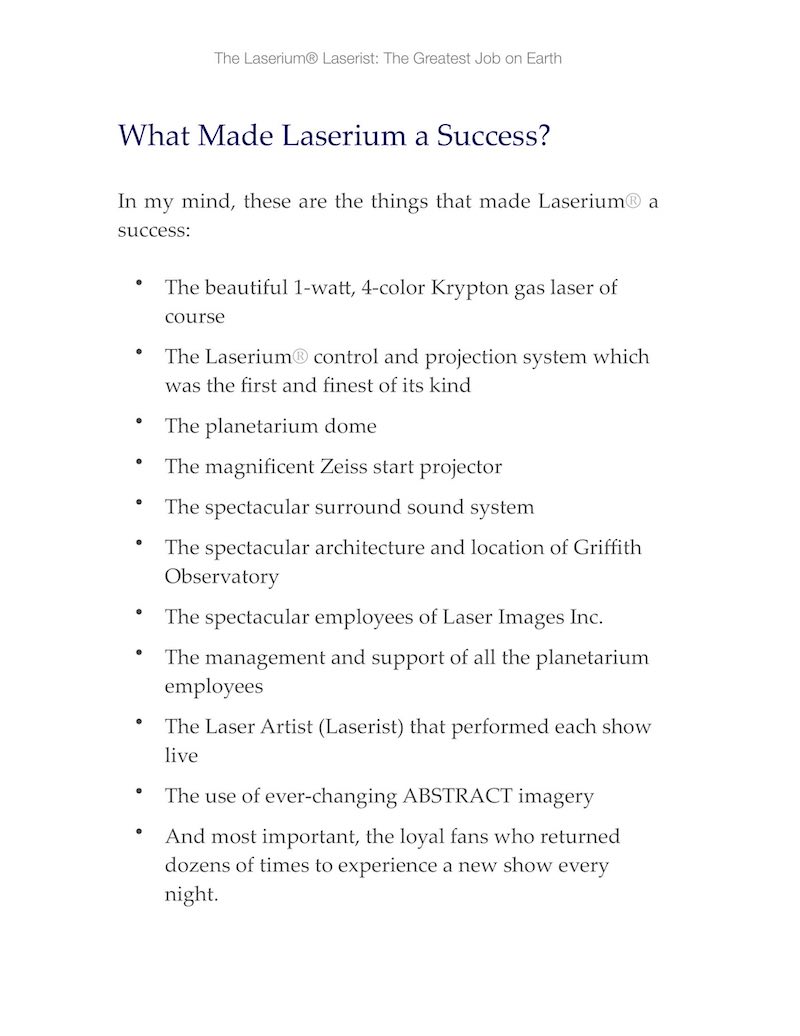
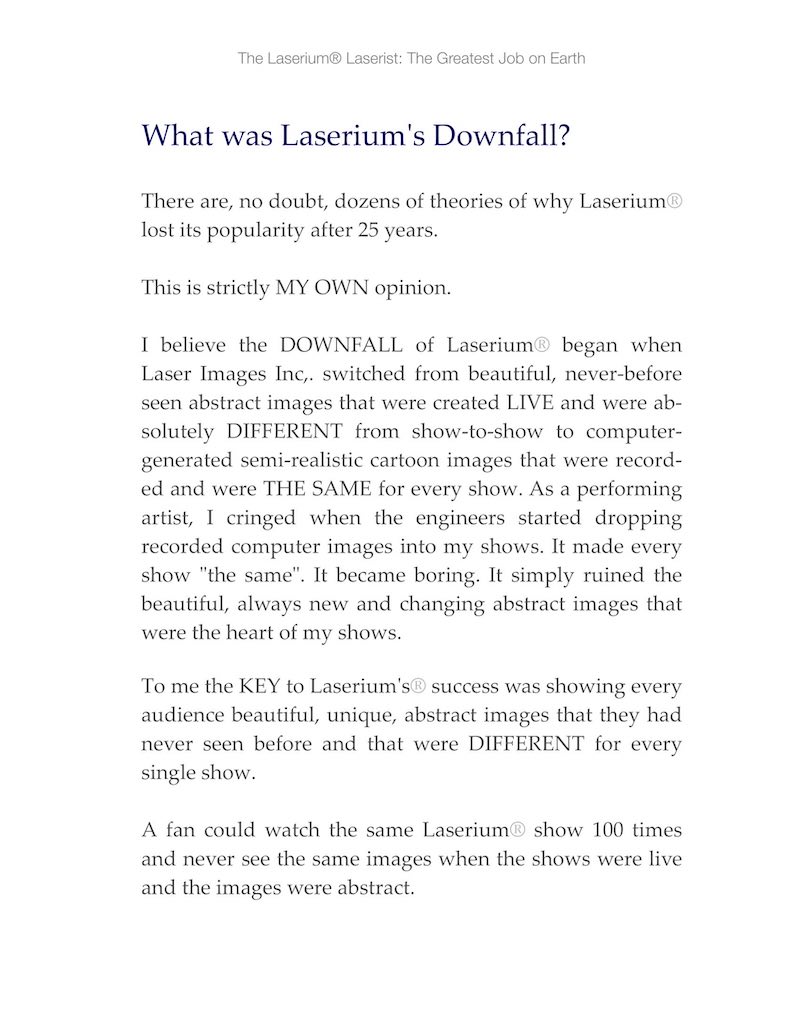
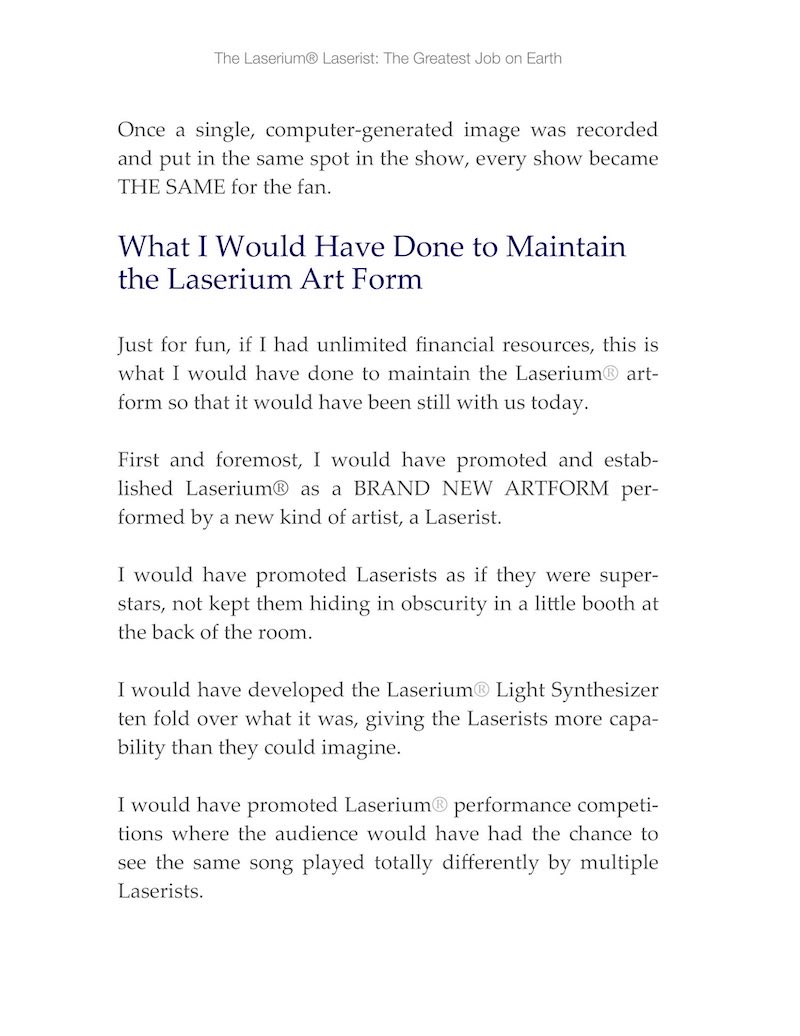
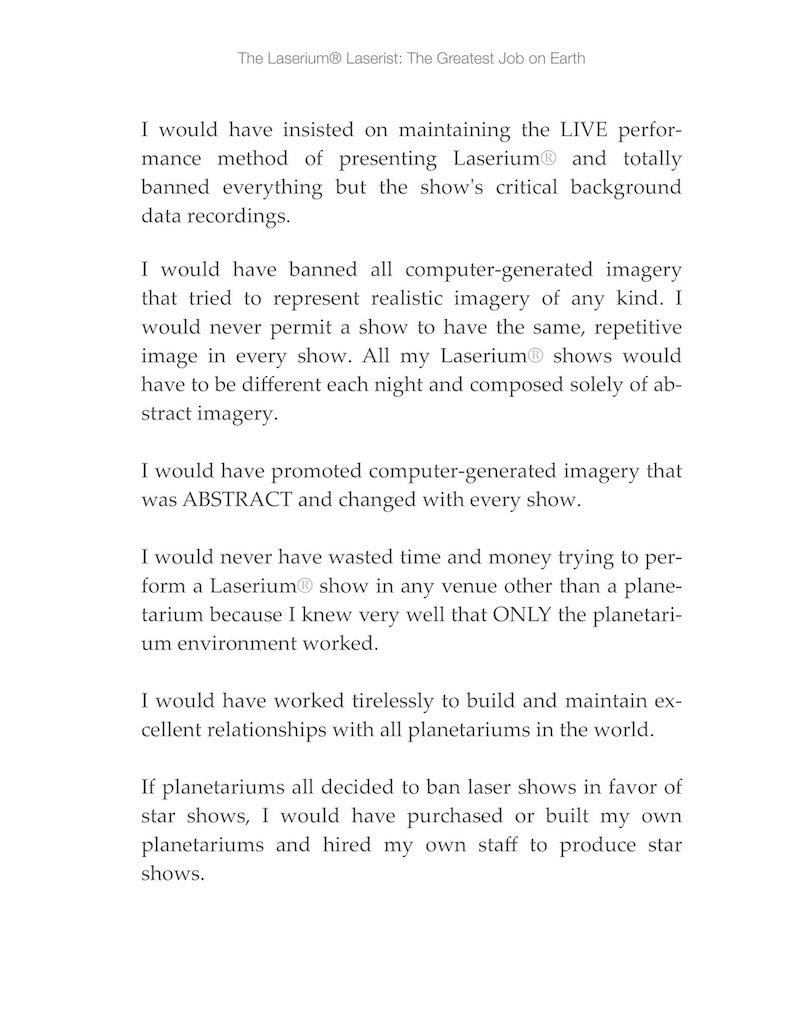
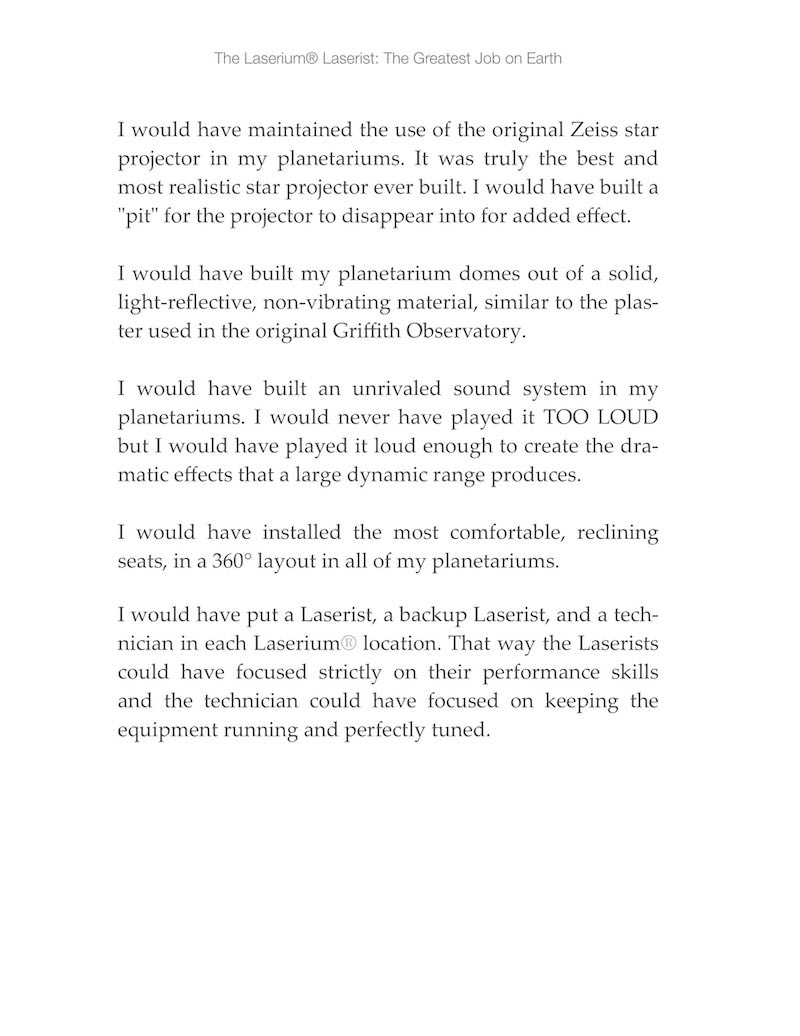
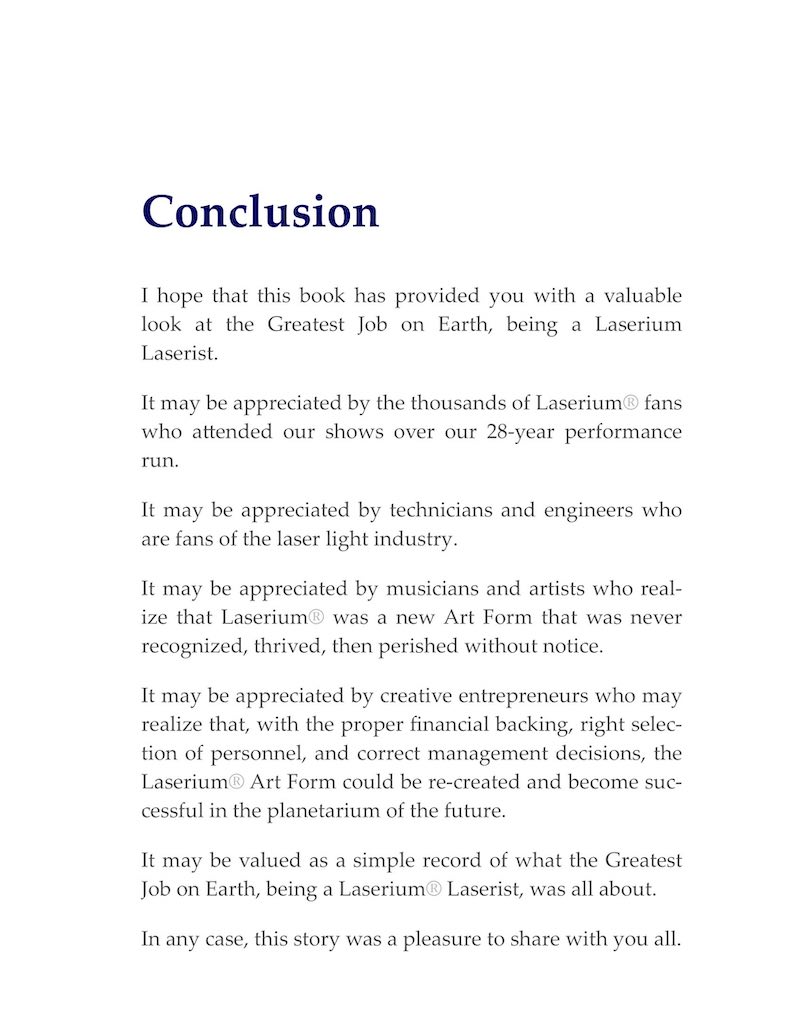

A book by Glenn Edward Thomas
Text copyright © 2018, Glenn Edward Thomas
This online version at ILDA.com is copyright © 2018, International Laser Display Association. While anyone may link to this page, there is no online reproduction, storage, or transmission without express written permission from ILDA and Glenn Edward Thomas.
Downloadable ePUB or PDF versions, or a printed book version, are available from FastPencil.
Laserium® was a registered trademark of Laser Images Inc. which as of 2018 is owned by LumaLaser Inc. More information about Laserium® past and present is in the links on ILDA's page about Ivan Dryer, and at the official Laserium® website.
Glenn Thomas received the 2018 ILDA Career Achievement Award at the ILDA Conference in Montréal. You can read about Glenn, and see his CAA acceptance speech, on the 2018 ILDA Awards page (scroll down to the Career Achievement Award section).
You may also be interested in an online feature-length documentary, "Laserium, the Gods of Light" which is available for rent or purchase on YouTube and on Google Play.
Table of Contents
(click to jump to a chapter)
Dedication
Introduction
What Was Laserium®?
What Was a Laserist?
Critical Laserium® Elements, an Introduction
The 1 Watt Krypton Gas Laser
The Planetarium Dome
The Planetarium Star Projector
The Planetarium Building
The Planetarium Sound System
The Laserium® Light Synthesizer LLS
The Laserist
The Planetarium Star Operator
The Planetarium Staff
The Planetarium Seating
The Laserium® Support Team in Van Nuys, California
Getting Ready for a Typical Laserium® Show Performance
Performing the Laserium® Show
Pressures of the Job
Rewards of the Job
Creating a New Show
Memories of Ivan Dryer — NEW as of 10/10/2018
Laserium® - A Lost Art Form
What Made Laserium® a Success?
What was Laserium's® Downfall?
What I Would Have Done to Maintain the Laserium® Artform
Conclusion
Dedication
Dedicated to Linda Hicks Thomas, my wife; Charles Nolan Thomas, my son; Charles, my father; Barbara, my mother; Sharon, my sister; Mark, my brother; Robin, my step mother; Ivan Dryer, creator of Laserium®; Carol, his wife; fellow Laserists; and all of my Laserium® and planetarium colleagues.
Introduction
This is a story of the Greatest Job on Earth... being a Laserium® Laserist.
I want to preface this book by saying that Laserium® is a huge subject, much of which I will NOT cover here. Its history is vast. There were hundreds of wonderful, talented people involved in creating and running it for 28 years. There was Ivan Dryer, the creator, to whom an entire book should be dedicated. There were visionaries, engineers, technicians, artists, programmers, accountants, lawyers, marketers, and more. You get the idea. It was a hugely successful and well run business.
The sole purpose of this book is to describe the Greatest Job on Earth, being a Laserium® Laserist, from my personal point of view.
I will leave it to others to write of Laserium's® history and more detailed technical aspects. I hope that you enjoy what follows.
— Glenn Thomas, 2018
What Was Laserium®?
In short, Laserium® was the very first laser light show choreographed to music on the dome of a planetarium, created by Ivan Dryer and the company he founded, Laser Images Inc. The planetarium was the famous Los Angeles landmark, Griffith Observatory.
Laser + Planetarium = Laserium® ... so cool!
To me, Laserium® was a BRAND NEW ART FORM because it was an artistic expression of light and sound that had never been seen by humans before. Each show was performed LIVE by a person who was both a musician and electronic technician on what I will call a "Laserium® Light Synthesizer" LLS or console for short. Laserium® was UNIQUE among all future competing laser shows because Laserium® created the LLS as an instrument of light, played LIVE by a musical artist. Future, competing shows were mainly canned recordings from start to finish.
What Was a Laserist?
laserist = no dictionary results
That's what you will get if you search for the name of the greatest job ever on planet Earth.
Apparently, the world has never acknowledged or remembered that Laserium® created a NEW ART FORM and that this new art form was performed, live, by a Laserist ... a Laser Artist!
This is EXACTLY the reason that I feel writing this book is so important. I was blessed to be given the greatest job on Earth for 25 years. I was a Laserist. Yet, officially, this word does not exist! When I'm gone, this book will be some record that I actually did exist, that a new art form was created, never acknowledged as such, and has since disappeared!
In my opinion, a Laserist had to have three qualifications:
- Be a great life manager
- Be a professional musician
- Be a well-trained electronics technician
A Great Life Manager
The Laserist sent to each of Laserium's® planetarium locations was solely responsible for the show's performance, equipment maintenance, and equipment repair. He was also responsible for hiring a backup Laserist in his city, and maintaining excellent public relations with the planetarium staff. This is a tremendous amount of responsibility and each Laserist had to manage his life extraordinarily well to fulfill his duties.A Professional Musician
The Laserium® Light Synthesizer LLS was a new form of instrument. It had over 150 controls that had to be played LIVE to a recorded musical soundtrack. The LIGHT that emanated from the LLS was similar to sound that emanated from a musical instrument. All the elements of playing a professional musical instrument were used by the Laserist to perform on the LLS. The BEST Laserists were also the BEST musicians. Their musical education and experience enabled them to play the LLS properly, as a musical instrument would have been played.An Electronic Technician
The Laserist had to have seriously good electronic skills because he was solely responsible for maintaining and repairing all of the sophisticated electronic systems on the LLS. He had to be able to read schematic diagrams, understand many types of electronic circuits, be able to use volt meters, tone generators, oscilloscopes, and more. He received massive amounts of support from the Laserium® corporate techs and engineers but he had to know enough about electronics to communicate effectively with the home base experts.
Critical Laserium® Elements, an Introduction
Laserium® shows ran non-stop for 28 years at Griffith Observatory in Los Angeles. Griffith was the most successful Laserium® location in the World. There were several CRITICAL elements that combined to make this location such a success.
The beauty and success of Laserium® came from the masterful COMBINATION of a unique set of CRITICAL elements:
- The 1-watt, Krypton gas, 4-color laser that produced the most beautiful red, green, yellow, and blue light ever seen by humans
- The huge, 360 degree planetarium dome
- The stunning star field created by the original Zeiss Star Projector
- The allure of Space created by being in a beautiful, historic, romantic planetarium building
- The powerful, 360 degree JBL surround speaker system
- The Laserium® Light Synthesizer ... LLS
- The highly-skilled Laser Artist (Laserist) who performed every show live
- The planetarium's star projector operator
- The planetarium staff
- The planetarium seating
- The Laserium® support team at Laser Images Inc. in Van Nuys, Ca.
I will discuss each of these elements, in detail, in the following chapters.
The 1-Watt Krypton Gas Laser
The Spectra-Physics 1-watt krypton gas laser was the star of the Laserium® show. The raw beam from the laser appeared to be white. When the main beam was passed through a prism it emerged as four discrete beams... red, yellow, green, and blue. These were the purest and most beautiful beams of light that humans had ever seen. The Laserium® Light Synthesizer (LLS) was designed to produce the most spectacular light show ever seen utilizing the beams of the krypton gas laser.
The Spectra-Physics krypton gas laser required massive amounts of power and water to operate. It needed a 220 volt, 3-phase power line and required a wide-open water faucet for cooling water.

A water-cooled Spectra-Physics ion laser (with power supply), similar to that used in the Laserium® Light Synthesizer. In the LLS, the laser was mounted vertically.
This laser was the most troublesome piece of equipment that Laserium® used. It was a massive challenge to keep it working properly for daily operations.
The Planetarium Dome
The 75-foot diameter dome of Griffith Observatory was CRITICAL to the success of Laserium®. First, it was one of the world's largest domes. That permitted the projected laser images to be immense in size and very impressive to the audience.
Second, the Griffith dome had the advantage of being constructed of plaster. This type of construction was the BEST for Laserium® for two reasons:
- The plaster dome had no HOLES or perforations, as do many planetarium domes today. Every hole in a dome causes a loss of reflected light. Griffith's plaster dome reflected 100% of the laser light, making the show brighter and more spectacular for the audience. It also reflected 100% of the light from the magnificent Zeiss star projector, creating one of the most realistic and brightest star fields possible.
- The plaster dome did not RATTLE as do many planetarium domes that are constructed of perforated aluminum. The dynamic musical scores of the Laserium® show could be presented powerfully without the audience hearing any annoying rattles.
Over the years Laserium® presented its shows on many different types of reflective surfaces; large flat movie screens, huge, curved IMAX movie screens, walls of buildings, water, etc. Nothing EVER came close to working as well as the huge, plaster, Griffith Planetarium dome. This dome was a critical element in Laserium's® success.
The Planetarium Star Projector
Another CRITICAL element to Laserium® at Griffith Observatory was the 1964-vintage Zeiss Mark IV star projector. By projecting a magnificent and very realistic star field on the huge 75 foot plaster dome, the Laserium® audience was magically transported to a night time outdoor location under the stars as soon as the planetarium house lights were turned off.
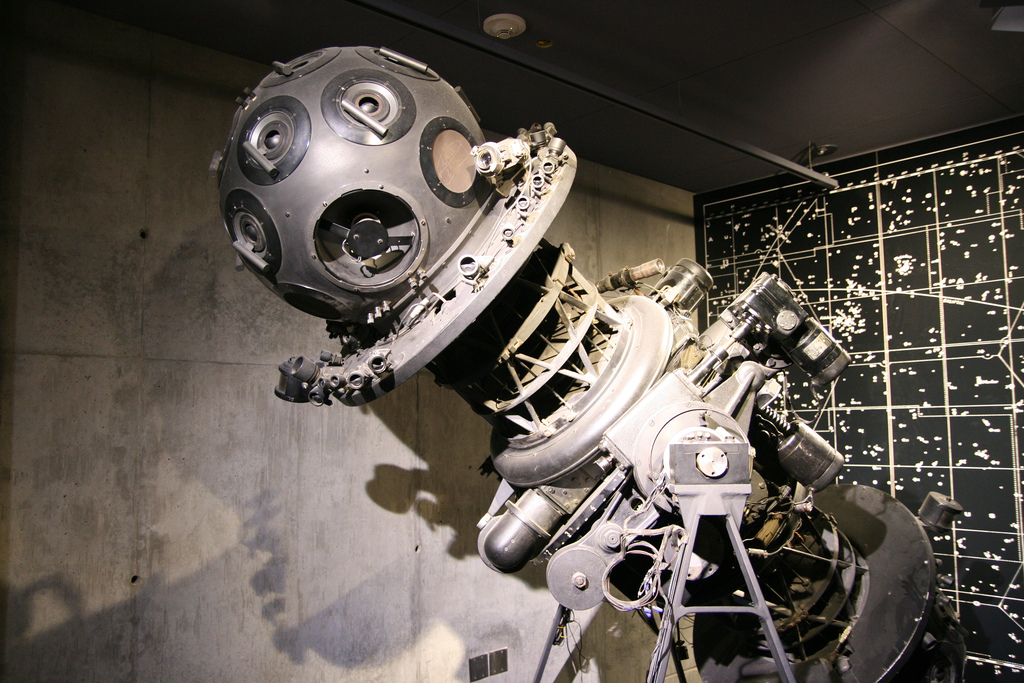
Griffith Observatory's now-retired Zeiss Mark IV, by Marc Levin via Flickr, CC by 2.0
One of the GREATEST moments of every Laserium® show was when the stars first appeared. If timed perfectly, the audience would burst into huge applause when this happened. It was a mind-blowing moment.
The best way to choreograph the first appearance of the stars was to turn the stars on while the dome was illuminated by the house lights, then time the dimming of the house lights perfectly with a crescendo in music that was specifically chosen for this event. At the peak of the crescendo the house lights would turn totally off and the audience would be instantly transported to a star-filled night time sky.
The star projector's next best moment was when, at a planned time, choreographed with the music and laser lights, it MOVED the star field. Many different types of star movements were possible; slow, fast, circular while centered on the dome, north to south, east to west, quick stops, and reverse motions. At pre-planned times, the stars would be the only things "on" in the show. They were most visible when they were the only lights in the dome. This was purposely planned many times in the Laserium® show to achieve maximum impact on the audience.
Another fantastic part of the Laserium® show was when the dome was illuminated enough so that the audience could see the giant Zeiss star projector, which looked like a huge ant, spinning and twisting around in the center of the room. Again, parts of the Laserium® show were purposely choreographed to feature this.
Some planetariums actually had a pit into which the Zeiss star projector could be submerged. We would always start the show with the star projector hidden in the pit, then, on cue with lights and music, raise the beautiful monster into the view of the audience. Wild applause would always occur if this move was perfectly timed.
The Zeiss star projector was definitely a CRITICAL element in the success of Laserium® at Griffith Observatory... especially when expertly controlled by a star operator who cared about making the Laserium® show the best it could be.
The Planetarium Building
The Planetarium building was so critical to the Laserium® show that its name is part of the Laserium® name... Planetarium + Laser = Laserium®
From Wikipedia, "A planetarium is a theatre built primarily for presenting educational and entertaining shows about astronomy and the night sky, or for training in celestial navigation."
Before Laserium® premiered at the Griffith Observatory, a dedicated planetarium staff created such educational and entertaining shows and presented them in one of the most magnificent planetarium buildings in the world.
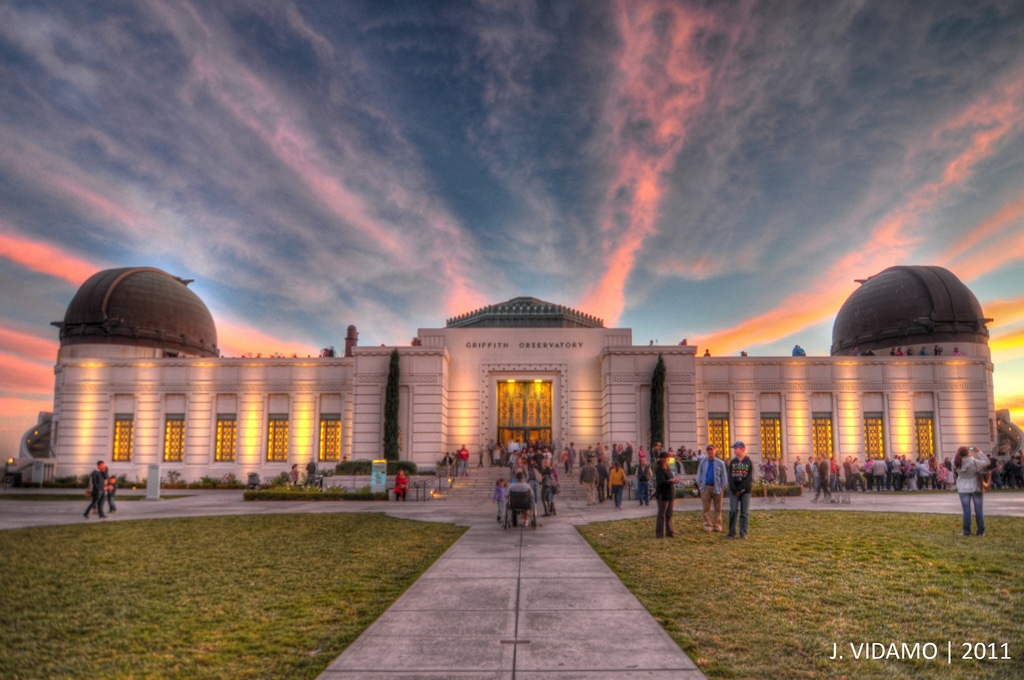
Griffith Observatory, by Justin Vidamo via Flickr, CC by 2.0
Attendance for these educational shows was dismal, to say the least. Very few people in the city of Los Angeles felt motivated to come to this beautiful building or attend these shows. The Griffith dome could seat about 600 people but many times there were only 5-10 people attending a show. The public was not excited about Griffith Observatory.
When Laserium® premiered on November 19, 1973, the Griffith Observatory became a major Los Angeles entertainment destination overnight. Within weeks of opening, crowds of people were lining up outside the doors to see this brand new art form, laser light images, choreographed to music that people had never seen before. Nearly every Laserium® show was sold out at a capacity of 600 people per show. Being attracted by the Laserium® show first, may people also decided to attend the planetarium's educational shows and the planetarium's business boomed.
The planetarium represented research, knowledge, and education about space, the universe, and the stars. Presenting Laserium® in such a building gave it a special, unique persona as being something wonderful, spectacular, and related to the exploration of space and the universe. Presenting Laserium® in the planetarium made it very "cool"!
Working at Griffith Observatory on a daily basis, it soon became apparent to me that the planetarium staff actually RESENTED Laserium® and they denied, even to this day, that it was the Laserium® show that increased its business ten-fold in the 70s and 80s. They were proud of the educational aspect of their institution and did not like the fact that their beloved planetarium building had become home to the greatest "Light Show" the world had ever seen or that they were forced (by the city of LA) to manage the hundreds of thousands of people flowing through their doors to see Laserium®.
The Planetarium Sound System
Another CRITICAL element of the Laserium® show was the planetarium's sound system. It was, after all, a light show choreographed to music. The better the sound system, the better the show was. A spectacular JBL surround sound system was used at Griffith Observatory. I don't mean surround sound in the 7.1 sense... It was a stereo JBL system with about 16 speakers, placed behind the audience in a 360 degree pattern, powered by several powerful stereo amplifiers.
As a musician and artist, I knew that the audience would enjoy the show more when excellent dynamic volume range was used. There were parts of each show that were so soft that you could hear a pin drop in the theater. To contrast that and build audience excitement I knew there needed to be sections of the show that had powerful, loud, exciting sound.
I was very aware that sound that was too loud was not a good thing, made people angry, and detracted from the positive aspects of the show. Regardless of my excellent skill in managing the show's volume level, I found myself in a constant WAR with the planetarium management. They established a maximum decibel level based on city of Los Angeles requirements and continually monitored what I was doing. There's nothing more distracting to a live performance than the "sound police" walking around the theater with a sound level meter. The maximum permitted sound level was too low to enable me to create the dynamic range a great performance needed. That was a shame.
The Laserium® Light Synthesizer LLS
The Laserium® Light Synthesizer (LLS) was a spectacular piece of light show engineering designed by brilliant people at Laserium's® Van Nuys, California, headquarters. It created thousands effects by manipulating the the red, yellow, green, blue, and white beams from the 1-watt krypton gas laser. It contained dozens of mirrors, pick-off arms, solenoids, scan glasses, lumia wheels, motors, shutters, etc. An entire book could be written about the Laserium® projector itself and others are more qualified than me to do that.
To me, the Laserium® Light Synthesizer (LLS) was an INSTRUMENT OF LIGHT. It was composed to two pieces, the projector and the control console. The projector [at left in the Laserium® patent drawing below] housed the krypton laser and all the optical effects. The console [at right] controlled the projector. I controlled the console and played it as one would play a musical instrument. The FOCUS of my entire career with Laserium® was mastering console performance techniques to achieve the best shows possible.
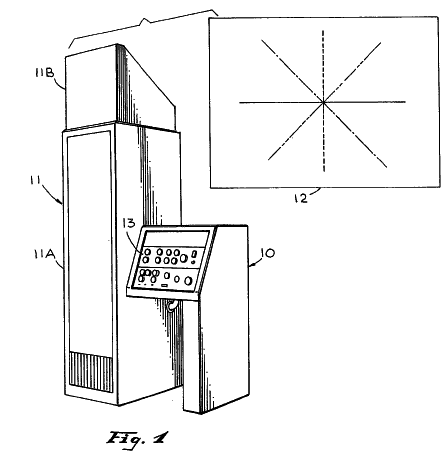
The ONE THING that set Laserium® apart and above all other laser shows, was that the Laserium® Light Synthesizer was designed to be played LIVE, in real time, by a musician like myself. I rehearsed each show for thousands of hours before I presented it to the public. Then, even after becoming expert at performing each song, I continually IMPROVED the show by experimenting with new ideas, measuring the audience reaction, keeping better ideas, and dropping things the audience did not react positively to.
The Laserist
The word LASERIST means LASER ARTIST.
A laser artist is a musician and an electronic technician. Laserists had to have the technical skills to operate, maintain, and repair the krypton laser, Laserium® projector and Laserium® console. Laserists also had to utilize their musical skills to perform each Laserium® show live before an audience of up to 600 people at a time.
It was somewhat difficult to find people who were both professional musicians and electronic technicians. Laserium® managed to find about 50. At Laserium's® peak, there were about 25 Laserists and 25 backup Laserists. The better the Laserist's technical skills, the better the equipment ran. The better the Laserist's musical skills, the better the Laserium® performance was. The perfect Laserist was a master at both electronics and musical performance.
I was trained from grade-school through college in both electronics and music. I built my first Heathkit shortwave radio at age 9. I worked in the engineering department of several companies, including Northrop Electronics and Kodak. I was a professional trombone player. I played in orchestras, jazz bands, rock bands, and parade bands. With these combined skills, I was able to keep my Laserium® laser, projector, and console working well and I enjoyed performing shows immensely.
The Planetarium Star Operator
How and when the Zeiss was used had a huge impact on every laser show. The Zeiss was manually controlled by a member of the planetarium staff during every Laserium® show. This star operator had to work closely with the show's laserist to achieve the maximum impact on the audience. The star operator followed a written script that was prepared by the laserist. Many star operators actually rehearsed the show, after hours, with the laserist to perfect their Zeiss control performance. The attitude and skill of each star operator varied greatly from night to night. Some enjoyed the job and worked well with the laserist. Others were disgruntled and didn't care if they did a good job or not. The Laserium® show was best when the laserist and star operator worked well together.
The timing of the house light dimming, at the beginning of each show, was critical and performed by the star operator. Great star operators would nail it every time. Indifferent star operators would mis-time the cue and blow one of the very best moments of the Laserium® show but not give a crap about it. All Laserium® shows would have been much better if the laserist was given total control of the star projector. Unfortunately, that never happened.
The Planetarium Staff
The planetarium staff were a CRITICAL element of the show and their personal attitudes played a huge part in whether it was a good or bad day at Laserium®.
It seemed that the higher the person's rank in the planetarium management, the more they disliked Laserium® and anything to do with it. I'm sure they did not want anything to do with Laserium® and hoped for the day that it would be gone from the planetarium. Some of the management did everything they could to detract from the show and from my performance.
In most cases, the lower-ranked planetarium employees were there to make a living and enjoy themselves. They were much more supportive of creating a great atmosphere for the audience and helping perform the best Laserium® show possible.
There were quite a few planetarium "guides" that worked very well with me. They helped move people in and out of the theater, took tickets, made opening speeches, and operated the Zeiss star projector in the best way possible.
The Planetarium Seating
The 360 degree, circular layout of the Griffith Observatory seats was critical to enhancing the enjoyment of the Laserium® shows. Much of the laser imagery was centered at the top of the dome and appeared to move downward towards the audience as the images were enlarged. With 360 degree seating, everyone had the perfect view of this effect.
Each Griffith seat reclined perfectly so that the viewer's eyes were centered towards the center of the dome. Each seat had a functional but uncomfortable wooden head rest.
The Laserium® Support Team in Van Nuys, California
Laserium® was created and supported by an incredible group of personnel at Laser Images Inc.'s corporate headquarters, located in Van Nuys, California.
Electronic, mechanical, and software engineers designed and built every part of every Laserium® projector from scratch. At the peak of Laserium's® success the Van Nuys offices were a wonder to behold. The building was full of rooms dedicated to one purpose or another. There were projector and console assembly rooms, circuit board design and assembly rooms, a show creation studio, several laserist practice studios, management offices, marketing offices, lunch room, recreation room, etc.
When I worked there, everything was brand new, clean, and spectacular.
When located in the field, I depended highly on the support staff in Van Nuys to keep my Laserium show running. I would consult daily with the engineering staff to help me troubleshoot and repair my Laserium® system. The shipping staff was busy sending me replacement parts on a weekly basis. Their toughest job was sending me replacement lasers when I needed them.
The Van Nuys staff were the heart of Laserium® and were critical to all field operations.
Getting Ready for a Typical Laserium® Show Performance
This will be a fun chapter. I will enjoy telling you what went on in a Laserist's typical day. You may be surprised at how complex it was to complete.
Let's discuss a typical Laserium® show performance at Griffith Observatory, in Los Angeles.
The Day Begins
Each day begins with me waking about 10:00 in the morning (having stayed up until 2:00 am the night before).I am a sun lover so, I usually fix a small breakfast with orange juice then go outside to lay in the sun until about noon. At noon, I clean up the apartment from the night before, shave, shower, and dress. While dressing I keep my ear on the news radio stations to keep tabs of the traffic and weather that may effect my journey to the planetarium today
From 1:00-2:00 I take care of general office work like paying bills, ordering supplies for my electronics hobbies, etc. Today the weather is good and there are no traffic jams reported so I determine I can safely leave my apartment at 2:30. This will put my arrival time at the planetarium at 4:00, two hours before my first show starts. I have three shows to perform tonight; 6:00, 9:15, and 10:30.
It is a Friday, so all three shows will typically be sold out at 650 people per show or 1,950 for the night. The pressure is ON for me to show up on time and perform my duties successfully to keep everyone happy. The weather is sunny and warm so I've decided to take my motorcycle to work today. I've owned about 14 motorcycles to date and Kawasaki Ninja's have been my favorite of all.
The Journey to the Planetarium
The ride to Griffith Observatory was delightful most days. Today was no exception. The feeling of riding the fastest, best handling, best stopping motorcycle on the planet was exhilarating. I loved every twist of the throttle and every touch of the front brake. I felt like a superstar. About 2,000 people will watch me perform tonight, so I kind of am a star but the weird / maybe good part of it is that they have NO IDEA who I am. A star incognito. Kinda cool. That gives me much more freedom to live my life the way I want to.Arriving at Griffith Park always put a smile on my face. It was one of the most famous and popular places in the World. Pulling off the crowded city streets into the historically preserved nature park was soothing. Knowing that I was going to be knocking the socks off of about 2,000 people tonight inside the observatory dome in just a few hours, made me sigh a breath of pleasure. I was the happiest guy on Earth.
Finding a parking spot at the Griffith Observatory was always a challenge, unless you were driving a motorcycle. I was fortunate to have a parking place roped off for me by the planetarium security guards. That was another nice spiff of the job.
Entering the Planetarium
After parking my Ninja, I sauntered to the planetarium's huge steel and glass front doors while taking in the magnificent Art Deco architecture of the famous building. Each walk into the planetarium was a monumental moment of enjoyment for me, knowing how special this place was, how special my job was, and how lucky a person I was to have the opportunity to be there. I seriously mean EACH WALK into the building. I had one of the greatest jobs on Earth in one of the most beautiful buildings on Earth and I never took one day for granted.There was a planetarium show under way each day that I arrived at Griffith. I was very privileged to have a master key that would let me in/out of all the locked doors in the building. I used my key to stealthy slip into a small light lock area between the hallway and the theater dome. It was usually pitch black. I had to stand quietly and carefully in one spot until my eyes adjusted to the low light level before I could do anything. Once my eyes were adjusted, I had to use a small flashlight to illuminate the laser water filters and air bladder.
By the way, there were two things that I always carried in my right pants pocket, a key-chain flashlight and a small pocket knife. I used both about 50 times a day.
I checked the water filters for cleanliness and the bladder for proper air pressure. If the filters were dirty, I quietly replaced them. If the bladder needed air, I quietly added some. All the while I could hear the planetarium lecturer speaking to his audience in the next room. Next, I silently slipped into the planetarium dome, being careful not to disturb the lecturer. I unlocked the Laserium® LLS and opened the laser water valve switch with another key. I slipped back into the light lock closet and turned on the laser water cooling valves. I returned to the LLS and turned on the laser being careful that I let no light from the laser leak into the theater dome.
It was critical that I tested the laser at this point, during the planetarium lecture because, if anything was not normal, I would have to fix it before my 6:00 Laserium® show began. At this point I would sometimes sit on the floor of my laser booth and listen to the lecture until it was through. Other times I would return through the light lock and go downstairs to chat with the planetarium staff.
Final Show Preparations
When the 4:30 planetarium show ended, I stood up in my booth or returned to the dome from the basement. It was now vacant of all people and the white work lights were illuminated. It was at this point that I would continue my Laserium® show setup routine. On a typical night, I would perform three different Laserium® shows. Each show required different effect devices be installed in the LLS. We had effects stored in boxes that were labeled for each show. I took the required effects for the 6:00 show and installed them in the LLS. I ran the laser up to full power and examined the four beams, red, green, yellow, blue for strength. I positioned one effect that we called a "burn wheel" properly so that I could perform several clean burns during the shows. This was a round mylar wheel. We burned the mylar with the combined "white" laser beam on cue for a magnificent exploding light effect. There were about 25 effects that were changed between each laser show. It took me about 10 minutes to accomplish each change over.The laser was ready. The LLS was ready. I now prepared the sound system and audio tapes for the shows to follow. The sound room was located back through the light trap, across the hallway. Before every show, I went there to confirm that all the sound equipment was properly set for the Laserium® show. JBL either donated or gave us a good price on a spectacular sound system for the planetarium dome. Having great sound was imperative in a sound and light show of course.
I returned to the LLS booth and cued up the tape that contained the walk-in music and the 6:00 Laserium® show.
I met with the Laserium® star operator who sat in the planetarium console to my right. Some operators enjoyed the Laserium® show; some not so much. If it was a happy operator, I joked around a little and we both got in a good mood for the show. I handed him my star cue sheet. It was his or her job to precisely control the house lights and the Zeiss star projector during the Laserium® show.
I need to point out the fact that the star operator's performance was a CRITICAL element in the success of each Laserium® show. If their cues were perfectly executed, the effect on the audience would be spectacular. If they did't care, it showed and the audience suffered as a result of their bad attitude and poor timing.
The Audience Enters the Dome
We opened the theater entry doors at 6:10 for the twenty minute walk-in period. We lit the dome in dim white, blue, or red light depending on the mood we wanted to create that day.I loved watching the audience as they entered the magnificent domed room. It was a very impressive room and their mouths always seemed to drop open at the wonder of seeing it for the first time. The giant Zeiss "Giant ANT" star projector always was the focus of the audience's first attention. Many people walked in and circled around it in amazement. As you will hear me say over and over, the Zeiss star projector was a HUGE CRITICAL ELEMENT in the success of Laserium® (in my opinion). The Zeiss got 100% of the attention before our Laserium® show began. People hardly noticed my laser control booth at all... or me. I was for the most part an invisible star.
There were people of all ages at the 6:30 show. It was a more "family-oriented" show. No children under 5 were permitted into any show. So, thank goodness we did not have to deal with crying babies (no disrespect). The audience for the 9:00 and 10:30 shows were much more "DATE" oriented. Laserium® was the PERFECT Los Angles date event. Great music, great light show, beautiful park, beautiful building, under the stars.
The Warm Up Speech
At PRECISELY 6:30 the planetarium dome entry doors were closed. The planetarium had established a strict rule that was followed "by the book" that there would be NO LATE SEATING for Laserium®, whatsoever. Unfortunately, this always seemed to cause a minor or major battle in the outside hallway between the late audience members and the planetarium staff and sometimes Laserium® security staff. This is something that I believe could have been handled in a smarter manner with better results.At this point, the planetarium star operator began what I called the "warm up speech". He turned on his microphone and began to speak to the audience. He welcomed everyone to the show, ran through behavior ground rules such as no flash cameras, keep your feet off the chairs in front of you, no smoking (of anything) in the planetarium (which always got a good laugh), where the red exit signs were located, how to leave the theater in an emergency, etc. Lastly, he introduced the Laserist to the crowd and explained that they were about to see a LIVE performance in which the Laserist was able to respond to their response to the show. If the star operator enjoyed what he was doing, he was able to get the crowd in an excellent mood for the show. Unfortunately, there were many star operators that hated Laserium® and did only what was minimally required to keep their jobs. The audience suffered from these bad attitudes.
The Laserium® Show Begins
The last thing the star operators would say to the crowd was "Sit back, relax your heads on those comfortable headrests (a joke, they were wooden blocks), and enjoy tonight's performance of "Name of Laserium® Show". This was the point that each Laserium® show actually started. It was the point in time that I pressed the fateful "PLAY BUTTON" on our music and data tape machine. I say fateful because, no matter what happened to the laser or LLS or star projector, or sound system, the show had to GO ON, without stop (if at all possible) until it was completed.Many shows were fraught with unwanted equipment malfunctions such as scan glasses getting stuck in position, joystick wires becoming detached from heavy use, mirrors popping off of pick off arms, data drop outs, circuit board component failures, and more. When these unfortunate events occurred, the Laserist had to run around repairing what he could WHILE he performed the show. This was quite a challenge and often the cause of Laserist nightmares! Seriously, I had many nightmares during and after my 25 years on the job about equipment failures during Laserium® shows.
For the purpose of this article, let's assume everything worked perfectly for this performance. The next chapter has some of the details of what was involved in performing a Laserium® show.
Performing the Laserium® Show
As in any musical performance, paying attention to timing and the proper use of dynamics were critical to a great Laserium® performance. The minute the START button was pushed on the tape machine, we began the job of changing the perspective of the audiences' reality from sitting in a seat in a bright room to hovering, weightless, in complete darkness, surrounded by the brilliant stars of the night sky. The transition from lit room to complete darkness with stars above was always one of the GREATEST moments in any Laserium® show. If timed perfectly by both the star operator and Laserist, this one moment would bring every crowd into a state of riotous applause.
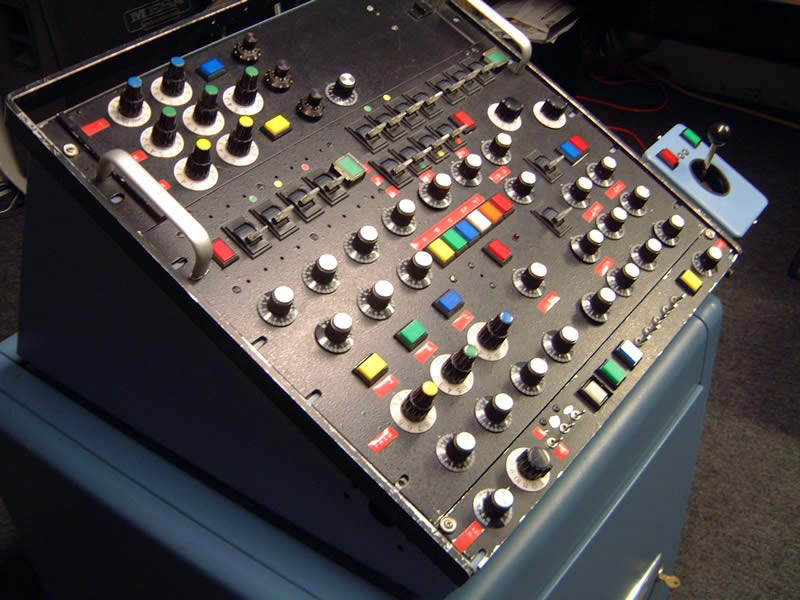
Laserium 600b console, by Josh Jacobson via Patrick McCray
Effect Number 1 - The Burn and Thrill
This was one of my FAVORITE techniques. I called it the BURN and THRILL move. Some soft music would start to be heard. The star operator would begin to slowly dim the house lights. A dramatic, rising synthesizer chord would begin to overlay the soft music, building dramatically in pitch and volume.I would begin a full white laser light burn effect at the center of the dome. The burn would start dimly and build in brightness as the chord built in pitch and volume. It took great talent to control the burn precisely, by hand with the laser intensity control. We were actually burning a piece of silver mylar with the white laser beam. At one and only one point the beam would burn so hot that there would be an explosion of white light starting in the center and expanding out to cover the entire dome. The trick was to time the explosion of the burn with the crescendo of the musical chord.
When the burn and sound were at their peak brightness and loudness, the star operator would quickly turn off all the dome lights and turn on the stars. Then, at exactly that moment, I would kill all the laser light coming from the LLS. At this point the audience would be instantly transported into another world, sitting in complete darkness under a magnificent star-filled sky and the room would fill with oohs, aahs, and applause.
The Burn and Thrill effect only took 30 seconds and was absolutely one of the greatest moments of every Laserium® show. It could only be accomplished by perfect preparation and coordination between the Laserist and star operator. It was these types of precise, live performance techniques that made Laserium® unique among all laser shows and the best in the world.
Effect Number 2 - The Lumia
Now that the audience had their first thrill of seeing the stars for the first time, it was time to calm them down and begin to transport their minds into a world that they had never seen before. We often incorporated some type of lumia effect to accomplish this.A lumia was basically a laser cloud made by passing the laser light through different types of molded and textured plastic wheels. A spectacular feature of the 4-color laser light was that each colored cloud, when displayed against the stars, looked as if it was deep in space and at a different distance from the audiences' eye. Red, yellow, green and blue clouds would not blend into each other. They would float at seemingly different distances in space, one above the other. It was a phenomenal 3D effect!
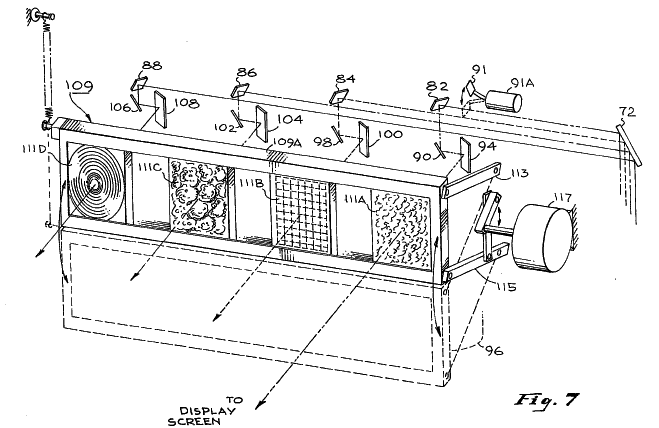
Non-rotating lumia, from the Laserium® patent 4,006,970. Four different types are shown.
There was a tremendous amount of artistry involved in displaying a lumia effect. First, realize the audience has only seen white laser light (the burn) so far. So the next step was to introduce the audience to the four colors of our laser. I always preferred to show them RED first. First, it was the most dramatic, romantic, thrilling color of all. Second because it did not cause the theater to be illuminated in any way. Now, 30 seconds into the show, with some soft, soothing music in the background, I started to show my audience their first glimpse of a magnificent red cloud floating in space above them.
At this point my mind was totally in sync with the music. I would translate what that music was saying to me by manipulating the brightness of the red cloud, the size of the red cloud, and the speed at which it moved. I could also use an effect called a "chopper" to make the cloud seem to shimmer on certain musical cues. Controlling each lumia effect took tremendous skill and control on the part of the Laserist. The most minute change in brightness, size, or speed of a lumia cloud would either translate the music correctly or not. Something as simple as this often separated the good and best Laserists from each other and had a dramatic effect on the reaction of the audience.
In my mind, I WAS performing a show IN SPACE... not in a planetarium dome. The minute the lights were turned off and the stars were turned on, my mind was in SPACE and my job was to make the audience believe that they were there with me. This transformation of reality could ONLY be accomplished in the planetarium environment with a magnificent star projector creating a realistic illusion of space. The same illusion could NOT be accomplished by using water, water vapor, a wall, flat screen, or even an Imax screen. Many people at Laserium® did not understand this and countless millions of dollars were wasted attempting to perform the show outside of the planetarium environment.
Sometimes, at this early stage of the show, I would only reveal the color red to the audience. I could perform an entire three-minute song by varying the look of a single red lumia cloud. The shapes that the cloud would evolve into were unlimited and constantly changing. Sometimes I would vary the intensity, or size, or speed of the cloud to match the shape it was transforming into. The goal of my every performance was to carefully, and continually surprise my audience, second by second, with beautiful light effects that they had never seen before, choreographed perfectly to what ever music was playing at the time.
Next Stunner = MOVE the STARS!
We were probably 3-4 minutes into a 45-minute show. We've blown away the audience by putting them into outer space. We've shown them a huge, white laser burn and a magnificent, sexy, soothing, stunning red cloud that changes shape endlessly. What is the next, simplest thing we could do to bring the audience to another level of excitement? You guessed it... Move the stars! As the next song started, the planetarium star operator got to thrill the audience by starting a VERY SLOW star movement. That's it. That is all it took to stun the audience into another round of aahs, oohs, and applause.At this point my job was to create laser effects to compliment the slow, dramatic movement of the stars. How about a very dim, slowly moving white laser dot gently moving through space. Guess what that looked like? A satellite! Very simple, very cool, and it got another round of applause. Now I added a second satellite, a third, and a fourth all moving slowly in their own elliptical patterns. Now I had the star operator bring the stars to a stop.
Dramatic change. My four elliptical patterns were centered at the center of the dome, in space above the audience. I began to move the dots faster and expand their size. When the dots moved fast enough, they each became a solid line, four of them, 45 degrees apart, centered on each other. Now they began to look like a giant spinning white atom in space. A round of applause. Now I slowly turned off the control that was making all the dots white and revealed four separate, spinning ellipses, red, green, yellow, and blue. A round of applause. As the music built, I made the four-color shape larger and larger, brighter and brighter until the shape filled the entire dome, enveloping the audience below. Yet another round of applause. Everything was building to a giant crescendo; the music, the size of the images, the brightness of the images, the excitement in the audience then BOOM!
On cue, I hit a camera flash that blinded everyone in the room and I killed all laser light. The star operator killed the stars. The music came to a halt. The audience was stunned and left in complete darkness and silence. Guess what? Another huge round of applause, of course.
At this point you should be starting to get the idea of the extreme level of control and dramatic effect that my actions, even the most simple, had on the audience in the altered reality that the planetarium dome and stars created. People had NEVER seen anything like Laserium® before. Laserium® was a BRAND NEW ART FORM that changed every second of every show BECAUSE it was performed LIVE and used ABSTRACT imagery. Nothing, in any two shows was the same. A person could see 100 Laserium® shows and each performance would be completely different from the last.
Also, each Laserium® performance was BETTER than the last because the Laserist LEARNED what worked and what did not work from the audiences' reactions.
An Extreme Variety of Effects
As the show progressed for its 45 minute term, there were hundreds, if not thousands of visual effects that I could present to my audiences. In my mind, the KEY to the success of my show was my mental focus that I was performing a gigantic light show in outer space, NOT a light show on the dome of a planetarium building.By visualizing outer space as my tapestry, I used elements such as image size variation, speed of motions, brightness of images, etc. to give the audience the illusion that they were witnessing something of colossal scope and size.
The Lumia Effect
For example, take a simple lumia effect. If the room's dome was my tapestry, it would not matter how fast a lumia effect moved. If, however, space was my tapestry, all my lumia effects would have to move very slowly, to simulate a massive light cloud, millions of miles from Earth. Again, with space as my tapestry, the farther away a lumia effect was from the audience, the dimmer it had to be. As I enlarged the size of the lumia effect, I made it brighter, giving the illusion that it was deep in space but moving closer to the audience.I NEVER used fast-moving lumia effects because to do so would eliminate the illusion of space for the audience.
Glenn's Patented Fade Out
One of my "patented" moves was the simple "Fade Out". Many times, as a song ended, I would fade an image into a deep space starfield by careful control of the image's size and brightness. I would take a single, simple scanned image (circle, square, triangle, spiral, etc.) and fade it into deep space so perfectly that the audience would be literally blown away. With stars as a background, as the music faded, I would make the image smaller and dimmer ever so carefully. Every eye in the crowd would be 100% focused on what I was doing. The crowd would become mesmerized and so silent that you could hear a pin drop in the room.At the last millisecond of sound the light would be so dim it could barely be seen. I would reduce the image's size smaller and smaller until its size matched the size of a distant star. When the sound stopped, the light disappeared and the crowd would go from dead silence to roaring applause! They were literally "blown away" by a fade out that, to them, seemed like a utterly realistic object disappearing into deep space.
Other Effects
I could write for hours about the various Laserium® effects in my Light Synthesizer arsenal. Here are just a few of them:- Spirals
- Digital cycloids
- Analog cycloids
- Chopper
- Color modulation 1
- Color modulation 2
- Lumia wheels
- Burn wheels
- Scan glasses
- …and more.
I literally spent thousands of hours practicing the creation of analog and digital cycloid images and spiral images. I would search for the perfect generator combinations to create images that best matched all selections of music in each show. I would write the settings for these images down in my performance notes. During shows I would start by referring to the numbers in my notes, but with repetition, would eventually memorize the numbers required to create each image in it's precise part of the show.
I had complete control over master image size, individual image size, all motor speeds, beam brightness, lumia brightness, the shape of each image, the color of each image, etc.
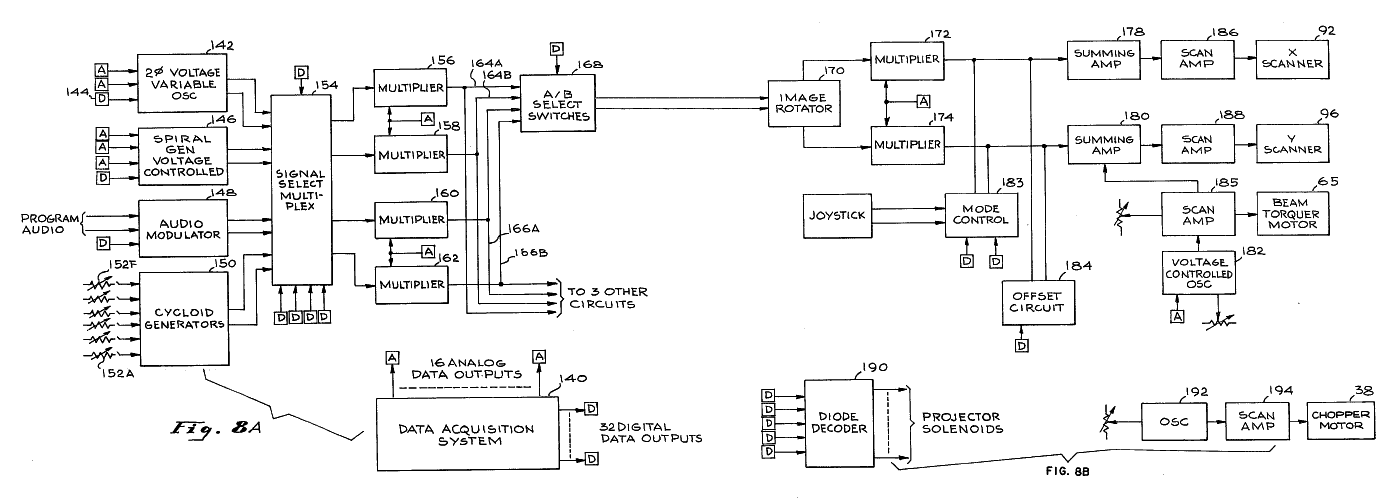
Block diagram of the console system, from the Laserium® patent 4,006,970.
The most important fact of all was that 90% of each Laserium® show was performed LIVE. Being live gave each show an entirely different look. The audience never saw the same thing twice and could come back to see limitless shows with complete fascination.
The Show Ends
The Laserium® show designers made a point of pacing the music and effects of each show for maximum effect. The last song in every show would be the "show stopper", a combination of the most exciting music and effects to properly send each audience out of the room in amazement.The Bow
At the end of each show, the room would go dark and the audience would begin their final applause. The planetarium operator would slowly bring up the dome lights and bring everyone back to the "reality" that they were in fact in a planetarium dome, not outer space any more.As the lights came up the applause would fade out and the planetarium star operator would ask for one more round of applause for tonight's laserist. This was the one and only, very brief moment of acknowledgement that each Laserist received for his thousands of hours of work to perform the world's greatest light show. Fame was not our reward. Job enjoyment was our reward.
Shutdown
When the last Laserium® show was over the planetarium staff had only one thing on their mind; close the planetarium building as soon as possible. Within minutes of the dome lights being turned up I always found myself peacefully abandoned in the planetarium dome. The pressure and enjoyment of performing the night's three Laserium® shows was over and it was time to shutdown the Laserium® projector system, laser, 220-volt circuit breakers, and water-cooling system for the night.I enjoyed this "alone time" tremendously. It was the only time I was left alone in the planetarium building. I loved the majesty and silence that surrounded me at Griffith Observatory at the end of each night.
Leaving Griffith Observatory
At the end of each night, I shutdown the Laserium® systems and passed back through the planetarium dome light lock into the main hallways of the planetarium building. The silence was ecstasy. Other than one planetarium technician shutting down systems in the building basement, I was alone in one of the most famous and majestic buildings on Earth, a privileged that I appreciated highly.I walked past the hanging pendulum in the main entryway which was now as motionless as everything else in the building. I pushed open one of the huge, art deco, steel and glass front doors and stepped onto the concrete front patio of the building.
Before me, the lawn, parking lot, and streets were transforming before my eyes. Where, an hour before, had been thousands of park patrons, not a soul remained. The park was empty of all human life but mine. An creeping fog was beginning to form on the mountain top. The fog was damp and quieted the sounds coming from the vast city of Los Angeles below me. One after another, deer popped out from the bushes and began walking around the lawn area. The smell of a skunk filled the air. Coyotes and raccoons appeared and began scavenging through the trash cans.
The sky above was clear. The stars were there but barely visible due to the immense light pollution from the city below. A yellow, crescent moon was setting in the West. I could see my lone motorcycle in the parking lot about the length of a football field away. I knew I'd have to get a towel out of my backpack to dry off the seat that was always wet with dew. In ritual fashion, I walked down the concrete steps, made a left turn and walked to the metal fence west of the observatory, overlooking the city below.
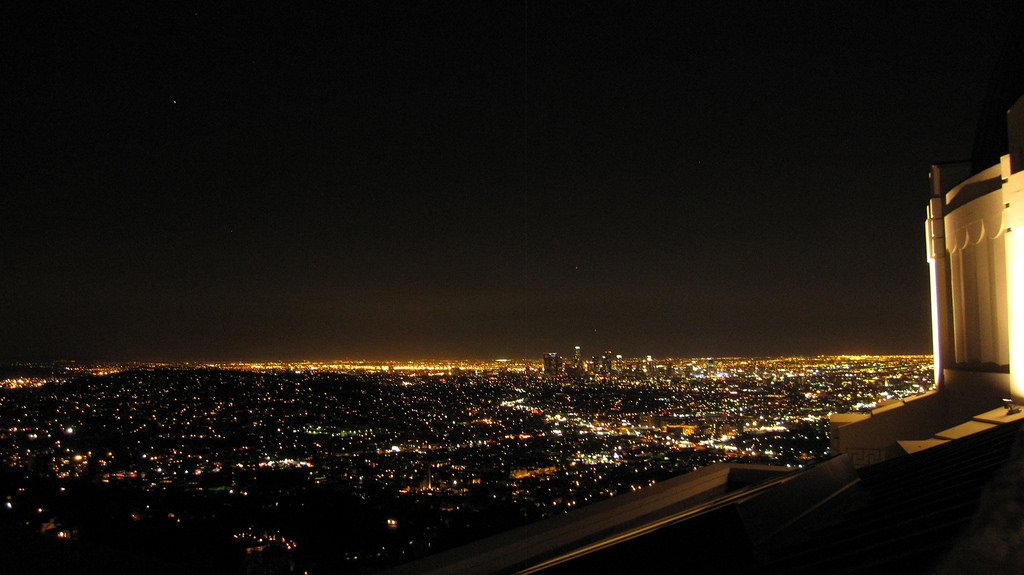
Griffith Observatory overlooking Los Angeles, by Ayleen Dority via Flickr, CC by 2.0
Every night, I paused at the fence for about a minute and thanked the Lord for the blessing of having the greatest job on Earth and the privilege of experiencing the beauty of these rare moments alone at Griffith Observatory. In a city of millions, I was alone, experiencing the joy of a lifetime.
There was one more very special experience ahead of me. After drying off my motorcycle seat, I warmed up the motor then began the dark and spooky ride down the mountain to the city below. All the park's street lights were turned off. The only light I had was the dim one from my motorcycle. Creatures of every type meandered on the empty roadway ahead of me. Glowing eyes of creatures hiding in the bushes watched my every move. The gate at the end of the roadway was shut and locked by the park rangers. Again feeling privileged, I stopped my motorcycle at the gate, got off and unlocked the chain with a key one of the park rangers had given to me. I walked my motorcycle through the gate and locked the chain behind me. Finally, I began my motorcycle journey home, passing millionaire's homes as I continued down the mountain to Los Feliz Boulevard.
Another wonderful night at work was behind me now. Every night, on the way back to the San Fernando valley, I thought to myself that being a Laserium® Laserist was truly the Greatest Job in the World and that I was one of the luckiest guys on Earth.
Pressures of the Job
At its peak, Laserium® had concurrent shows running in over 25 world locations at once. A crew of technicians from Laserium® corporate headquarters in Van Nuys, Ca would be sent to each city to install the Laserium® system in each location. Once each Laserium® system was installed it would be the Laserist’s job to maintain, repair and operate it. This required that each Laserist be both a musician and electronic technician and manage his life in a careful, responsible manner.
Personal Responsibility
Without the Laserist, there was NO Laserium® show. Therefore, the first pressure on each Laserist was to carefully manage his life so that he could reliably be at the planetarium two hours before the start of each day's Laserium® performances.The Laserist had to be an ultra-responsible person. He had to plan each day perfectly, making sure that all personal activities were completed in time to leave for the Planetarium. He had to monitor the traffic and weather reports and make adjustments to his schedule to compensate for varying conditions. He had to maintain a reliable form of transportation, be it motorcycle, car, or both. There was NO EXCUSE for not showing up to the job on time and in good condition to perform his duties.
One of the Laserist's field responsibilities was to hire and train a backup Laserist. This was an ominous task in itself, as you would know if you have ever been responsible for selecting and hiring any employee. Once a backup Laserist was hired, trained and able to perform all the duties of the main Laserist, the Laserium® show could go on despite any surprises that the main Laserist happened to encounter, including getting unexpectedly ill.
Maintaining the Laser
A second pressure on each Laserist was maintaining and repairing the laser and Laserium® projector. Of these two systems, the laser, a Spectra-Physics 1-watt krypton gas laser was the most troublesome item. It was a beast to keep running properly.It required a 3-phase, 240 volt, 100 amp dedicated AC power source, and a wide-open faucet with at least 60 lbs of water pressure to cool it. It was ultra-sensitive to voltage and water fluctuations. Any sudden change in voltage or water pressure would cause the laser to TURN OFF... not a good thing to happen in the middle of a Laserium® show performance with 650 paid fans enjoying the show. We actually had to install an air-pressurized water pressure bladder that would compensate for water pressure losses when the toilets in the planetarium were flushed. Each day, the Laserist would have to arrive two hours early to inspect and maintain the laser's water cooling system. The air pressure had to be correct in the regulator bladder and two water filters had to be inspected and replaced if dirty.
In addition to stable water and power, the krypton gas in the laser had to be kept at precisely the correct pressure to maintain a balanced output of red, yellow, green, and blue beams. Even the slightest miscalculation in gas pressure could cause the yellow beam to disappear completely. The Laserist had to become a master at maintaining exactly the right gas pressure in his laser.
The optical elements of the laser had to be precisely cleaned on a daily or weekly basis to maintain the highest laser output power. Cleaning of the laser optics was a critical skill that each Laserist had to learn to perform perfectly.
The Laserist's worst nightmare, literally, was having the laser shut off in the middle of a Laserium® performance. This happened too many times to each of us. At that fateful moment, the Laserist would have to maintain his composure, calmly ask the planetarium star operator to bring up some dim red back lighting and explain to the audience that a laser re-start was in progress. The Laserist would have to quickly determine why the laser shut off, repair it quickly, and restart the laser and the show. In most cases, we were usually able to correct any problem and restart the show. If we could not, the white lights had to come up and the audience had to have their money refunded, a nightmare for everyone involved in the show.
Replacing a failed laser was a HUGE task. Each of our lasers cost about $30,000 at the time [$150,000 in 2018 dollars]. Usually we could not afford to have two at each planetarium. So, when a laser failed the Laserist and his backup had to work all night to remove and box the failed laser. The next day they had to rent a truck to transport the failed laser to a shipping depot. While this was going on, Laserium® headquarters had to financially scramble to get a brand new laser shipped overnight to the planetarium. Once received it would take another whole day or night to re-install a new laser into the Laserium® system. Oh, as you can see, there were many PRESSURES on the Laserist and his backup.
Maintaining The Laserium® Projection System
The second critical element in presenting the Laserium® show was the Laserium® Projection System or Laserium® Light Synthesizer LLS. This was a marvelous piece of engineering. It was built in a modular fashion, utilizing replaceable circuit boards for the most part. Assuming the laser was behaving fine the LLS became the next critical element in successfully pulling off a perfect Laserium® show. As any complex instrument will do, the LLS would often have one or more parts or circuit boards FAIL during a live performance. Again, the strength, fortitude,, and technical knowledge of the Laserist would come into play to save the show.The better a Laserist was at electronic troubleshooting, the faster he could determine what had failed in the LLS and repair it. If the fix was simple, like swapping a circuit board, the Laserist could often perform the task during the show. If the fix was going to be more complicated, the Laserist would have to IMPROVISE his performance to make up for parts of the LLS that were not working properly. The ultimate goal was to NOT STOP the show and continue on so that the audience had no idea that anything was wrong. Great Laserists could pull this magic feat off often.
As you can see, a Laserist's job was full of pressures.
Rewards of the Job
Being a Laserium® Laserist was the GREATEST job in the world and had many rewards for me.
The biggest reward was that I made a living enjoying what I was doing... being an electronic technician and musician. I appreciated the fact that I was only one of about 50 people in the entire world who was lucky enough to be chosen to be a Laserium® Laserist. My work was unique, exciting, and fun beyond belief. The hours were great for me. I would wake about 10:00 am, catch a little sun on the deck, eat, shower, dress, take care of daily errands, then leave for work about 3:30 every day. Arrive at 4:30, fire up the laser, projector, and console, perform 6:00, 9:00, and 10:30 shows, shut everything down by about midnight, hit the town until 1:00 am, head home and crash about 2:00 am and repeat.
I loved learning NEW shows at Laserium® headquarters. I loved rehearsing new shows from midnight to dawn in planetariums all over the World.
I loved traveling to 20-25 cities for Laserium® to train other Laserists how to perform new laser shows yearly.
I loved performing for large audiences of 600-650 people at a time.
I loved the excitement of pulling off a critical new show performance in front of VIP audience members, Laserium® and planetarium management.
I loved the fact that I was premiering a brand NEW ART FORM to the public.
I loved seeing the most beautiful colors and never-before-seen images every day of my life.
Creating a New Show
Each new Laserium® show was created by a marvelous staff of people at Laser Images, Inc. in Van Nuys, California.
A show theme was chosen. A compilation of music was chosen. New visual effects were designed and engineered. A core outline of the show was recorded in the new show studio. Marketing art was designed and created. Brochures were created. In total, thousands of man-hours were put into the creation of each new Laserium® show.
Learning a New Show
Once a new show was created in the studio, a head Laserist would spend thousands of hours perfecting its performance in the Van Nuys rehearsal studio. Hour upon hour of rehearsal was spent on every minute of every song in the show. It was weeks before the head Laserist was able to play the whole show through, start to finish, without making an error.Once perfected with all show settings written down in a performance script, the head Laserist would plan to travel to each Laserium® city to teach the new show to each field Laserist.
Teaching a New Show
At one point in my Laserium® career, I had the distinct pleasure of traveling to all of Laserium's® field locations to teach new shows to our field Laserists. At its peak, Laserium® had about 25 field locations in operation, located all over the US as well as the UK, Japan, and more. It was a marvelous opportunity for the young me to travel the world.At each planetarium field location we would wait until the planetarium's evening schedule was completed, then begin training. Training usually ran from 11pm to 7am the next morning.
It was great fun working in a deserted planetarium building overnight. Many planetariums were located adjacent to museums. The Hayden Planetarium in NY, for example was located next to the New York Museum of Natural History. The London planetarium was adjacent to Madam Tussaud's Wax Museum. It was great fun, during rehearsal breaks, to walk through these adjacent museums, alone, in the dark in the middle of the night. Spooky and memorable beyond words.
The field Laserist had a challenging job because he had only one week of overnight training to learn enough to perform a new Laserium® show on his own. Everyone learned enough to get through a performance good enough to impress the audience. The greatest thing about Laserium®, however, was that, because the show was live, each Laserist would have the opportunity to improve his performance nightly!
Every Laserium® show got better as the weeks went by.
Memories of Ivan Dryer
Ivan Dryer is known as the Father of the Laser Entertainment Industry. Much has been written about him — but what was he like in person?
The Words of Scott Anderson
Scott Anderson, my friend and a brilliant Laserium® show designer said that describing Ivan was...quote...“really hard because he was so unique, and, of course, over the decades he changed, as we all do. He was always extremely nice and respectful and generated a great deal of good energy almost all the time. His challenges with (his wife) Carol’s and his own health complicated things for him quite a bit in the last decade and more.
"Ivan’s AMAZING relationship with Carol is important for all to hear. Did you know that EVERY Valentine's Day they re-married, or at least celebrated their anniversary in unforgettable ways. Ivan was so dedicated to her, and as a caregiver, you can imagine no harder task, since she was paralyzed in her lower body from multiple car crashes and surgeries in the early 2000s. He was there every minute for her. And (cool Laserium® trivia)... she did the voices of The Rainbow Makers in Crystal Odyssey.
"I will always think of Ivan with reverence and love, he made my dream a reality, and the fact that there are MILLIONS of people that also recognized how special and amazing Laserium® was proves that we were blessed to be working so closely with such an enlightened person. A man who took advantage of life in a way very few do. He made the world a better place, even if for just an hour, what an accomplishment!”
The Words of Linda Moen
Another good friend of mine was Linda Moen, Ivan’s personal assistant and secretary. She said “Ivan Dryer was, by far, one of the most brilliant men I’ve ever known. I was fortunate to also know a tender side to him. I saw how he handled situations at work and how caring he was with the people he surrounded himself with. I was mostly impressed by his generosity, and probably to a fault because I know some (people) who took advantage of his kindness. But mostly I loved how he loved his beloved wife, Carol Ann. For many years he was her full-time caregiver, taking a toll on his own health in the end. We spent many Valentine's Days with them as they reaffirmed their wedding vows, spent birthdays and other holidays with them right up to their final days on earth. Ivan may not have had an outwardly 'warm and fuzzy' personality, but inside the man was caring, sweet, and loving. That’s how I knew Ivan.”
We heard it from Scott, we heard it from Linda, and I think it is a point that Ivan would appreciate that we all remember today... His wife, Carol Ann Dryer meant the World to him and was a huge influence on his life and on Laserium®. God Bless them both.
The Words of Brian Wirthlin
I would like to take a moment to share the thoughts of another gentleman that I have the greatest respect for, Brian Wirthlin, who was our main Laserist at the McDonnell Planetarium in St. Louis. In 2013, three decades after Laserium’s last St. Louis show, on the 40th anniversary of Laserium’s first show, Brian single-handedly rebuilt an entire 6B Laserium system from scratch and performed another 74 highly attended and very appreciated shows at McDonnell Planetarium. Brian is a true Laserium rock star!
A quote from Brian... “Ivan was a hard man to know. He was a visionary, not an engineer. I never saw any evidence that he understood the technology that other people created to make Laserium® possible, but it was his passion that endured the less than successful early years that lead to that heralded day in November 1973 when Laserium® premiered at Griffith Observatory. The projector, built by Charlie MacDanald, with Ivan helping however he could, was finished the morning of that first show. That projector was stripped and the frame became an ungainly work table as newer much more capable and standardized machines were developed.
"Looking back it must have been hard for Ivan to even attempt to communicate with 'his' bunch of technology geeks. Looking back it sometimes seems as if Ivan suffered from impostor syndrome. His vision of what Laserium® could or should be was expressed in abstractions that held little meaning for his geeks. So we - the host of Laserium® geeks - ultimately learned and reinvented what we knew of Laserium® each night by listening to the audience and to each other.”
I have stop and take a minute to focus on what Brian just said... “We learned and reinvented Laserium® each night by listening to the audience.”
“Listening to the audience!”
Stop and let that sink in for a moment.
With absolutely no doubt, I believe that, other than revolutionary laser technology, the LIVE PERFORMANCE ASPECT of Laserium® was the PRIMARY reason for its success! Because it was performed live, we learned from the audience’s response to what we were doing and every single show got better and better, night after night.
Continuing with Brian’s thoughts … “Laserium® defined Ivan's business success, and his business failure - but Ivan was never actually in business - He had a vision where lasers were used to do something in a planetarium that would be transformative... and for a time — that's exactly what happened.”
My Personal Thoughts About Ivan
I had the honor of working for Ivan for 26 years but did not communicate on a personal level with him very often. To me, Ivan seemed to exist in a mental and spiritual world that was higher than my own. His mental capacity was so great that I often felt uncomfortable speaking with him. He was very intimidating to me.
First of all, he towered above my own six-foot height by many inches, he was “Hollywood thin”, always well-dressed, was very quiet, distinguished, and always very composed. His voice was soft, calm, and very authoritative. His eyes always seemed to look right through me. Ivan seemed to be thinking so far beyond what I was thinking that it was nearly impossible for me to hold a normal conversation with him.
Ivan was Laserium®’s leader and inspiration. He was the lead creative force of the entire company. For 28 years he planned, directed, and helped create every Laserium® show. In addition to running a corporation with many employees and shows in dozens of planetariums, he worked side by side with the Laserium® show design staff, picking show themes, show music, and choreographing the outline of every laser effect.
I said outline because, at first, Laserium® was a totally live performance of abstract imagery. There was a data track, synced to the music, that controlled the type of image shown, turned beams on and off, changed image sizes, etc., but the guts of every performance was created and performed LIVE by a Laserist after hundreds of private, imaginative and creative rehearsal hours.
Ivan assembled a staff of brilliant artists and engineers to create an amazing laser instrument to bring his dreams to life. The company called it the 6B. I liked to call it the LLS ( Laserium Light Synthesizer). It featured over one hundred and fifty knobs, switches, and dials that each laser artist could use to create his very own interpretation of each show’s sound track. I saw it as unique and newly-invented instrument of light... a light synthesizer.
Great sound tracks, a four-color krypton laser, a planetarium dome, a classic Zeiss star projector, a spectacular surround sound system, an exceptionally-talented laser artist, and unique and always improving abstract imagery were the many elements that combined to create the highly successful, and lost-forever artform that we all fondly remember as Laserium®.
Ivan was a brilliant and distinguished gentleman, an artistic genius, and a visionary that was years ahead of his time. We respect him so greatly that we call him “the father of the laser entertainment industry”. He created a circle of brilliant people around him. He was passionate about his purpose. He never stopped trying to make Laserium® succeed and he never left the side of the woman he loved so dearly.
Finally, at the end of his life, he gave everything, including all of his money and, ultimately, his health trying to care for his wife Carol, keep Laserium® alive, and bring the joy of music and laser light to the World.
Over 20 million people experienced Laserium® thanks to Ivan Dryer. God bless him and his wife Carol. May they both be reborn again to continue their mission of spreading the JOY OF LASER LIGHT TO THE WORLD
Laserium® - A Lost Art Form
I truly believe that Laserium® is a LOST ART FORM. Live show performance by a Laserist on a Laser Light Synthesizer was a new and unique art form that had never been seen by anyone in the world. I don't believe the world recognized Laserium® as a new art form, as I did. Even Laser Images Inc. themselves, having switched from live to computer-animated laser shows, did not realize that they had destroyed their new and unique abstract and art form.
I believe that, at some time in the future, someone will remember that being abstract and being performed live were the features that made the original Laserium® a true art form and re-create them again.
I believe that at some time in the future, someone may build another laser light synthesizer, producing abstract imagery, that is played live to music and start this art form over again.
Until either of these happen, I am satisfied that I've at least recorded my thoughts on what being a Laserist was all about.
What Made Laserium® a Success?
In my mind, these are the things that made Laserium® a success:
- The beautiful 1-watt, 4-color Krypton gas laser of course
- The Laserium® control and projection system which was the first and finest of its kind
- The planetarium dome
- The magnificent Zeiss start projector
- The spectacular surround sound system
- The spectacular architecture and location of Griffith Observatory
- The spectacular employees of Laser Images Inc.
- The management and support of all the planetarium employees
- The Laser Artist (Laserist) that performed each show live
- The use of ever-changing ABSTRACT imagery
- and most important, the loyal fans who returned dozens of times to experience a new show every night.
What was Laserium's® Downfall?
There are, no doubt, dozens of theories of why Laserium® lost its popularity after 25 years.
This is strictly MY OWN opinion.
I believe the DOWNFALL of Laserium® began when Laser Images Inc,. switched from beautiful, never-before seen abstract images that were created LIVE and were absolutely DIFFERENT from show-to-show to computer-generated semi-realistic cartoon images that were recorded and were THE SAME for every show. As a performing artist, I cringed when the engineers started dropping recorded computer images into my shows. It made every show "the same". It became boring. It simply ruined the beautiful, always new and changing abstract images that were the heart of my shows.
To me the KEY to Laserium's® success was showing every audience beautiful, unique, abstract images that they had never seen before and that were DIFFERENT for every single show.
A fan could watch the same Laserium® show 100 times and never see the same images when the shows were live and the images were abstract.
Once a single, computer-generated image was recorded and put in the same spot in the show, every show became THE SAME for the fan.
What I Would Have Done to Maintain the Laserium® Artform
Just for fun, if I had unlimited financial resources, this is what I would have done to maintain the Laserium® artform so that it would have been still with us today.
First and foremost, I would have promoted and established Laserium® as a BRAND NEW ARTFORM performed by a new kind of artist, a Laserist.
I would have promoted Laserists as if they were superstars, not kept them hiding in obscurity in a little booth at the back of the room.
I would have developed the Laserium® Light Synthesizer ten fold over what it was, giving the Laserists more capability than they could imagine.
I would have promoted Laserium® performance competitions where the audience would have had the chance to see the same song played totally differently by multiple Laserists.
I would have insisted on maintaining the LIVE performance method of presenting Laserium® and totally banned everything but the show's critical background data recordings.
I would have banned all computer-generated imagery that tried to represent realistic imagery of any kind. I would never permit a show to have the same, repetitive image in every show. All my Laserium® shows would have to be different each night and composed solely of abstract imagery.
I would have promoted computer-generated imagery that was ABSTRACT and changed with every show.
I would never have wasted time and money trying to perform a Laserium® show in any venue other than a planetarium because I knew very well that ONLY the planetarium environment worked.
I would have worked tirelessly to build and maintain excellent relationships with all planetariums in the world.
If planetariums all decided to ban laser shows in favor of star shows, I would have purchased or built my own planetariums and hired my own staff to produce star shows.
I would have maintained the use of the original Zeiss star projector in my planetariums. It was truly the best and most realistic star projector ever built. I would have built a "pit" for the projector to disappear into for added effect.
I would have built my planetarium domes out of a solid, light-reflective, non-vibrating material, similar to the plaster used in the original Griffith Observatory.
I would have built an unrivaled sound system in my planetariums. I would never have played it TOO LOUD but I would have played it loud enough to create the dramatic effects that a large dynamic range produces.
I would have installed the most comfortable, reclining seats, in a 360 layout in all of my planetariums.
I would have put a Laserist, a backup Laserist, and a technician in each Laserium® location. That way the Laserists could have focused strictly on their performance skills and the technician could have focused on keeping the equipment running and perfectly tuned.
Conclusion
I hope that this book has provided you with a valuable look at the Greatest Job on Earth, being a Laserium Laserist.
It may be appreciated by the thousands of Laserium® fans who attended our shows over our 28 year performance run.
It may be appreciated by technicians and engineers who are fans of the laser light industry.
It may be appreciated by musicians and artists who realize that Laserium® was a new Art Form that was never recognized, thrived, then perished without notice.
It may be appreciated by creative entrepreneurs who may realize that, with the proper financial backing, right selection of personnel, and correct management decisions, the Laserium® Art Form could be re-created and become successful in the planetarium of the future.
It may be valued as a simple record of what the Greatest Job on Earth, being a Laserium® Laserist, was all about.
In any case, this story was a pleasure to share with you all.
For more information, visit our other ILDA websites:
© 2007-2025 International Laser Display Association. All rights reserved.
Contact ILDA
No reproduction of the text or images on ILDA websites is allowed without written permission of ILDA or other copyright holders. "ILDA" and the ILDA logo are trademarks of the International Laser Display Association.
This site does not use cookies and does not track or gather information on individual visitors. Aggregate information is gathered by Google Analytics to determine overall visitor behavior. More information is on our Privacy Policy page.
Cover photo courtesy Glenn Thomas



